Inbox and environment news: issue 612
February 4 - 10, 2024: Issue 612
Dog Attack Kills Another Wallaby In Our Area: NBC Council LGA Tops Dog Attack Statistics In First 2023/24 Statistics Reported
(The following is a first hand account from a local offshore resident - this news item was first run in the West Pittwater Community Associations' News, December 2023)
Late in the afternoon on Thursday 30 November, 2023 two local lads rescued a wallaby and a dog from a channel in the Bays. It appeared that the dog – a roaming animal that belongs to a local family – was pursuing the wallaby through the water.
The dog was returned to its owners and the wallaby was taken ashore and released. It was low tide at the time. However, instead of heading for the relative safety of the bush, the wallaby followed the shoreline west toward another bay. It is very likely that it was frightened, exhausted, and disoriented by this time.
A little later, and not far from the rescue and release operation, another locally known roaming dog was seen dragging a wallaby carcass on the low-tide sand flats. Upon inspection, it was determined that the wallaby was a healthy buck that was only recently dead and fully wet from being in the water. Its head had been partly devoured by the dog however, the rest of its body appeared unscathed.
We don’t currently have data on how many dogs live part or full-time in the Bays, but they are numerous and their number seems to be increasing. Unfortunately, some of these dogs are not restrained, properly supervised or trained.
In addition to the obvious trauma to our protected wildlife, the consequences of careless dog ownership can also be destructive to the fabric of our community; for example, other dog owners are often emboldened to behave in similar ways, thereby creating and/or exacerbating neighbourhood frictions; wildlife-attacking dogs may develop a ‘taste’ for the rewards and their behaviour can shift from opportunistic to deliberate stalking and/or killing; and frustrated residents may decide to take dog-control matters into their own hands, which can create its own set of escalating problems.
The above account ran after a July 2023 record, first run in the West Pittwater Community Associations' News, of another wallaby being attacked, this time at Lovett Bay.
The carcass of young female wallaby (perhaps 12-18 months old) was found at the base of Tarrangaua’s driveway near Lovett Bay Wharf on the morning of Friday 30 July. It appeared to have been attacked by a predator, as its throat, most of its jaw and part of its head were missing. Those who found the wallaby were unable to determine exactly what killed the wallaby, or when and where the attack took place.
The wallaby’s death was reported to the Northern Beaches Council Animal Management team and National Parks and Wildlife.
''While we don’t have hard evidence that the wallaby was killed by a dog (or dogs), at this point a dog attack seems the most likely explanation.
Please ensure that your dog remains under your control at all times, as per the Council regulations. As in, when the dog is off-leash, it remains within the boundaries of your property. And when the dog is not within the boundaries of your property, it remains on-leash.'' those who found the wallaby stated
West Pittwater Community Associations' News Editor’s note: National Parks and Wildlife Ranger Luke McS.... says that while the wallaby carcass would need expert examination to determine how the animal was killed, it is probable given the location that a dog rather than a fox was responsible. Luke made the point that with fox baits now in place in Ku-ring-gai National Park (see the NPWS notice below for details) dog-owners have even more incentive to keep dogs on-leash.
“If a domestic dog does take a bait, there is no antidote and it is lethal,” he said. “The inadvertent killing of a domestic dog (terrible in itself) can also put a critical pest management program at risk of being discontinued, which will have serious negative conservation outcomes for native fauna, particularly threatened species which this control program is designed to protect.” The onus is on dog owners to ensure that their dog or dogs are not a nuisance and do not pose a threat to anyone or anything. If you witness a dog roaming or otherwise acting contrary to council regulations (see excerpts below), and its owners do not immediately act to rectify the issue, please report it to Northern Beaches Council.
The deaths of these two wallabies are among others that have been sent into Pittwater Online. At 9.40am, Sunday March 12, 2023 a resident witnessed 2 offleash dogs attack and kill a water dragon behind a home in Wesley Street, Elanora Heights - Narrabeen.
The two dogs then continued into the reserve, ''clearly on the hunt for more wildlife'' the resident stated.
Residents are also sending in photos of offleash dogs chasing wildlife on our beaches - every week emails come in with photos of dogs with their owners in no dogs areas.
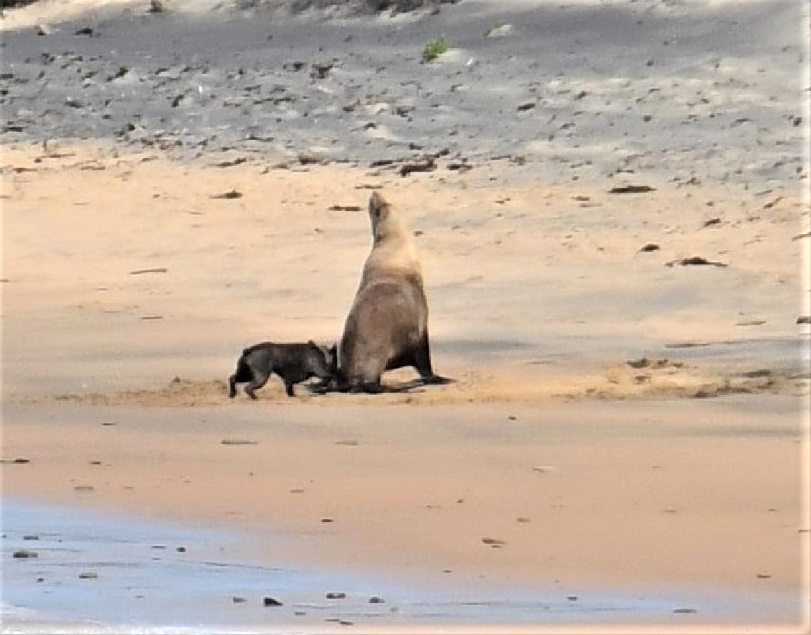
Our area has a number of WPA's (Wildlife Preservation Areas) to ensure resident and seasonally visiting wildlife may live and raise their young in peace and safety.
Just as frequent are dogs attacking local children while they play on beaches, sportsfields, or are simply walking around their neighbourhood.
The area has 29 dog-off leash areas. These range from the shared use of sportsgrounds, to fully fenced dog parks and foreshore reserves. Five of these are great if your dog likes to get wet or have a swim: Sandy Bay, Clontarf - Rowland Reserve, Bayview - Curl Curl Lagoon, North Curl Curl - Lagoon Park, Manly - Progress Park, Narrabeen (Mullet Creek).
The first quarter of statistics for the Northern Beaches Council area on dog attacks (to September 2023) records there were 65 attacks in this LGA - 2 more than Central Coast Council area that has twice as many dogs (156,443 registered dogs compared to 71,528 for NBC) and numerous offleash areas, and the highest across all metropolitan councils by a big margin for that quarter, with only Shoalhaven Council recording more with 71 attacks.
The Shoalhaven Council LGA is where 90-year-old Ada Holland was killed through a dog attack while walking along Collingwood Beach in March 2020.
In mid 2022 Central Coast Council, released for feedback its Dogs in Open Space Action Plan, which has since been adopted. The Central Coast had regularly topped the number of dog attacks in its LGA each quarter.
The Dogs in Open Space Action Plan proposed a winding back of dogs having off leash access (OLA) to decommission/relocate 6 OLAs, designate 13 additional OLAs in places where they will not impact on others, and modify the boundary of 10 OLAs.
That council does not allow dogs on sportsfields because of the conflict between sporting activities and dogs off leash, damage to the sports surface caused by dog urine and digging, dog litter not being picked up by dog owners, and general wear associated with dogs running to and from owners gathered on the sports field.
The decommissioning of some access to beach areas by dogs off leash was to mitigate what has evolved, specifically in off leash unfenced areas, where research has shown that the CCC have 'Dog owners who are of the opinion that they and their dogs have priority access to the space, and other people are a secondary user'.
In October 2021 Pittwater Online spoke to a mum whose toddler had been run over by a wet off leash dog at the proposed south Mona Vale beach site, and was one of numerous large dogs present. She was told that ''if she didn't like it to stay away, this is a dog beach''.
South Mona Vale beach is not an area where any dogs are currently allowed.
Another suggested she take her toddler to the north end of Mona Vale beach, a place too far for a toddler to walk to.
As well, Mona Vale residents find dogs off leash right along that beach now. Instances of dogs running up to and jumping on people, strangers, emerging from a swim are common and frequent at the north end of the beach and in the Mona Vale Basin, resulting in scratches, bites and taking away that place as a safe space for small children as well.
Menzies Institute for Medical Research stated a few years ago that ‘injuries due to dog bites are a largely unrecognised and growing public health problem’ and estimates that over 100,000 people are bitten by dogs in Australia each year. Twelve to fourteen thousand incidents require medical attention, and 1,200-1,400 incidents require hospitalisation.
The Central Coast Council's extensively researched document on what was occurring in their own LGA listed among the Challenges with on leash only areas:
- Owners letting their dogs off the leash in breach of leashing regulations resulting in the (same) additional challenges associated with off-leash areas
- Dog owners not being respectful of other users on trails and footpaths and appropriately controlling dogs (e.g use of extension leads)
Their DIOSAP also proposed that in line with the CAA (NSW Companion Animal Act, 1998), and to preserve public amenity and address risk management issues, that:
- dogs be excluded from patrolled beach areas and for 20m either side, including sand dunes extending to the waterline as a minimum
That Council is also responded to their residents calls to address the impacts on wildlife off leash dogs are having in their LGA.
The first benefit, the number one, listed for their proposed Dog Exclusion Areas is:
- Significantly reduces the impact of dogs on sensitive flora and fauna habitats. In particular on foreshore bird nesting sites where vulnerability to nest disturbance and potential predation is high.
Remember when Pittwater had birds nesting on our foreshores? Birds in the trees alongside all our playing fields until just a few years ago? Wallabies bounding through the bush?
That local record for the 2023/24 by quarters total to September 2023 for the Northern Beaches LGA comprises 9 people in what is defined as serious attacks(where the injury resulted in medical treatment, hospitalisation or death), 28 were attacks on people deemed less serious.
The total animals attacked is listed as 45.
The NSW Wildlife Rehabilitation dashboard (Wildlife rehabilitation data current to 30 June 2022) records 5,379 animals rescued in this LGA over the 2021/22 recorded period and 1,423 rehabilitated enough to survive and be released.
Those numbers record 3,956 did not make it.
Of of the 99 wallabies recorded just 7 were released.
Of these 44 came into care as the result of a dog attack, with 2 of threatened species among the 19 species attacked - 19 birds, 13 mammals and 12 reptiles. Just 13 survived to be released.
There were a further 105 attacks on wildlife recorded as having been caused by cats, and 36 listed as 'suspected attack/other'.
Across the whole recorded data period (June 2013 - June 2022) there have been 1,588 dog attacks on 94 species in this LGA - 475 animals were released.
This list comprises 911 mammals, 447 birds and 230 reptiles - possums and bandicoots have been the most impacted. Geese, swans, ducks, terns and gulls are also listed as victims of dog attacks in this area.
Those that were found already deceased due to a dog attack are not listed. There also growing evidence that many of these attacks on wildlife go unreported.
A January 2024 report states:
''You might think it’s harmless for your dog to chase wildlife if it never manages to catch the animals it chases, but that isn’t true. Wild animals optimise their behaviours to meet their needs for foraging, breeding and resting, and being chased by a dog can disrupt this.
For example, certain threatened bird species will nest on the beach and find foraging opportunities based on the tides. One dog forcing one bird to abandon this important activity may have a small impact. But if it happens repeatedly throughout the day, it can become a much bigger problem. It may even drive animals out of the area.
Research conducted in Sydney has shown the mere presence of a leashed dog is enough to temporarily, yet dramatically, reduce the number of bird species detected.''
Council's website advises;
Dogs who bark incessantly, roam and are aggressive are deemed a nuisance. A nuisance order may be issued if your dog repeatedly roams the neighbourhood, makes noise, defecates on peoples’ property, chases a person, animal or vehicle or damages property.
The law requires that your dog must be under effective control at all times and that you dispose of dog poo in a suitable manner.
The most unacceptable behaviour from dogs is aggression toward humans or other animals. As a dog owner, you are responsible for your dog’s actions.
The maximum penalty if a dog rushes at, attacks, bites, harasses or chases any person or animal, whether or not any injury is caused to the person or animal as a result of a reckless act or omission by the dog’s owner or another person in charge of the dog at the time of the attack is $22,000.
A restricted dog or declared dangerous or menacing dog to attack, bite, harass or chase any person or animal (other than vermin), whether or not actual injury is caused, carries a maximum penalty of $77,000.
However, if the matter goes to court the costs can be much higher. See: Sydney Dog Attack Victim Awarded $225, 000: July 2022
Council states dog attacks are taken very seriously and urges residents to report them immediately on 1300 434 434.
More information on how to report dog attacks to council is available at: www.northernbeaches.nsw.gov.au/community/pets/dogs-and-cats
You can report roaming offleash dogs to council, anonymously should you choose, at: help.northernbeaches.nsw.gov.au/s/article/Roaming-Dogs
If you find a dog you don’t know wandering off leash, you can report a found dog to Council and a Ranger can come and scan the dog for its microchip details collection - or perhaps take it to the nearest vet which may know the dog and its owners. If the dog is collared and has a tag you could call the owner yourself so the pet gets home safely. If you could contain the dog safely and provide water until its owner turns up, that will help that dog.
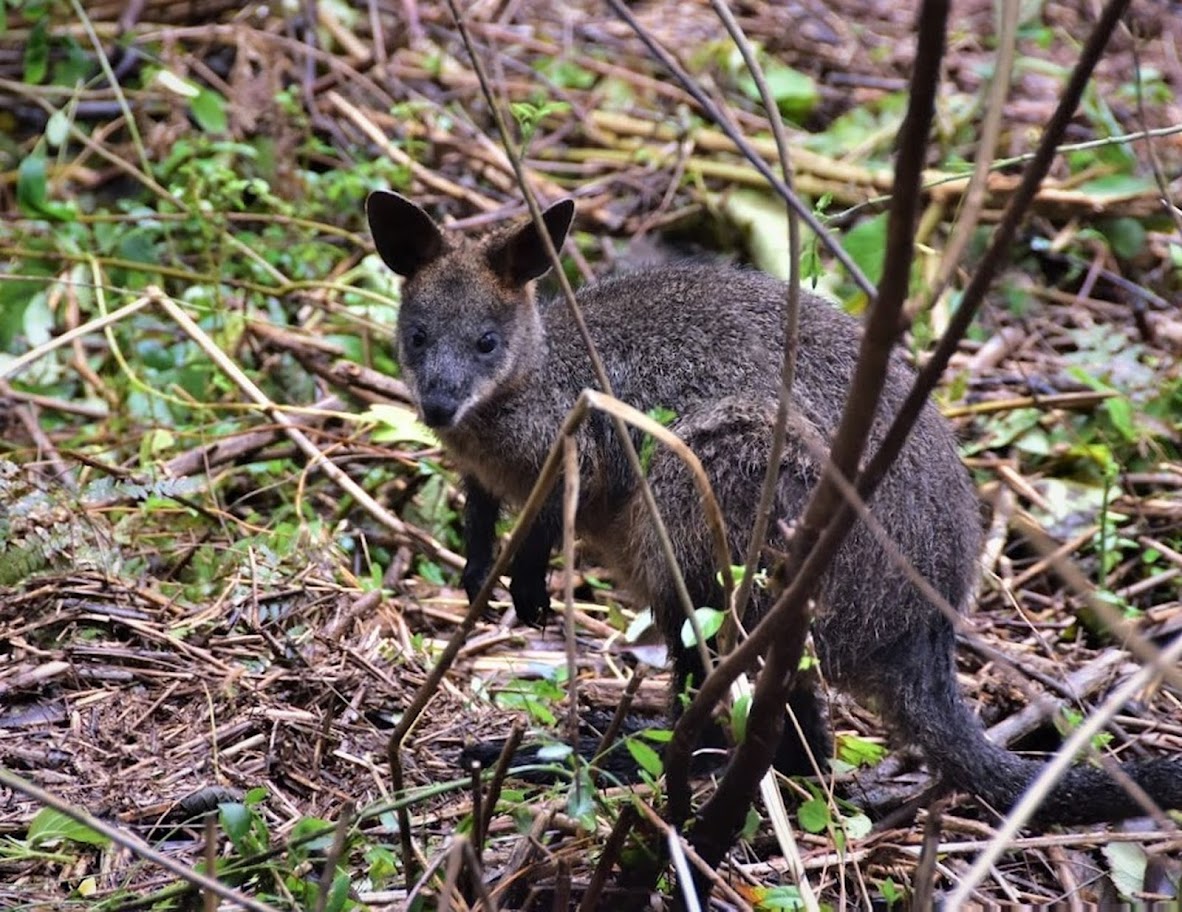
Photo: Young Wallaby in Warriewood, March 2022. Photo supplied.
Notice Of 1080 Baiting: February 1 - July 31 2024
Please note the following notification of continuous and ongoing fox control using 1080 POISON with ground baits and canid pest ejectors (CPE’s) in Sydney Harbour National Park, Garigal National Park, Ku-ring-gai Chase National Park, and Lane Cove National Park. As part of this program, baiting also occurs on North Head Sanctuary managed by Sydney Harbour Federation Trust and the Australian Institute of Police Management facility at North Head.
This provides notification for the 6 monthly period of 1 February 2024 – 31 July 2024.
Warning signs are displayed at park entrances and other entrances to the baiting location to inform the public of 1080 baiting.
1080 Poison for fox control is used in these reserves in a continuous and ongoing manner. This means that baits and ejectors (CPE’s) remain in the reserves and are checked/replaced every 6 – 8 weeks.
1080 use at these locations is in accordance with NSW pesticides legislation, relevant 1080 Pesticide Control Orders and the NPWS Vertebrate Pesticides Standard Operating Procedures.
A series of public notifications occur on a 6 monthly basis including; alerts on the NPWS website, public notices in local papers, Area pesticide use notification registers and to the NPWS call centre.
If you have any further general enquiries about 1080, or for specific program enquiries please contact the local NPWS Area office:
For further information please call the local NPWS office on:
NPWS Sydney North (Middle Head) Area office: 9960 6266
NPWS Sydney North (Forestville) Area office: 9451 3479
NPWS North West Sydney (Lane Cove NP) Area office: 8448 0400
NPWS after-hours Duty officer service: 1300 056 294
Sydney Harbour Federation Trust: 8969 2128
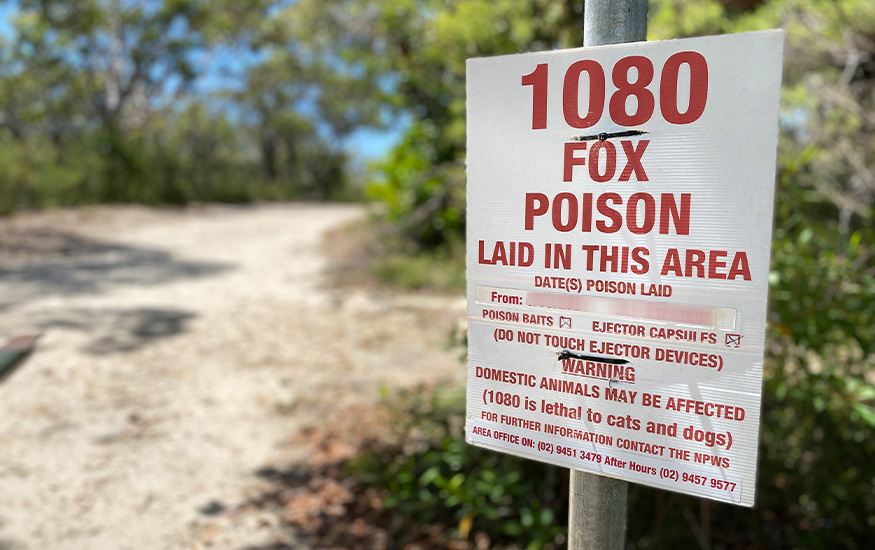
Pittwater Natural Heritage Association: First PNHA Nature Event 2024
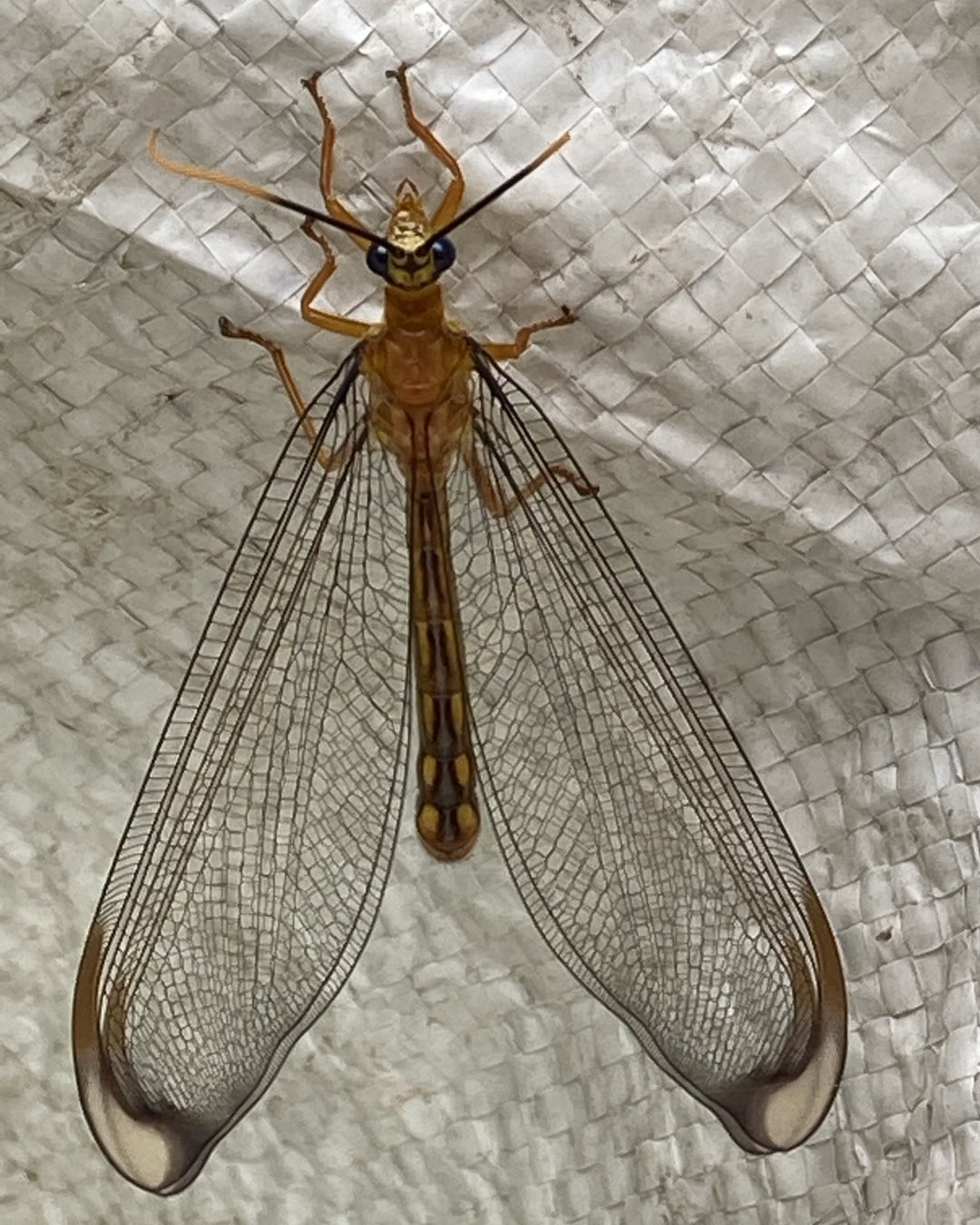
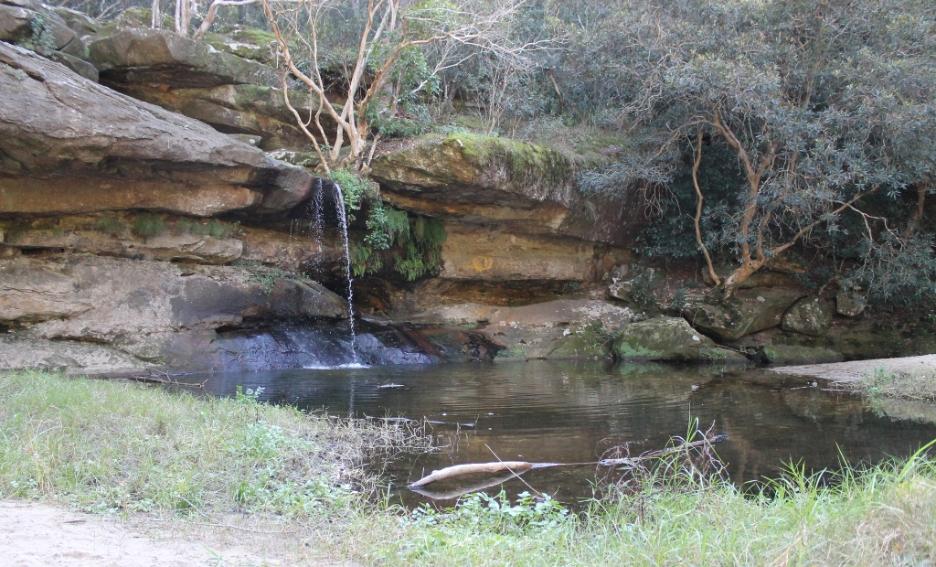
Securing Koala Survival: Appin Road Wildlife Crossings Fall Short, Urgent Need For Overpasses
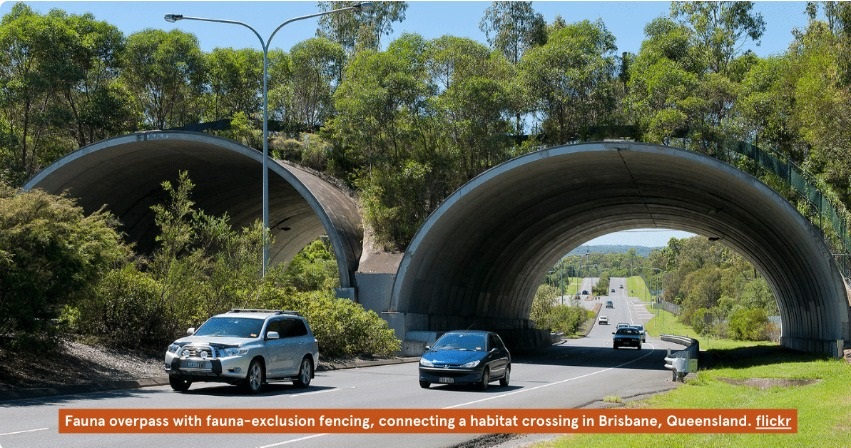
We once killed 600,000 koalas in a year. Now they’re Australia’s ‘teddy bears’. What changed?
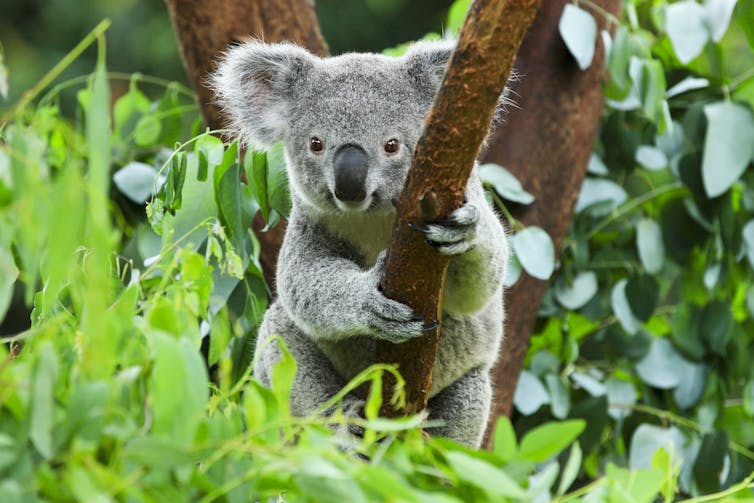
Koalas are one of the world’s most beloved animal species. They serve as symbols for everything from bushfire destruction to Australian tourism to caramel chocolate bars. These tree-dwelling marsupials get far more attention than many other endangered native species. But Australians haven’t always felt this way about our seemingly cuddly teddy-bear lookalikes. Far from it.
Almost a century ago, Queensland announced open season on koalas. Over the next month, well over 600,000 koalas were shot, trapped or poisoned in what has been dubbed “Black August”.
These numbers seem shocking. That figure is about the same as the total number of koalas alive today, using the most generous estimate. Today, the koala is endangered in New South Wales, Queensland and the Australian Capital Territory.
Why did it happen? Back then, koalas were far more plentiful in Queensland. And there was an established tradition of killing Australian marsupials for their pelts, which could be sold on the lucrative international fur market. At least a million koala pelts were sold in the previous 1919 open season.
As attachment to native wildlife has grown and the koala’s numbers have dwindled, we have come to think very differently about this creature.
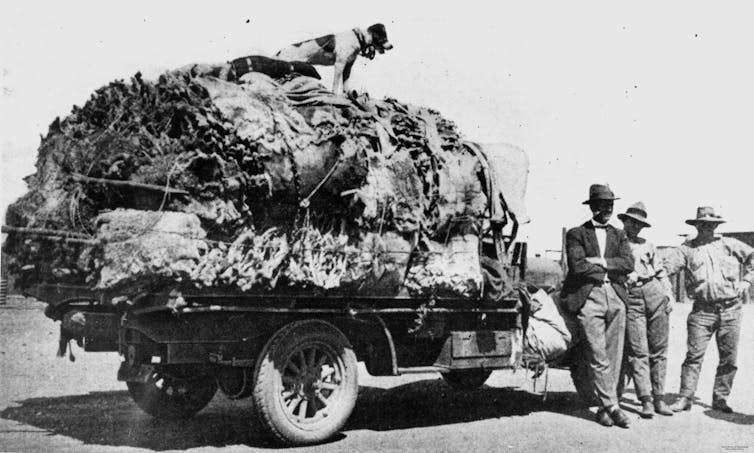
A Political Miscalculation
Even in 1927, the koala kill was a gamble. Other koala-inhabited states had stopped licensed koala kills, alarmed by plummeting numbers caused by the fur trade, deforestation, bushfire, and disease. As early as the 1880s, worried locals shipped koalas to French Island near Melbourne as an insurance policy against fire and disease. Today, as historian Danielle Clode has written, koalas in South Australia and Victoria are largely descended from these island refugees.
So why did Queensland launch its kill? The economy was not doing well, and the Labor government hoped the open season would tackle high unemployment rates, raise revenue and win votes. Warm, waterproof koala fur was prized in Europe and the United States, where it was put to use in coats, gloves and even sleeping bags.

But the open season came as a shock to many. Scientists knew koala populations were already plummeting at the beginning of the twentieth century. And among the public, affection was growing for the koala.
The backlash was swift – and intense. Brisbane’s Anglican Archbishop Gerald Sharp called for protest, and a remarkable range of organisations responded, from city and shire councils to religious groups, women’s organisations, universities, scientific bodies, returned soldiers and children’s scouts groups.
The Brisbane Courier newspaper ran a “Spare the Bear” campaign, publishing hundreds of protests from indignant readers. Angry constituents deluged the acting premier, William Forgan Smith, with letters. Some deplored the cruelty of hunters who left baby koalas attempting to suckle from their dead, skinless mothers. Others focused their anger on the government. One caustic letter writer suggested an “open season for Cabinet Ministers” might be more appropriate.
Critics were united in their disgust at the mass killing of such a “lovable, non-destructive and quite unique little native animal” which posed no threat to human interests. Koala trappers had their masculinity questioned – no “true Bushman” would kill a defenceless animal.
We should be sceptical about one letter writer’s claim that “99% of Queenslanders” opposed the killings. But opposition was powerful and widespread.
The government tried to blame the furious response on out-of-touch city dwellers who did not live in Queensland. In fact, locals dominated the protests. At the time, many rural families kept koalas as beloved pets, which made the thought of killing them even more outrageous.

A Question Of National Identity
When British colonists first came to Australia, many found the native animals freakish and backward. One unimpressed naturalist called koalas “torpid and senseless” and doubted their place in “God’s plan”.
But by the early 1900s, koalas, emus and kangaroos were becoming national symbols. They seemed to represent Australia’s new status as a federated nation, and helped settlers feel connected to the land. There was also a growing awareness that native species needed protection from environmental threats.
Books such as Norman Lindsay’s Magic Pudding (1918) encouraged readers to care for native animals. In 1925, James Barrett published a book begging for the “right use of our flora and fauna” and stressing their endangered state. He titled it Save Australia.
Perhaps because of their baby-like features, koalas were often depicted by authors and illustrators as good-natured and childlike friends. (In reality, they can be quite grumpy and their screams at night startle many campers). This might explain why fewer people protested to protect possums, the furs of which were also sought during open seasons.
The Great U-Turn
The 1927 koala open season would be Australia’s last. After the backlash, the koala was finally afforded lasting protection in Queensland. The acting premier promised to restock areas stripped of native animals. Even so, the government lost the election it had been trying to salvage.
Hundreds of thousands of koalas were killed before the government reversed course. Newspapers reported an estimated 600,000 koalas died due to the “massacre”, but this doesn’t account for koalas whose skins were not sold to dealers or young koalas killed with their parents or who starved without them. The total is likely close to 800,000.
The movement against koala-killing was perhaps the first organised conservationist campaign in Australia. It fostered the creation of wildlife societies, campaigns for national parks and nature studies for school students.
You can see the evidence even today. Sydney man Noel Burnett was so appalled by the killing that he opened his own sanctuary, Koala Park, which is still operating.
And whenever news breaks about koala deaths in blue gum plantations, we respond with outrage.
New Threats, Old Choices
Today, koalas are safe from hunters. They’re so well known we use them as cuddly diplomats, similar to China’s panda diplomacy. But they face new threats – increasingly severe bushfires, disease, and habitat destruction.
Even as we have grown to love koalas, we have not yet been able to save them. It is now entirely possible these beloved national symbols could be facing a preventable extinction. ![]()
Ruby Ekkel, PhD student in Australian History, Australian National University
This article is republished from The Conversation under a Creative Commons license. Read the original article.
Clean Up Australia Day 2024 Registrations Are Now Open
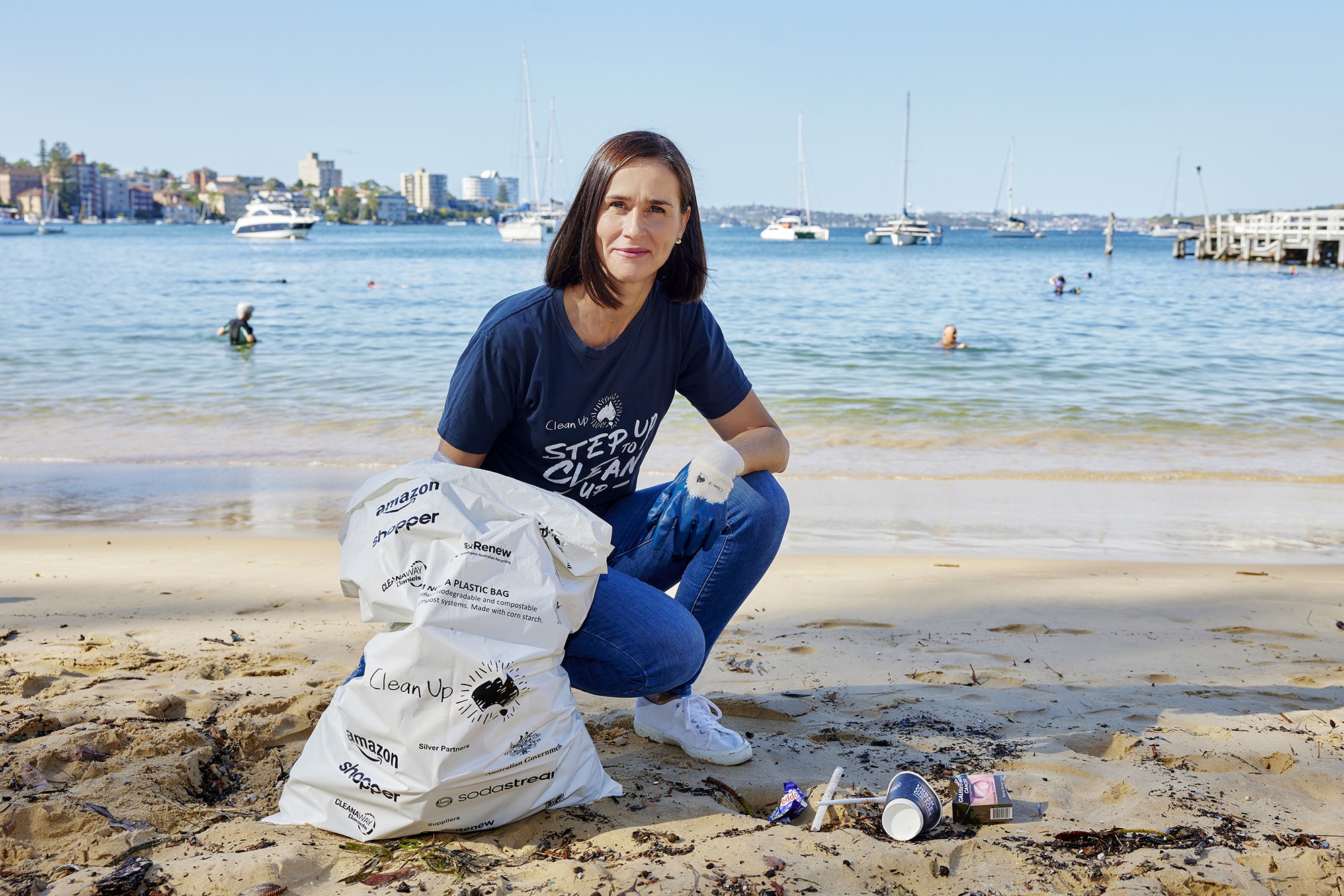
EPA Decision Fails Endangered Gliders: Keeps Them On Track For Extinction From FCNSW Logging
- A 50-metre exclusion zone around known recorded locations of greater glider dens.
- Protection of extra greater glider trees in addition to existing hollow bearing and giant tree requirements:
- Six trees per hectare greater than 80cm in diameter in high greater glider density areas, in addition to the eight hollow bearing trees currently required to be protected.
- Four trees per hectare greater than 50cm in diameter in lower density areas, in addition to the eight hollow bearing trees currently required to be protected.
- The retention of additional hollows and future hollow-bearing trees in areas where greater gliders are less likely to occur.
- Greater glider trees must prioritise hollows (especially ones with evidence of use) where they exist.
- Undertaking of a monitoring program to ensure the ongoing effectiveness of these new rules for greater gliders.
_in_a_Eucalypt.jpg?timestamp=1707022047131)
Coastal IFOA Forest Monitoring Review
Consultation period
From: 22 January 2024
To: 18 February 2024
The Natural Resources Commission is seeking your feedback on monitoring in NSW’s coastal state forests. The Coastal Integrated Forestry Operations Approval (Coastal IFOA) sets out the rules for native timber harvesting in NSW coastal state forests. These rules have been in place since November 2019.
A monitoring program has been established to assess the ongoing effectiveness of the Coastal IFOA in delivering its objectives and outcomes. The first program framework was approved in March 2020 and extends to 2024.
Get more information on the Coastal IFOA monitoring program.
The monitoring program must have a major review every five years, the first of which is due in 2024. This first review will focus on program progress and results, including trends. It will also assess the adequacy of the program and how it can be improved.
This review must include:
- detailed reporting of monitoring program progress and all results
- detailed analysis of trends
- an assessment of the adequacy of the monitoring program.
The Natural Resources Commission is undertaking the review as part of its role as the independent chair of a cross-agency Steering Committee that oversees the monitoring program.
To inform the review, we are seeking your thoughts on the first five years of the Coastal IFOA monitoring program, including any feedback on:
- Does the monitoring program provide useful information and insights that meet your needs? If not, what are the key gaps?
- Is the monitoring program and its findings clear and easy to understand, or can this be improved?
- Any other ways we can improve the monitoring program?
Have your say by Sunday 18 February 2024 via:
Email: nrc@nrc.nsw.gov.au
Mail: Address - Natural Resources Commission, GPO Box 5341, Sydney, NSW, 2001.
More information
Email: Project team
Phone: 02 9228 4844
Documents
Coastal Integrated Forestry Operations Approval Approved Monitoring Program 2019-2024 (PDF 2.38MB)
Stay Safe From Mosquitoes This Holiday Season
- Applying repellent to exposed skin. Use repellents that contain DEET, picaridin, or oil of lemon eucalyptus. Check the label for reapplication times.
- Re-applying repellent regularly, particularly after swimming. Be sure to apply sunscreen first and then apply repellent.
- Wearing light, loose-fitting long-sleeve shirts, long pants and covered footwear and socks.
- Avoiding going outdoors during peak mosquito times, especially at dawn and dusk.
- Using insecticide sprays, vapour dispensing units and mosquito coils to repel mosquitoes (mosquito coils should only be used outdoors in well-ventilated areas)
- Covering windows and doors with insect screens and checking there are no gaps.
- Removing items that may collect water such as old tyres and empty pots from around your home to reduce the places where mosquitoes can breed.
- Using repellents that are safe for children. Most skin repellents are safe for use on children aged three months and older. Always check the label for instructions. Protecting infants aged less than three months by using an infant carrier draped with mosquito netting, secured along the edges.
- While camping, use a tent that has fly screens to prevent mosquitoes entering or sleep under a mosquito net.
Kimbriki Resource Recovery Centre: Early Childhood Educators Professional Development Day
As part of Kimbriki's 2024 Eco House & Garden Educational Calendar, this year we introduce the Early Childhood Educators Professional Development Day on Friday 22nd March. For more details and bookings 👉 https://www.trybooking.com/events/landing/1162305
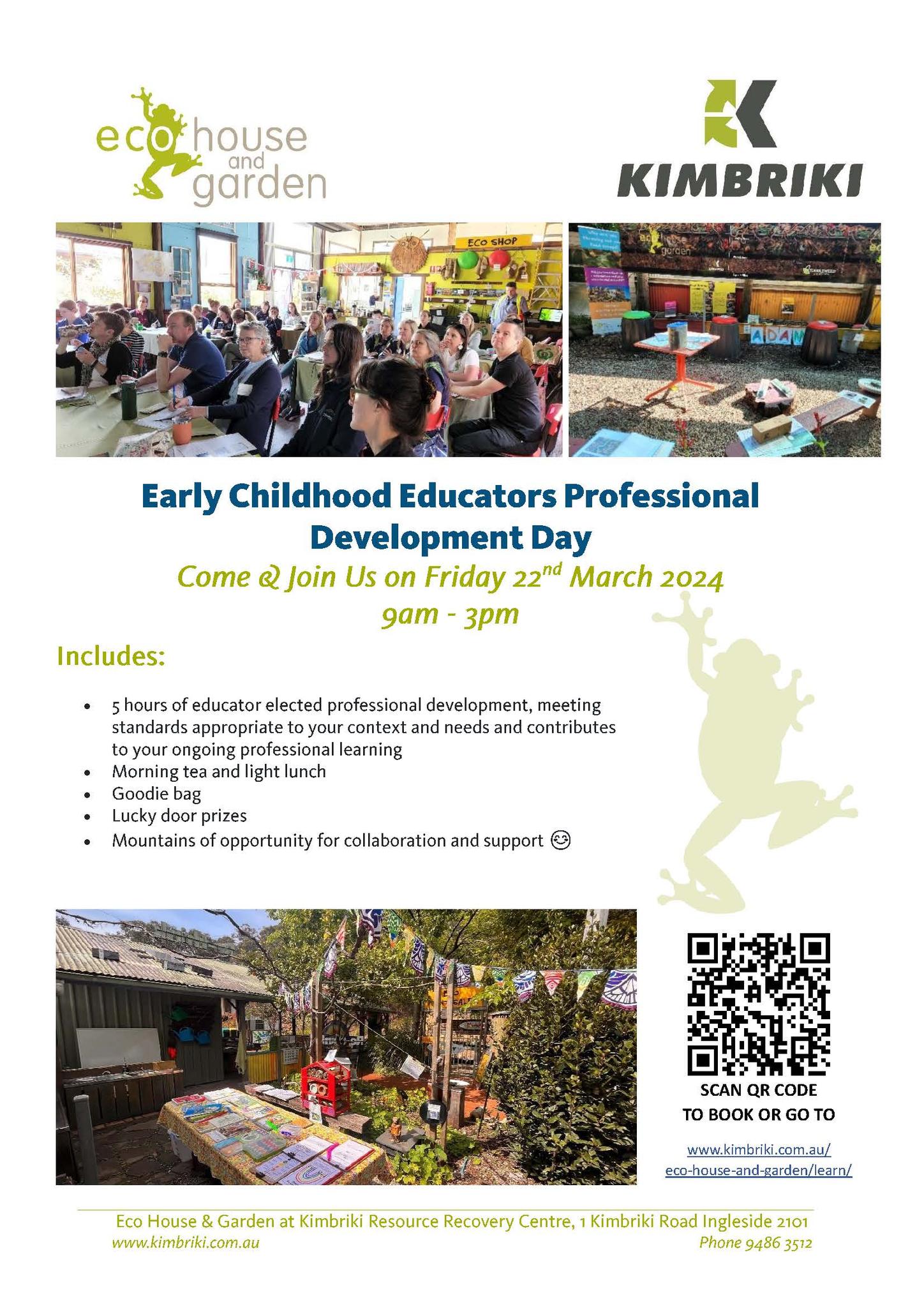
Mountain Bike Incidents On Public Land: Survey
- Mountain Bike Incidents On Public Land: Survey Launched To Gather Data On What's Happening To Public Parks - Community Land - Bush Reserves In Pittwater
- Mother Brushtail Killed On Barrenjoey Road: Baby Cried All Night - Powerful Owl Struck At Same Time At Careel Bay During Owlet Fledgling Season: calls for mitigation measures - The List of 'What You can Do' as requested
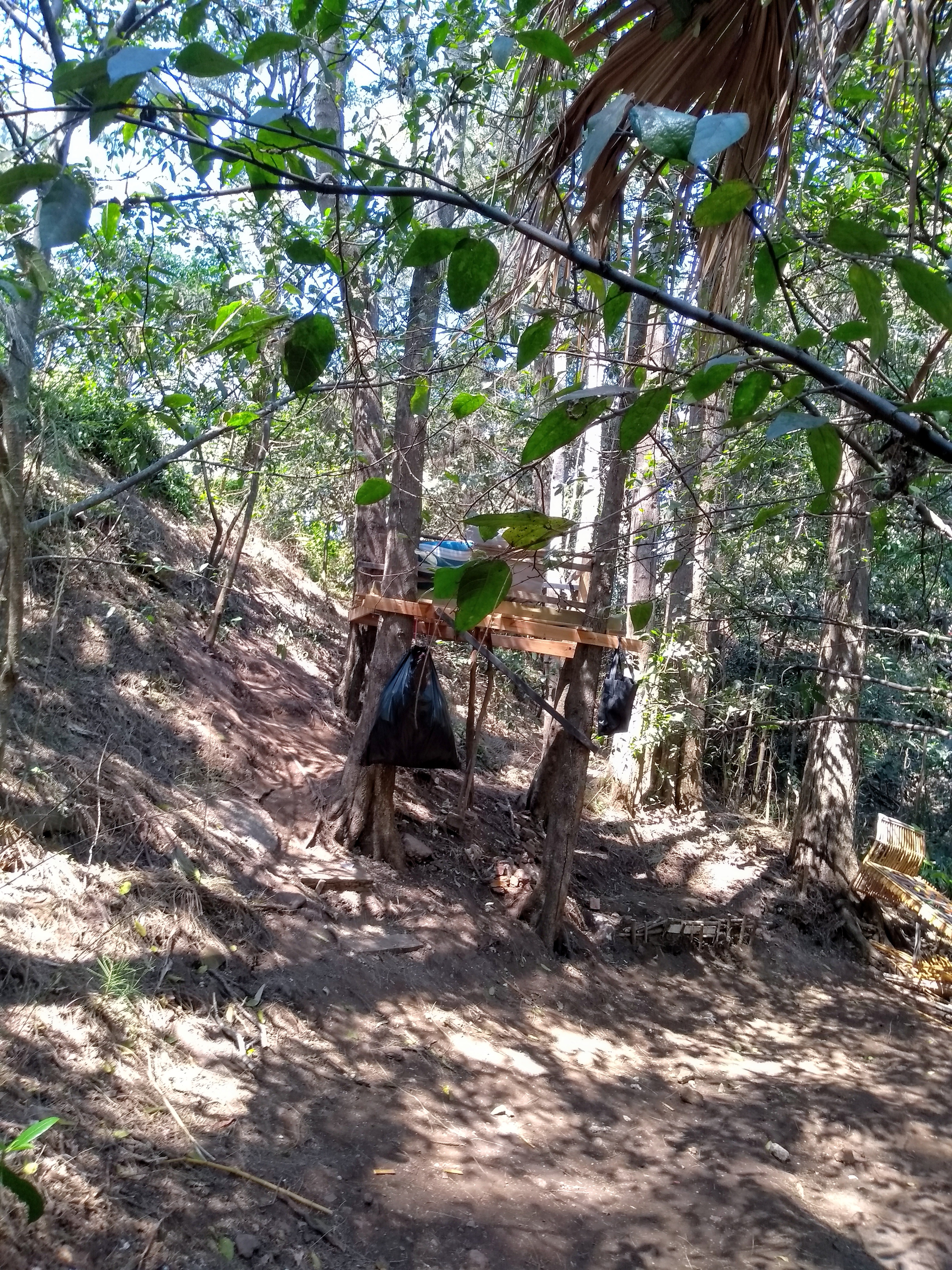
Please Look Out For Wildlife During Heatwave Events

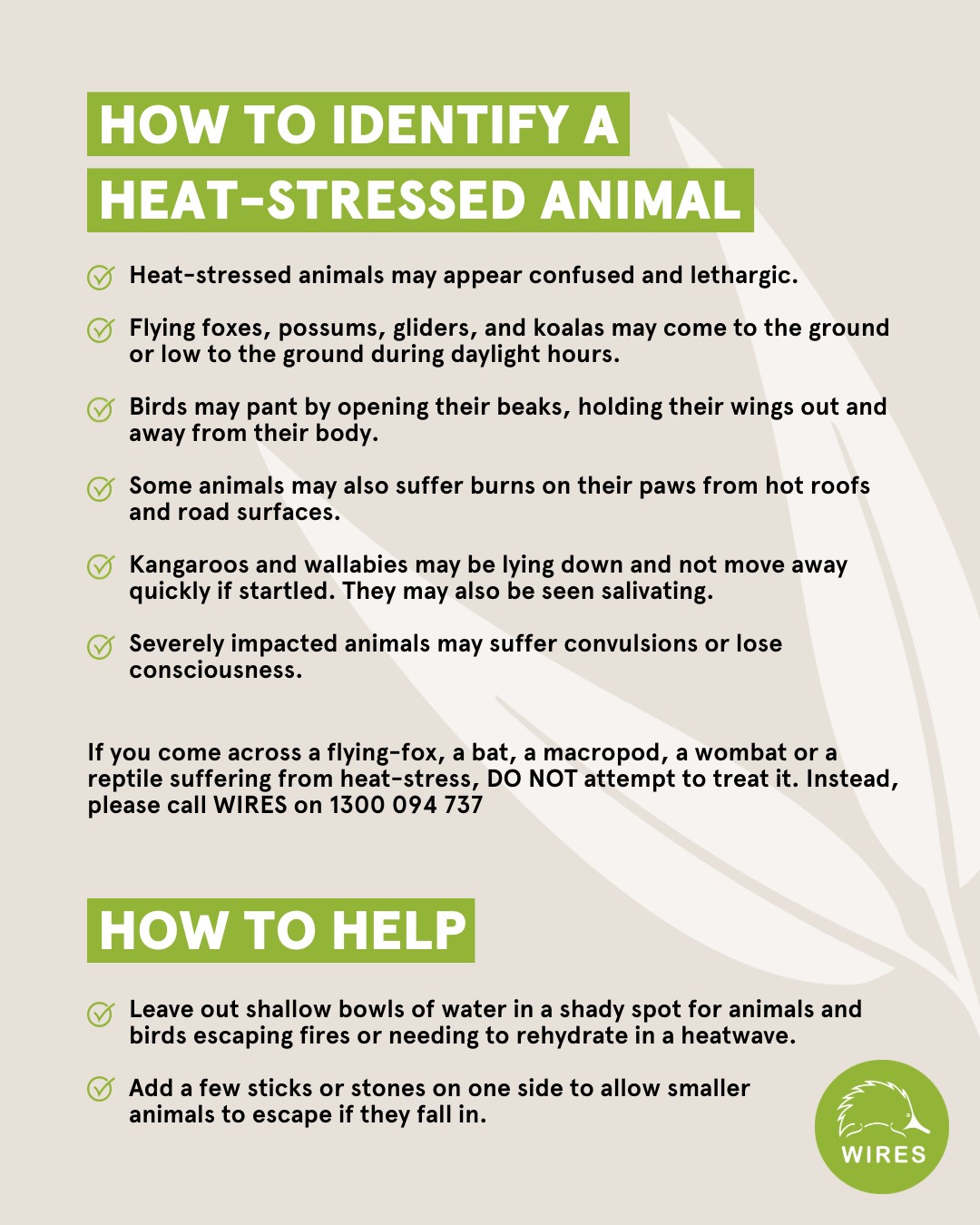
Palmgrove Park Avalon: New Bushcare Group
 Palmgrove Park Avalon is a remnant of the Spotted Gum forest that was once widespread on the lower slopes of the Pittwater peninsula. This bushland’s official name and forest type is Pittwater and Wagstaffe Endangered Ecological Community, endangered because so much has been cleared for suburban development. Canopy trees, smaller trees and shrubs, and ground layer plants make up this community. Though scattered remnant Spotted Gums remain on private land, there is little chance of seedlings surviving in gardens and lawns. More information HERE
Palmgrove Park Avalon is a remnant of the Spotted Gum forest that was once widespread on the lower slopes of the Pittwater peninsula. This bushland’s official name and forest type is Pittwater and Wagstaffe Endangered Ecological Community, endangered because so much has been cleared for suburban development. Canopy trees, smaller trees and shrubs, and ground layer plants make up this community. Though scattered remnant Spotted Gums remain on private land, there is little chance of seedlings surviving in gardens and lawns. More information HERE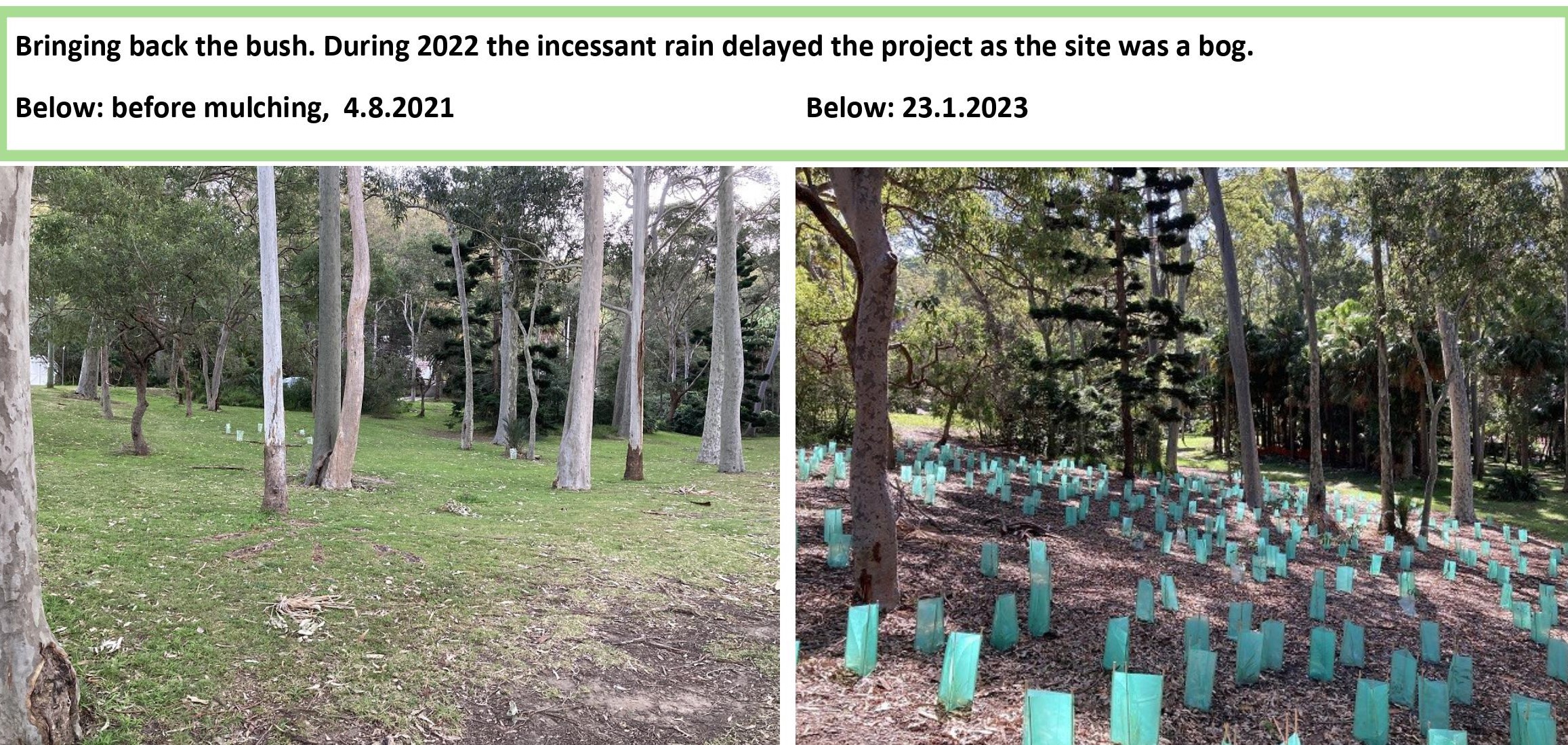
Report Fox Sightings
%20(1).jpg?timestamp=1675893929686)
Marine Wildlife Rescue Group On The Central Coast
A new wildlife group was launched on the Central Coast on Saturday, December 10, 2022.
Marine Wildlife Rescue Central Coast (MWRCC) had its official launch at The Entrance Boat Shed at 10am.
The group comprises current and former members of ASTR, ORRCA, Sea Shepherd, Greenpeace, WIRES and Wildlife ARC, as well as vets, academics, and people from all walks of life.
Well known marine wildlife advocate and activist Cathy Gilmore is spearheading the organisation.
“We believe that it is time the Central Coast looked after its own marine wildlife, and not be under the control or directed by groups that aren’t based locally,” Gilmore said.
“We have the local knowledge and are set up to respond and help injured animals more quickly.
“This also means that donations and money fundraised will go directly into helping our local marine creatures, and not get tied up elsewhere in the state.”
The organisation plans to have rehabilitation facilities and rescue kits placed in strategic locations around the region.
MWRCC will also be in touch with Indigenous groups to learn the traditional importance of the local marine environment and its inhabitants.
“We want to work with these groups and share knowledge between us,” Gilmore said.
“This is an opportunity to help save and protect our local marine wildlife, so if you have passion and commitment, then you are more than welcome to join us.”
Marine Wildlife Rescue Central Coast has a Facebook page where you may contact members. Visit: https://www.facebook.com/profile.php?id=100076317431064
- Ph: 0478 439 965
- Email: marinewildlifecc@gmail.com
- Instagram: marinewildliferescuecc

Watch Out - Shorebirds About
.JPG.opt1460x973o0,0s1460x973.jpg?timestamp=1663629195339)
Possums In Your Roof?: Do The Right Thing

Aviaries + Possum Release Sites Needed

Bushcare In Pittwater
Where we work Which day What time
Avalon
Angophora Reserve 3rd Sunday 8:30 - 11:30am
Avalon Dunes 1st Sunday 8:30 - 11:30am
Avalon Golf Course 2nd Wednesday 3 - 5:30pm
Careel Creek 4th Saturday 8:30 - 11:30am
Toongari Reserve 3rd Saturday 9 - 12noon (8 - 11am in summer)
Bangalley Headland 2nd Sunday 9 to 12noon
Bayview
Winnererremy Bay 4th Sunday 9 to 12noon
Bilgola
North Bilgola Beach 3rd Monday 9 - 12noon
Algona Reserve 1st Saturday 9 - 12noon
Plateau Park 1st Friday 8:30 - 11:30am
Church Point
Browns Bay Reserve 1st Tuesday 9 - 12noon
McCarrs Creek Reserve Contact Bushcare Officer To be confirmed
Clareville
Old Wharf Reserve 3rd Saturday 8 - 11am
Elanora
Kundibah Reserve 4th Sunday 8:30 - 11:30am
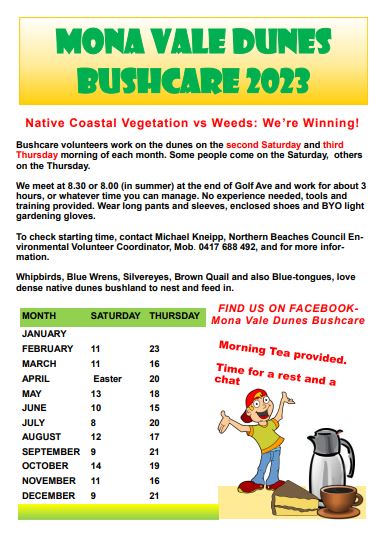 Mona Vale
Mona Vale Mona Vale Beach Basin 1st Saturday 8 - 11am
Mona Vale Dunes 2nd Saturday +3rd Thursday 8:30 - 11:30am
Newport
Bungan Beach 4th Sunday 9 - 12noon
Crescent Reserve 3rd Sunday 9 - 12noon
North Newport Beach 4th Saturday 8:30 - 11:30am
Porter Reserve 2nd Saturday 8 - 11am
North Narrabeen
Irrawong Reserve 2nd Saturday 2 - 5pm
Palm Beach
North Palm Beach Dunes 3rd Saturday 9 - 12noon
Scotland Island
Catherine Park 2nd Sunday 10 - 12:30pm
Elizabeth Park 1st Saturday 9 - 12noon
Pathilda Reserve 3rd Saturday 9 - 12noon
Warriewood
Warriewood Wetlands 1st Sunday 8:30 - 11:30am
Whale Beach
Norma Park 1st Friday 9 - 12noon
Western Foreshores
Coopers Point, Elvina Bay 2nd Sunday 10 - 1pm
Rocky Point, Elvina Bay 1st Monday 9 - 12noon
Friends Of Narrabeen Lagoon Catchment Activities

Gardens And Environment Groups And Organisations In Pittwater
- Ringtail Posse: 1 – February 2023; Anna Maria Monticelli: King Parrots/Water Dragons - Jacqui Scruby: Loggerhead Turtle - Lyn Millett OAM: Flying-Foxes - Kevin Murray: Our Backyard Frogs - Miranda Korzy: Brushtail Possums
- Ringtail Posse: 2 - March 2023; Kevin Murray: Tawny Frogmouth - Kayleigh Greig: Red-Bellied Black Snake - Bec Woods: Australian Water Dragon - Margaret Woods: Owlet-Nightjar - Hilary Green: Butcher Bird - Susan Sorensen: Wallaby
- Ringtail Posse 3 - April 2023: Jeffrey Quinn: Kookaburra, Tom Borg McGee: Kookaburra, Stephanie Galloway-Brown: Bandicoot, Joe Mills: Noisy Miner
- Ringtail Posse 4 May 2023 - Andrew Gregory: Powerful Owl, Marita Macrae: Pale-Lipped Or Gully Shadeskink, Jools Farrell: Whales & Seals, Nicole Romain: Yellow-Tailed Black Cockatoo
- Ringtail Posse 5: June 2023 - Lynleigh Greig OAM: Snakes, Dick Clarke: Diamond Python, Selena Griffith: Glossy Black-Cockatoo, Eric Gumley: Bandicoot
- Ringtail Posse 6: July 2023 - Sonja Elwood: Long-Nosed Bandicoot, Dr. Conny Harris: Swamp Wallaby, Neil Evers: Bandicoot, Bill Goddard: Bandicoot
- Ringtail Posse 7: August 2023 - Geoff Searl OAM: Tawny Frogmouth, Peter Macinnis: Echidna, Peter Carter: Ringtail Possum, Nathan Wellings; Kookaburra
- Ringtail Posse 8: September 2023 - Saving Sydney's Last Koalas; Logging Now Stopped In Future Koala Park By Minns Government - ''Is There Time To Save Sydney's Last Koalas Too?'' Asks: John Illingsworth, WIRES, Sydney Wildlife Rescue, Save Sydney Koalas, The Sydney Basin Koala Network, The Help Save The Wildlife & Bushlands In Campbelltown Group, Appin Koalas Animal Rescue Service, Patricia and Barry Durham, Sue Gay, Save Mt. Gilead, Paola Torti Of The International Koala Intervention Group
- Ringtail Posse 9: October 2023 - David Palmer OAM: Bandicoots, Helen Pearce: Brushtail Possum, Amina Kitching: Goanna, David Goudie: Ringtails Possums + Bandicoots + Owls
- Mother Brushtail Killed On Barrenjoey Road: Baby Cried All Night - Powerful Owl Struck At Same Time At Careel Bay During Owlet Fledgling Season: calls for mitigation measures - The List of what you can do for those who ask 'What You I Do' as requested
- Ringtail Posse 10: November 2023 - Stop Wildlife Roadkill Group: You Can Help By Using The Wildlife Incident Mapping Website
50+ Birds Of The Blue Mountains Australia
Video by BIBYTV, published February 2, 2024
This marvellous medley of beautiful birds was created from two years (Dec 2021 – Jan 2024) of footage collected in the Blue Mountains (NSW, Australia). This very special place is Gundungurra and Dharug Country. We acknowledge the Traditional Owners of the land and pay our respects to their Elders past and present. We are grateful for the vital contribution of First Nations People to the knowledge and conservation of Australia’s birds.
While many of the birds shown here can be found in relevant habitats throughout the Blue Mountains, almost all the filming took place in the upper mountains town of Wentworth Falls and nearby sections of the Blue Mountains National Park (BMNP). Locations include the Kings Tableland, Jamison Creek, Nature Track, Undercliff-Overcliff Tracks, Den Fenella Track, Central Park, a private garden and Wentworth Falls Lake. One scene was gleaned from a smaller lake in “The Gully” Katoomba.
For this video we focussed on birds which frequent the towns and environs of the region traditionally known as the Blue Mountains (BM), rather than the much larger Greater Blue Mountains World Heritage Area (GBMWHA). To see more of the incredible bird diversity of the GBMWHA, check out our earlier production, “100+ Birds of the Capertee Valley” https://youtu.be/q-HIdyOeyOI.
Although filming occurred in a relatively small area, it’s a microcosm of the vistas and vegetation communities that make up the BM region – moist cliff-ringed valleys, open forest and woodland, rainforest, scrub and heath, and modified environments such as public parks and cold-climate gardens. As the name suggests, Wentworth Falls is particularly blessed with water. Like much of the BM, there are several creeks, waterfalls and seeping rock-faces (and water features in gardens), but additionally, a large artificial lake. However, water birds are also regularly seen at “The Gully” Katoomba, Woodford Dam and Glenbrook Lagoon, just to name a few.
The video showcases various behaviours, such as foraging, vocalising, loafing, preening/allo-preening, bathing, bickering, swimming, flying, courting and raising young. Some birds were quite accessible as they frequented parks, gardens and bushland. For those adaptable, relatively common birds (e.g. Red Wattlebird) we tried to convey the variety of their food sources, both native and exotic. Knowing how birds use both natural and modified environments is important for conservation, as is understanding that some birds are truly dependent on remnant bushland and wilderness, and even particular plants (e.g. Glossy Black-Cockatoos and she-oaks). Although several parrot species (e.g. Crimson Rosella) often forage in cottage gardens, they need old eucalypts with hollows for nesting.
Relatively rare, threatened species can become video stars when the filming area is prime habitat (e.g. Glossy Black-Cockatoo), whereas we had just one opportunity with the more common White-headed Pigeon as the lower mountains is more their style. Perhaps the biggest surprise was the Speckled Warbler. This little bird is listed as Vulnerable and is associated with dryer lower-altitude woodland (e.g. Megalong and Capertee Valleys). Indeed, there are exceedingly few sightings in the upper mountains or BM generally on ebird.org. What a treat to see one foraging in a burnt area (hazard reduction) on the Kings Tableland.
It’s hard to choose video highlights with so many charismatic characters and fascinating behaviours. We think you will particularly enjoy Superb Lyrebird mimicry (13.39), Satin Bowerbird bower activity (16.02 and 19.17), an Eastern Spinebill on Grevillea acanthifolia (21.15), Australian Magpies carolling (34.56) and a Beautiful Firetail gleaning she-oak seeds (38.21).
The 57 bird species are listed here in order of appearance: Yellow-tailed Black-Cockatoo. Glossy Black-Cockatoo, Gang-gang Cockatoo, Sulphur-crested Cockatoo, Galah, Australian King Parrot, Crimson Rosella, Rainbow Lorikeet, Superb Lyrebird, Satin Bowerbird, Eastern Spinebill, New Holland Honeyeater, Red Wattlebird, Little Wattlebird, Noisy Friarbird, Yellow-faced Honeyeater, White-naped Honeyeater, Brown Cuckoo-Dove, Crested Pigeon, Wonga Pigeon, White-headed Pigeon, Fan-tailed Cuckoo, Eastern Koel, Laughing Kookaburra, Welcome Swallow, Silvereye, Grey Fantail, Eastern Yellow Robin, Golden Whistler, Rufous Whistler, Grey Shrike-thrush, Speckled Warbler, White-browed Scrubwren, Brown Thornbill, Striated Thornbill, Variegated Fairy-wren, Varied Sittella, White-throated Treecreeper, Black-faced Cuckoo-shrike, Pied Currawong, Australian Magpie, Grey Butcherbird, Olive-backed Oriole, Bassian Thrush, Red-browed Finch, Beautiful Firetail, Little Pied Cormorant, Great Cormorant, Masked Lapwing, Australian Wood Duck, Pacific Black Duck, Hardhead, Australasian Grebe, Great Egret, Australian White Ibis, Australasian Swamphen and Eurasian Coot.
Filmed, edited and produced by Darren Broughton and Thalia Broughton.
Snowy 2.0 Contractor Fined For Water Pollution Incident
January 30, 2024
The NSW Environment Protection Authority (EPA) has issued a $15,000 fine to Snowy Hydro Limited contractor WeBuild S.P.A in relation to its Snowy 2.0 operations in Kosciuszko National Park.
The EPA alleges that during construction works near the Wallaces Creek Bridge at Lobs Hole, the contractor inadvertently altered the drainage pathway for stormwater runoff, resulting in sediment laden water discharging into Wallaces Creek, which flows in to Yarrangobilly River.
NSW EPA Executive Director Operations Jason Gordon said the EPA’s investigation found that the short-term duration of the incident resulted in some minor impacts to water quality in a short section of Wallaces Creek, and after considering the compliance history of WeBuild, the EPA considered a penalty notice to be warranted.
“We have strict requirements in place to protect delicate ecosystems and waterways from pollution and we expect absolute compliance,” Mr Gordon said.
“This is a large project spanning over a significant area and the EPA will maintain a strong regulatory oversight to ensure the environment is protected.
“Kosciuszko National Park contains highly specialised plants, animals and micro-organisms and is home to a number of endangered species including the Booroolong Frog.
“The community expects all contractors to prevent pollution incidents and it is critical that those working in the region understand the importance of protecting the environment in this unique area.
“The EPA will continue to closely monitor the project and escalated enforcement action can be expected if further breaches are detected and may include prosecution action for serious breaches of the environment laws.
In August last year, WeBuild were fined after an unattended pump resulted in around 9000 litres of sediment-laden water entering the Yarrangobilly River. In April 2023, both Snowy Hydro Limited and WeBuild were fined over two alleged pollution incidents in the Kosciuszko National Park, where the EPA alleged inadequate sediment and erosion controls were established, despite warnings by EPA officers.
The EPA encourages the community to report potential water pollution incidents to the Environment Line on 131 555.
For more information about the EPA’s regulatory tools and strategy, see the EPA website: https://www.epa.nsw.gov.au/about-us/publications-and-reports/regulatory-strategy
Progress Report On The Great Barrier Reef Delivered To UNESCO
- Invested a record $1.2 billion in the Reef.
- Legislated to reach net zero, with a 43 per cent emissions reduction target by 2030 and committed to reaching 82 per cent renewable energy supply by 2030.
- Invested $200 million to improve water quality through projects such as revegetation, grazing management and engineering work like gully stabilisation.
- Rejected a coal mine that could have direct impacts on the Reef.
- Withdrawn federal funding for dams that would have had a detrimental impact on Reef water quality.
- Invested an extra $163.4 million to guarantee the future of the Australian Institute of Marine Science, doubling funding for Reef science.
- Committed to rewriting Australia’s broken environmental laws including establishing a national environment protection agency.
- Engaged more Indigenous Rangers to manage sea country, including combatting crown of thorns starfish outbreaks, marine plastics and ghost nets.
- Invested more than $1 billion since 2015 to protect the Reef including the current commitment of $289.6 million to the Queensland Reef Water Quality Program.
- Announced an ambitious new interim emissions reduction target of 75 per cent below 2005 levels by 2035 as we work towards net zero emissions by 2050.
- Introduced legislation into the Parliament to give effect to our $62 billion Queensland Energy and Jobs Plan, which will deliver a 90 per cent reduction of electricity emissions on 2005 levels by 2035-36.
- Commenced, in partnership with the Australian Government, the phase-out of gillnets in the Great Barrier Reef Marine Park with a $185 million package.
- Australia will continue to engage constructively with UNESCO, the World Heritage Advisory Bodies and the Committee on the long-term health of the Reef.
New Strategy To Protect Reef Wetlands
Victorian Government To Continue Allowing Native Duck Slaughter
On January 31,2024 the Animal Justice Party of Victoria announced firmly stands against the State Labor Government's decision to maintain recreational duck (and quail) shooting. This contentious decision, disregarding both the growing public outcry and the advice of a recent parliamentary inquiry, sets the Victorian Government in direct conflict with the principles of animal welfare and the wider community's expectations.
In Inquiry stated in its final report:
The Committee has made a recommendation to end recreational native bird hunting on all Victorian public and private land as of 2024. This would bring Victoria in line with many other Australian jurisdictions, including those in throughout the eastern seaboard. The Committee’s rationale is driven by the considerable environmental evidence of long-term decline in native bird populations, and a worsening outlook as our climate continues to change. The Committee was also acutely aware of the animal welfare issues associated with native bird hunting, as well as the amenity loss of large areas of public land to the overwhelming majority of the Victorian public during the hunting season.
Victoria’s native fauna is unique and should be protected. Native bird populations across eastern Australia have been in constant and consistent decline over the last 40 years. This has been caused by significant habitat loss driven through mismanagement of water resources, the impacts of climate change, repeated drought and fluctuating weather cycles. Although Victoria has experienced a significant increase in water surface and fuller wetlands in the most recent La Niña cycle, we have not experienced the same rebound in bird populations. This is an ongoing trend.
The Victorian Government responded on January 29 2024, stating:
Recreational duck and quail hunting will continue in Victoria with important changes to ensure it remains safe, sustainable and responsible.
The Victorian Government today announced its response to Parliament’s Inquiry into Victoria's recreational native bird hunting arrangements – confirming its position has not changed, and recreational duck and quail hunting will continue with common-sense changes.
The Government will accept seven of the Select Committee’s eight recommendations in full or in principle. While the Committee did not reach consensus in its report, the views of more than 10,000 Victorians and organisations were heard in the biggest response to a Parliamentary inquiry ever in Victoria.
Recreational duck and quail hunting is a legitimate activity, and it matters to thousands of Victorians who love the great outdoors, but it needs to proceed safely and sustainably. That’s why we’re introducing common-sense changes to make hunting even more responsible from 2025, including:
- Improving hunters’ knowledge and skill by making education and training for hunters mandatory
- Stricter compliance levels, including further penalties for hunters breaking the rules
- Banning the use of lead shot for quail hunting
- Implementing the Waterfowl Wounding Reduction Action Plan, to reduce the risk of wounding, and
- Greater recognition of Traditional Owners’ knowledge of hunting and land management
To guide the length and conditions of each duck season, the science-based Adaptive Harvest Management process will be implemented from 2025 – making sure that it’s always science that guides the season.
After record-high native bird breeding in recent years due to the significant rainfall Victoria has received, the Victorian game duck population increased by almost three-fold.
Minister for Outdoor Recreation, Steve Dimopoulos has announced the 2024 duck season will commence on Wednesday 10 April 2024 and end on Wednesday 5 June 2024, inclusive.
Hunting start times will be delayed to 8:00am for the entire season. With a daily bag limit of six ducks per day, the Blue-winged Shoveler and Hardhead cannot be hunted for the 2024 season due to their threatened status. Determinations will be made as part of normal seasonal arrangements about sites where duck hunting will be prohibited.
Minister for Outdoor Recreation Steve Dimopoulos stated:
“Duck hunting is a legitimate activity – but more than that, it supports regional communities and economies.”
“Our position has not changed and we’re supporting recreational duck and quail hunting to continue in a safe, sustainable and responsible way with minimal harm to our environment.”
“We thank everyone who contributed to the Inquiry – the process was about listening to different perspectives, and that’s exactly what we’ve done.”
However, political opponents have stated ''the continuation of duck shooting in Victoria is a stark contrast to the actions taken by three other Australian states, where this practice has been rightly banned. The AJP views this as a significant setback in the fight for animal welfare and environmental protection. It reflects a concerning disregard for the declining populations of native waterbirds, a fact well-established by scientific research and acknowledged in the inquiry.
The AJP questions the logic and motivations behind the Government's decision, especially in the light of clear evidence and strong public sentiment against the practice. This decision, according to the AJP, is not just a matter of animal welfare but also raises concerns about the proper use of public lands and taxpayer resources. The continued support for duck shooting limits the use of state game reserves for more peaceful, non-harmful recreational activities, essentially prioritizing a minority's interests over the general public's, the party said in a statement.
''Furthermore, the Government's justification for citing an increase in duck numbers contradicts the findings of environmental studies and the recent inquiry, which indicate a worrying decline in native bird populations. This inconsistency brings into question the basis of the Government's decision-making process, suggesting that it may be influenced more by political considerations than by a commitment to animal welfare or environmental conservation.
The AJP firmly believes that this decision does not reflect the values and desires of most Victorians, who are increasingly supportive of animal welfare and environmental conservation. The party asserts that the Government's stance is not only detrimental to native wildlife but also disregards the growing public demand for more ethical and humane treatment of animals.
In our commitment to advocating for the voiceless, the AJP is determined to continue its fight against this outdated and cruel practice. The party calls on the Victorian Government to reconsider its stance and align its policies with the progressive, compassionate values that represent the majority of Victorians. The AJP's dedication to this cause is unwavering, and we stand ready to lead the charge toward a future where the welfare of all living beings is given the priority it deserves.
The Animal Justice Party's stance on this issue is clear: the time for change is now. It's time for the Government to show true leadership and compassion by banning recreational duck (and quail) shooting and protecting our native wildlife for future generations.''
Allowing duck hunting to continue in Victoria is shameful and part of a disturbing trend

The Victorian government has confirmed duck and quail hunting will continue in the state, albeit with changes which would purportedly ensure the practice “remains safe, sustainable and responsible”.
The controversial decision is a rejection of recommendations by a bipartisan parliamentary committee chaired by a Labor MP, which recommended ending native bird hunting this year.
I, along with my Elder Anthony McKnight, made a submission to the inquiry. To us as Yuin men, Yumburra (black duck) – one of the species being hunted – is a culturally significant species and our tribal totem. Yumburra is Country, we are Country. Harm to Yumburra is harm to us.
Our submission argued against recreational hunting of native birds based on concerns for the ongoing health of duck populations and questions over the ethics of the sport. We acknowledge that not all Traditional Custodians share the same position, but this is ours.
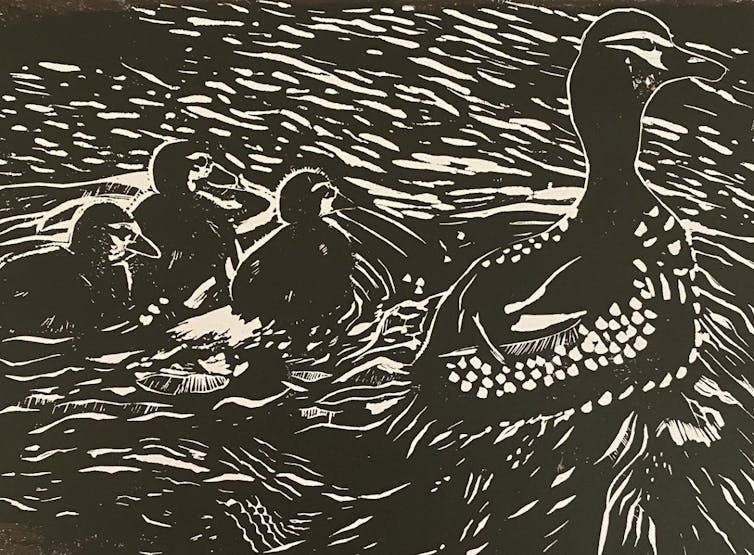
Open Season For Controversy
Duck hunting has long been contentious in Victoria. The issue emerges every autumn when the responsible minister is set to announce the details of the shooting season. Each year the same groups come out to wade through the muddy water and thrash out the same bloody arguments.
Advocates of the sport argue it brings money into regional communities and that it has become a tradition (albeit one with a short history in the context of this old land).
But the fact remains that waterfowl populations are in long-term decline. The inquiry heard that habitat destruction is the major contributor to this trend but that hunting was likely to be a small contributing factor.
Duck hunting also causes avoidable injuries to birds. The inquiry heard non-lethal wounding rates of ducks could be as high 6-40%, or 15,700 to 105,000 based on the 2022 season.
I cannot accept such high rates of injury to a significant totem. I hunt for feral deer, species that cause great damage to Country, but I only shoot when I’m confident of a humane kill. And I fish, but I only take fish when I’m comfortable that crayfish and abalone numbers are strong on the reefs where I have swum all of my life.
In allowing duck hunting to continue, the Victorian government is ignoring the main recommendation of the committee.
The government says it will accept the other seven recommendations “in full or in principle”, by changing the rules from 2025. This includes:
- making education and training for hunters mandatory
- improving compliance and toughening penalties
- reducing the risk of wounding
- increasing recognition of Traditional Owners’ knowledge of hunting and land management.
In theory this addresses many of the problems. But in practice these measures will be resource-intensive and challenging to implement effectively. Education and compliance activities will need to be well funded and staffed. And hunting-related harm to individual ducks and populations can only be reduced, when it could have been eliminated.
Finally, these measures fail to address the issues that have been driving waterbird populations down over decades.
A Disturbing Pattern Of Behaviour
The Victorian government has form in ignoring evidence of the declining health of our environment.
In December 2021 I was invited to present an Indigenous perspective to an inquiry into ecosystem decline in Victoria. I told them of watching the decline of the manna gum woodlands I had grown up in, and how that impacted me.
That inquiry found threatened native species are suffering severe declines and are not being holistically protected. It also recommended the Victorian government consider revoking the “unprotection order” that allows dingoes, a threatened native species, to be killed over vast areas of Victorian private and public land.
Three weeks afterward as part of the Independent Expert Panel reviewing the Wildlife Act, I submitted our report to the state government. The government commissioned the review because it was concerned about limitations of the laws following two high-profile cases, including the deliberate mass killing of wedge-tailed eagles, a species acknowledged by many Indigenous Victorians as the Creator.
In the two years since we submitted our report, the Victorian government has not responded nor released our report publicly.
In September last year, the Barengi Gadjin Land Council called for an end to indiscriminate killing of dingoes, a species Indigenous Australians consider kin. Just weeks later, the Victorian government extended the unprotection order for dingoes.
In October 2022 the Victorian Auditor General’s Office released a report titled Protecting Victoria’s Biodiversity. It highlighted flaws in the state environment department’s threatened species protection and the data that informed decision-making.
That report also noted the department received less than half of the funding it requested to meet its own targets. What’s more, the most recent state budget decreased spending on the environment.
So where does this get us? Late last year the Victorian State of the Environment report was quietly tabled in parliament. Among the grim findings were that biodiversity continues to decline. Most biodiversity indicators assessed had deteriorated since 2018. These declines included “waterbird species in the Murray–Darling Basin” and “distribution and abundance of waterbirds in the Murray–Darling Basin”.
Demand More From The Victorian Government
The Victorian government’s support for recreational duck hunting is just one in a litany of failures to respond adequately to environment decline and to support the views of Indigenous Victorians.
The world is achingly beautiful, but that beauty is fading. It’s not fading in a faraway place, it’s happening on your doorstep, within your sphere of influence.
We, as Victorians, must accept our responsibility to care for this place that sustains us both physically and spiritually. We must demand that governments acknowledge the environment is being devastated and prioritise policies to reverse the trend. We cannot abdicate this responsibility to Country any longer.![]()
Jack Pascoe, Research fellow, The University of Melbourne
This article is republished from The Conversation under a Creative Commons license. Read the original article.
Native forest logging makes bushfires worse – and to say otherwise ignores the facts
Philip Zylstra, University of Wollongong; Grant Wardell-Johnson, Curtin University; James Watson, The University of Queensland, and Michelle Ward, The University of QueenslandThe Black Summer bushfires burned far more temperate forest than any other fire season recorded in Australia. The disaster was clearly a climate change event; however, other human activities also had consequences.
Taking timber from forests dramatically changes their structure, making them more vulnerable to bushfires. And, crucially for the Black Summer bushfires, logged forests are more likely to burn out of control.
Naturally, the drivers of the fires were widely debated during and after the disaster. Research published earlier this month, for example, claimed native forest logging did not make the fires worse.
We believe these findings are too narrowly focused and in fact, misleading. They overlook a vast body of evidence that crown fire – the most extreme type of bushfire behaviour, in which tree canopies burn – is more likely in logged native forests.
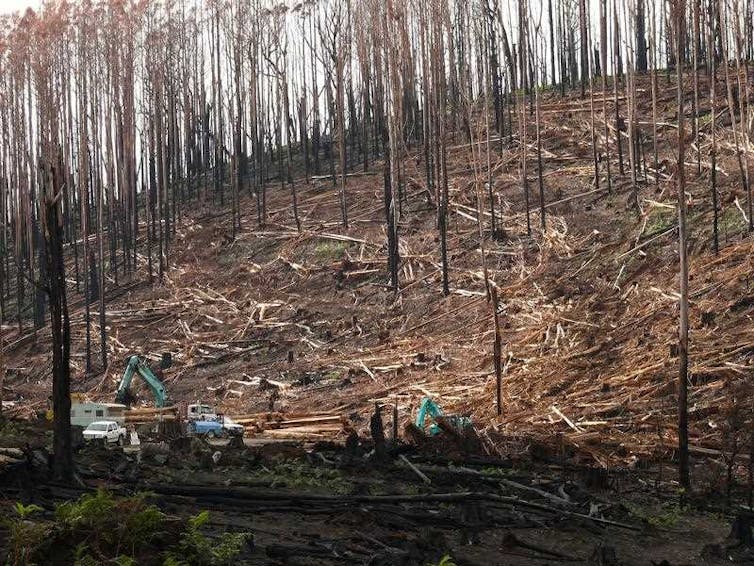
Crown Fires Vs Scorch
The Black Summer fires occurred in the 2019-20 bushfire season and burned vast swathes of Australia’s southeast. In some cases, fire spread through forests with no recorded fire, including some of the last remnants of ancient Gondwanan rainforests.
Tragically, the fires directly killed 33 people, while an estimated 417 died due to the effects of smoke inhalation. A possible three billion vertebrate animals perished and the risk of species extinctions dramatically increased.
Much of the forest that burned during Black Summer experienced crown fires. These fires burn through the canopies of trees, as well as the undergrowth. They are the most extreme form of fire behaviour and are virtually impossible to control.
Crown fires pulse with such intense heat they can form thunderstorms which generate lightning and destructive winds. This sends burning bark streamers tens of kilometres ahead of the fire, spreading it further. The Black Summer bushfires included at least 18 such storms.
Various forest industry reports have recognised logging makes bushfires harder to control.
And to our knowledge, every empirical analysis so far shows logging eucalypt forests makes them far more likely to experience crown fire. The studies include:
A 2009 paper suggesting changes in forest structure and moisture make severe fire more likely in logging regrowth compared to undisturbed forest
2012 research concluding the probability of crown fires was higher in recently logged areas than in areas logged decades before
A 2013 study that showed the likelihood of crown fire halved as forests aged after a certain point
2014 findings that crown fire in the Black Saturday fires likely peaked in regrowth and fell in mature forests
2018 research into the 2003 Australian Alps fires, which found the same increase in the likelihood of crown fire during regrowth as was measured following logging.
The findings of these studies are represented in the image below. The lines a, b and c refer to the 2013, 2014 and 2018 studies respectively.
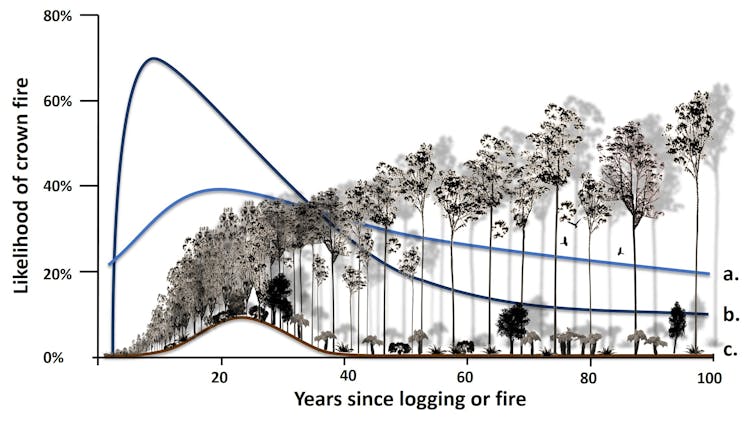
Crown Fires Take Lives
The presence of crown fire is a key consideration in fire supression, because crown fires are very hard to control.
However, the study released last week – which argued that logging did not worsen the Black Summer fires – focused on crown “scorch”. Crown scorch is very different to crown fire. It is not a measure of how difficult it is to contain the fire, because even quite small flames can scorch a drought-stressed canopy.
Forestry studies tend to focus more on crown scorch, which damages timber and is far more common than crown fires.
But the question of whether logging made crown scorch worse is not relevant to whether a fire was uncontrollable, and thus was able to destroy homes and lives.
Importantly, when the study said logging had a very small influence on scorch, this was referring to the average scorch over the whole fire area, not just places that had been logged. That’s like asking how a drought in the small town of Mudgee affects the national rainfall total: it may not play a large role overall, but it’s pretty important to Mudgee.
The study examined trees in previously logged areas, or areas that had been logged and burned by fires of any source. It found they were as likely to scorch on the mildest bushfire days as trees in undisturbed forests on bad days. These results simply add to the body of evidence that logging increases fire damage.
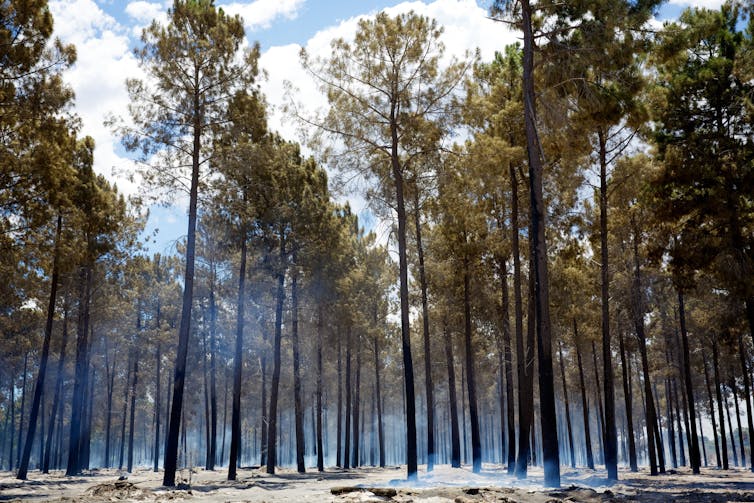
Managing Forests For All
Research shows forests became dramatically less likely to burn when they mature after a few decades. Mature forests are also less likely to carry fire into the tree tops.
For example during the Black Saturday fires in 2009, the Kilmore East fire north of Melbourne consumed all before it as a crown fire. Then it reached the old, unlogged mountain ash forests on Mount Disappointment and dropped to the ground, spreading as a slow surface fire.
The trees were scorched. But they were too tall to ignite, and instead blocked the high winds and slowed the fire down. Meanwhile, logged ash forests drove flames high into the canopy.
Despite decades of opportunity to show otherwise, the only story for eucalypt forests remains this: logging increases the impact of bushfires. This fact should inform forest management decisions on how to reduce future fire risk.
We need timber, but it must be produced in ways that don’t endanger human lives or the environment.![]()
Philip Zylstra, Adjunct Associate Professor at Curtin University, Honorary Fellow at University of Wollongong, University of Wollongong; Grant Wardell-Johnson, Associate Professor, Environmental Biology, Curtin University; James Watson, Professor, The University of Queensland, and Michelle Ward, PhD Candidate, The University of Queensland
This article is republished from The Conversation under a Creative Commons license. Read the original article.
Governments spend US$22 billion a year helping the fishing industry empty our oceans. This injustice must end
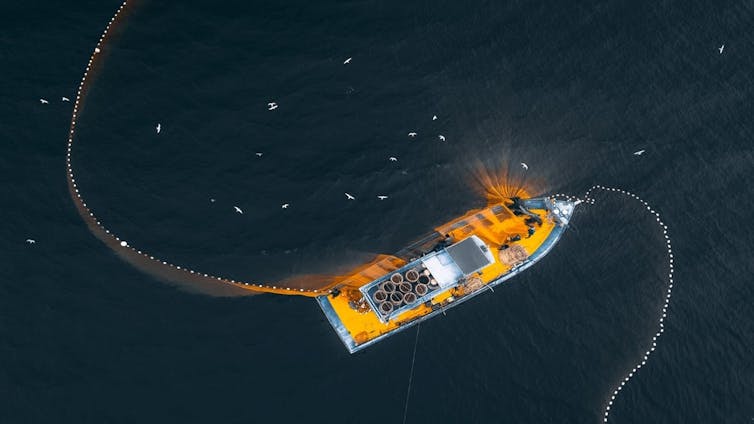
Overfishing has dire consequences for ocean health and for the millions of people who depend on fish for food and wellbeing. Globally, catch has been steadily declining since the 1990s. It’s a trend that’s likely to continue if we fail to act now.
Nearly all governments, including Australia’s, subsidise their fishing industries. Financial support comes in many forms, from taxpayer-funded fuel to reduced boat-building costs. These subsidies are harmful because they encourage overfishing. Some of the most environmentally damaging and least efficient fishing activities, such as bottom trawling and distant water fishing, would become unprofitable and cease without government subsidies.
Scientists worldwide are rallying for stringent regulations to eliminate harmful fisheries subsidies, which totalled a whopping US$22 billion in 2018. Safeguarding the ocean will strengthen food security and allow more equitable distribution of marine resources.
Trade ministers from around the world are set to convene later this month in Abu Dhabi at a key meeting of the World Trade Organization (WTO). In an open letter published today, we are among 36 marine experts calling on the WTO to adopt ambitious regulations promoting fisheries sustainability and equity, and to eliminate harmful fisheries subsidies.
A Long-Awaited Agreement
International pressure from scientists helped to broker an earlier agreement on fishing subsidies, which is yet to be ratified.
In October 2021, 300 experts published an article in Nature calling for an end to harmful subsidies in the fishing sector.
After decades of fruitless negotiations, the WTO finally reached an agreement on fisheries subsidies in June 2022.
Once ratified by two-thirds of WTO members, this agreement will partially address the United Nations Sustainable Development Goal Target 14.6 to eliminate harmful subsidies.

Unfortunately, while this agreement is historic, it is narrow. It only prohibits member governments from financing illegal fishing activities and the exploitation of already overfished stocks. But it’s obvious illegal fishing should be banned and the focus on overfished stocks is too little, too late.
Experts argue the agreement fails to specifically address harmful subsidies across global fisheries and as such only affects a trivial component of subsidy-driven exploitation. The subsidies that reduce operating costs and increase fishing capacity, allowing vessels to travel further and remain at sea longer, remain in place.
Fisheries Subsidies Affect More Than Just Fish
Scientists have been sounding the alarm for decades. Many published studies document the destabilising effects of fisheries subsidies on ecosystems. In addition to impacting biodiversity and ecosystems, subsidies also increase the CO₂ emissions that contribute to climate change.
More recently, studies have also applied a social perspective to this issue. Seafood lifts millions of people out of hunger, malnutrition and poverty. Yet more people will lose a secure source of food and nutrients if fish stocks continue to decline due to industrial overfishing.
Research shedding light on the concept of “equity” shows subsidies don’t just harm the ocean, they also affect human communities. These communities are largely in developing countries which are rarely the source of harmful fisheries subsidies. Rather, their waters are exploited by foreign vessels supported by wealthy governments’ fisheries subsidies.
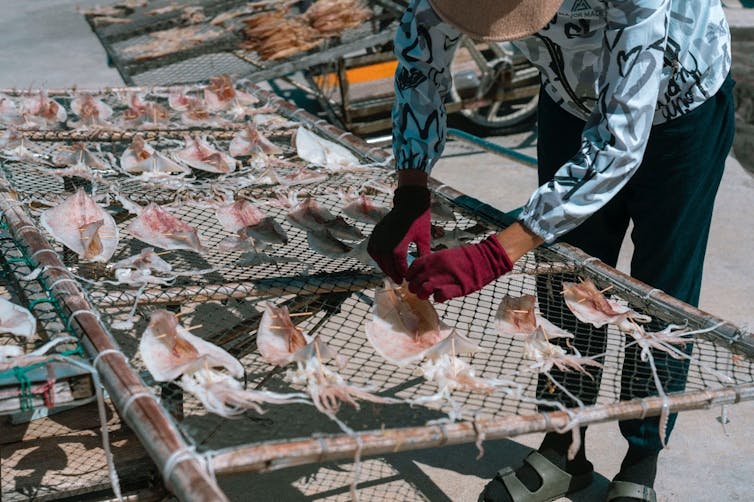
Fisheries subsidies foster unfair competition not only among countries but also between industrial and community led fishing fleets. In the Indian Ocean, the level of subsidies provided to industrial fisheries corresponds to the amount of seafood exported to international markets, largely supplying rich and food-secure countries. This shows governments are deliberately empowering their industrial fleets to fish for seafood largely exported and consumed elsewhere, instead of sustaining fisheries providing food for locals.
The Good, The Bad And The Ugly
While most nations contribute to harmful subsidies, ten nations are responsible for 70% of this unsustainable financing. Chief among them are China, Japan and the European Union, reflecting the significant size of their distant water fishing fleets that typically access the resources of less-developed nations.
In contrast, Australia contributes only 0.1% of global harmful subsidies. Only 6% of Australia’s annual US$400 million in fisheries subsidies is considered harmful. While Australia should give attention to its ongoing annual taxpayer contribution of US$25 million to the fishing sector, it is well placed to demonstrate global leadership on how fishing can deliver sustainable and equitable outcomes without harmful subsidies.
An Essential Opportunity
A second wave of negotiations on fisheries subsidies is expected during the WTO Ministerial Conference this February in Abu Dhabi. This conference represents an invaluable opportunity to better protect the ocean.
In anticipation of this meeting, we are urging nations to adopt more ambitious regulations that eliminate harmful subsidies, prioritising fisheries sustainability and ocean equity.
Harmful fisheries subsidies are not only unsustainable but profoundly unfair. Based on the extensive body of evidence, the WTO should agree to eliminate harmful subsidies once and for all.![]()
Vania Andreoli, PhD Candidate, The University of Western Australia; Dirk Zeller, Professor & Director, Sea Around Us - Indian Ocean, The University of Western Australia, and Jessica Meeuwig, Wen Family Chair in Conservation, The University of Western Australia
This article is republished from The Conversation under a Creative Commons license. Read the original article.
Consulting firms provided low-quality research on crucial water policies. It shows we have a deeper problem
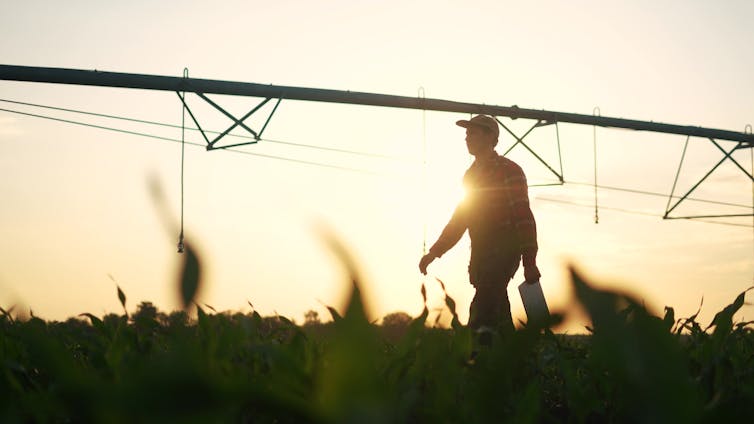
Management consulting revenue in Australia has grown from less than A$33 billion in 2010 to more than $47 billion in 2023. The increasing use of consultants, as well as the PwC scandal, highlights serious issues with vested interests, integrity and transparency.
Consequently, a Senate inquiry is investigating the management and integrity of consulting services. The deadline for the Senate committee’s final report has been extended twice, partly due to the various revelations, to March 28. So far, all the big consulting groups in Australia have appeared before the committee.
Our recent review of research in the Murray-Darling Basin points to other serious concerns about the use of consulting studies, which are increasingly relied upon for policy-making, especially in water. Of the studies we examined, 65 were on the economic consequences of water recovery. Almost half of these were low-quality studies, mainly from consultancies but also by think tanks and government departments. The low-quality studies were more likely to overestimate negative impacts on the economy and community from buying water back for the environment.
Unfortunately, these poor-quality studies were used to justify changes to water policy. Buying back water rights from “willing sellers” is a cost-effective way to redistribute water entitlements. But buybacks were halted under the former Coalition government. The policy will now be restored under Labor in the form of “voluntary water purchases”.
Contested Research Into Water Buybacks
The $13 billion basin plan seeks to improve the health of our nation’s largest river system by returning water from irrigation to the environment.
But such water reallocation has been blamed for huge job losses, reductions in irrigated production and consequently, economic decline in rural towns.
There are many groups with different interests in the basin. Research results are often contested.
To provide an objective assessment and comparison of the quality of basin water economic study results, we developed and applied a new economic quality assessment framework. This was inspired by health research, which has long applied grading systems to ensure robustness in research findings (such as the Grading of Recommendations Assessment, Development and Evaluation.
Our framework enables studies to be classified as low, medium or high quality, to suggest how robust each study’s results may be.
Nearly half (45 per cent) of the 65 water recovery studies in our review were classified as low quality. These low quality studies were much more likely to suggest large negative impacts on economic values from water recovery than higher quality studies. They were also more likely to be consulting studies.
The high quality studies (26 per cent) were peer-reviewed, employed sophisticated modelling and extensive analysis. The estimated impact of water recovery ranged from none to small or modest. None of these studies were funded by industry.
Why Is There Such A Difference In Results?
The method used in each study is a major factor determining research quality. Consultants often rely on simple methods such as “input-output modelling” or “multipliers” to assess economic impact. These are models that often rely upon simplistic assumptions and links within sectors in the economy to predict changes in job numbers or production. These models are not able to consider all possible influences of change.
Input-output modelling is heavily criticised as inappropriate by the Australian Bureau of Statistics and many treasury departments. Given this modelling is used across many areas and subjects within Australia to illustrate “economic impact”, its use and application needs greater scrutiny.
Higher quality studies use methods that allow for dynamic feedback and adaptation. They also account for other factors that influence outcomes such as climate or prices. As a result, higher quality studies in our review do not find anywhere near the same large decrease in jobs or economic impact from reduced water extraction.
For example, some feedbacks that can occur when farmers sell water include that the money is reinvested on the farm, increasing profits, or that the farm switches from irrigated to dryland agriculture, so production continues. Alternatively water recovery may increase community welfare through an improved environment, or better downstream water conditions for other farmers. Simplistic modelling approaches often ignore these other benefits.
Our review also indicated a relative lack of study in the basin on other downstream and Indigenous benefits and costs, as well as a need to pay closer attention to transition and adjustment issues within some small irrigation-intensive communities.
We Need Quality Standards For Water Research
Basin communities will increasingly need to adapt and adjust as the climate changes. We need better ways to cope with such transitions, especially in the face of future upheavals from drought and extreme weather events.
Hopefully the recently released funding and other support for communities announced in the amended water law will help communities adjust to the reallocation of water. To date, such funds have not been allocated to areas most in need.
The negative socio-economic impacts predicted by low-quality studies are often used to justify changed water policies. We, along with other water economic professors, are calling for greater quality standards when it comes to government-funded research into the affects of water reallocation. The government is now required to update the impact analysis for the basin plan. It is essential that any assessment of impact is robust and defensible, following strict quality standards.
These quality standards could also be applied widely, across a variety of policies and areas. Although high quality research is difficult and takes time, relying on inadequate research can have serious consequences. ![]()
Sarah Ann Wheeler, Professor in Water Economics, University of Adelaide; Alec Zuo, Associate Professor, School of Economics and Public Policy, University of Adelaide, and Ying Xu, Research Fellow, School of Economics and Public Policy, University of Adelaide
This article is republished from The Conversation under a Creative Commons license. Read the original article.
Why don’t people care about Australia’s native rodents? The problem could be their ugly names
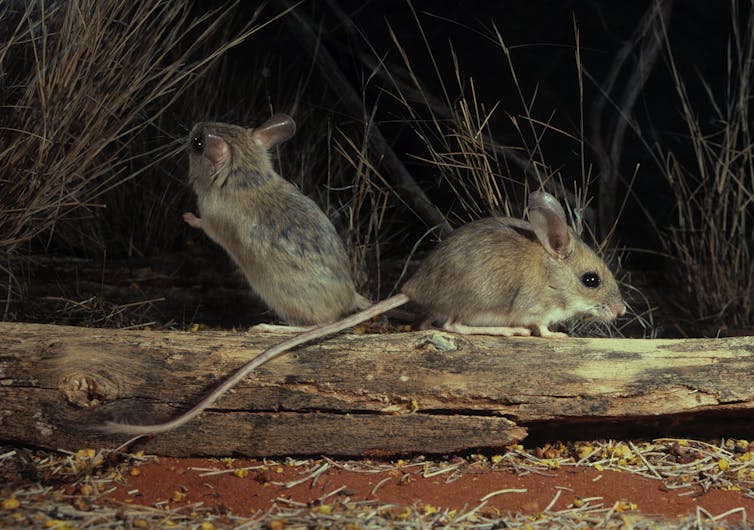
The common names of Australian animals often originate in Aboriginal languages, and beneficially so. Continuing use of names such as kangaroo and kookaburra helps to honour the wealth of knowledge possessed by First Nations peoples, to appreciate the natural heritage of a place more deeply, and to naturalise English to this continent.
Some 30 years ago, I and colleagues published a paper calling for this naming practice to extend to native rodents. This group of animals contains many handsome and fascinating animals among its many species.
But sadly, native rats and mice don’t usually evoke sympathy among the Australian public. The unappealing common names for the species – such as swamp rat or long-haired rat – do little to help the problem.
Public sentiment towards an animal matters. It can affect whether their habitat is protected, if they are prioritised for research and conservation, and the amount of funding devoted to protecting them. So among the many other good reasons to ascribe Aboriginal common names to our species, it might mean the difference between their survival and extinction.
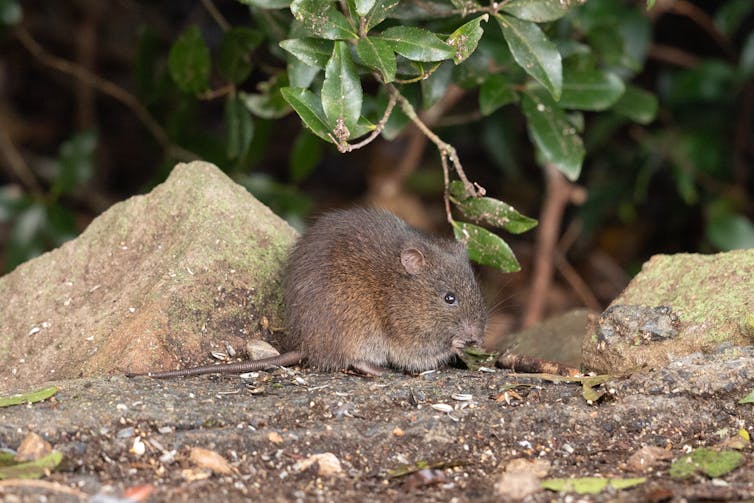
What’s In A Name?
Of the 60 Australian rodent species, nearly 20 are extinct or greatly diminished in range.
As with other threatened mammals, desert-dwelling rodents have suffered most. For example among hopping mice, five of ten species are extinct. Those still remaining could do with our attention – and naming them may help.
Research has shown common names of species are an important tool when seeking to increase community support for conservation.
One study by Australian researchers analysed the common names of almost 27,000 animals from the IUCN Red List of threatened species. It found frequent words in animal common names that produced strong positive or negative sentiment.
Common words driving positive sentiment included “golden” and “great”. Words driving negative sentiment included “rat”, “lesser” and “blind”.
The research found many words were also associated with human emotions. For example, “dove” was associated with joy, anticipation and trust. “Rat” was associated with fear and disgust, probably due to its associations with disease, uncleanliness and deceitfulness, the study found.
The researchers said strategic name changes may improve public engagement and support for species and therefore provide effective, low-cost conservation benefits.
How About ‘Pakooma’ And ‘Palyoora’?
So where might we find new, more appealing monikers for our maligned rodents? Our 1995 paper suggested selecting common names from relevant Aboriginal words that might readily be pronounced by English speakers.
At the time, we checked our document before publication with offices of the then-current Aboriginal and Torres Strait Islander Commission. Should Aboriginal words be used to rename species today, agreement should be sought from the relevant language group.
The brush-tailed rabbit-rat, Conilurus penicillatus, is an example of a rodent ripe for renaming. It’s a striking and vigorous animal of northern Australia, which became extinct in Kakadu National Park in the 2000s and now persists in only a handful of isolated regions. How unfair it is that this splendid creature should be thought of as a mere rat – as well as bearing the nomenclatural burden of Australia’s worst vertebrate pest? Perhaps it could be renamed pakooma, from the East Arnhem languages.
Another sad example is provided by Xeromys myoides, an inhabitant of coastal swamps and mangroves. It is known as the false water rat, a name which could barely be improved upon if the aim is to demean. The animal could well be called yirrkoo, from the Kunwinjku/Mayali language.
And consider the graceful Pseudomys australis, an animal of the outback Channel Country in Queensland and South Australia. The species is of conservation concern, but public attention is hardly likely when the animal is called a plains rat. It deserves better – perhaps the lovely name palyoora, from the Wangkangurru language.
The Tide May Be Turning
Back in the 1990s, our rodent-renaming initiative sank almost without trace. Only one Aboriginal name – rakali, from Murray River languages – took something of a hold, replacing the common name water rat (Hydromys chrysogaster). In the intervening years, two authors of the paper, Dick Braithwaite and John Calaby, have passed away. Time has moved on.
But there have been flickers of encouragement. Western Australia’s 1997 recovery plan for the Shark Bay mouse, Pseudomys fieldi, used the name djoongari (Luritja/Pintubi). When Tim Bonyhady in 2019 published his unusual and matchless book, The Enchantment of the Long-haired Rat: A Rodent History of Australia, he used the name mayaroo throughout (Rattus villosissimus, from Wangkangurru).
And now interest may be resurgent. In the Threatened Species Action Plan 2022–2032, federal environment authorities adopted names of Aboriginal origin wherever possible. This included antina (Zyzomys pedunculatus, central rock-rat, Arrernte), pookila (Pseudomys novaehollandiae, New Holland mouse, Bugila/Ngarigu), and woorrentinta (Notomys aquilo, northern hopping-mouse, from Lardil, the language of Mornington Island).
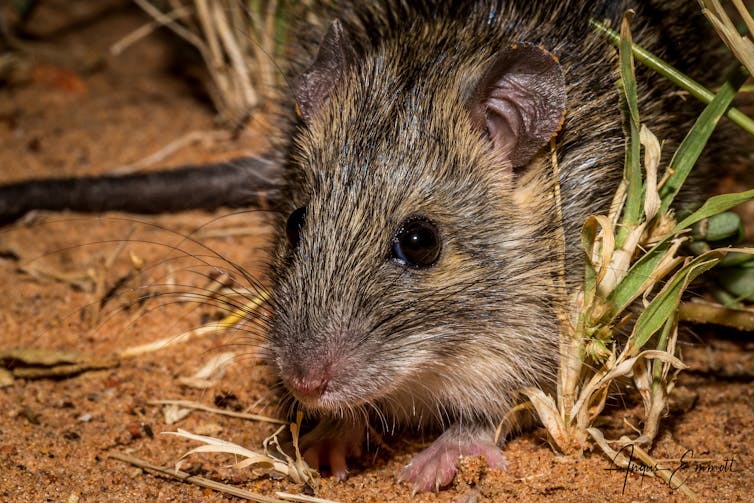
A Timely, Much-Needed Change
Zoologists are rightly conservative about scientific naming conventions, in line with commitment to the principles of biological nomenclature. However, we are free to modify common names – and should, if there are good reasons to do so.
And so, 30 years after my colleagues and I first issued the call, Indigenous names for Australian rodents are commended to you once more. It is timely that the extensive Aboriginal knowledge of our continent be so honoured, that the wider culture be enriched – even if in such a tiny way – and that mayaroo and pookila should live in the English language.
The 1995 paper referred to in this article, Australian Names for Australian Rodents, was authored by R.W. Braithwaite, S.R. Morton, A.A. Burbidge and J.H. Calaby. It was published by the Australian Nature Conservation Agency, Canberra. With thanks to Andrew Burbidge, one of the original authors, for giving his blessing to this article.![]()
Steve Morton, Honorary Fellow, Charles Darwin University
This article is republished from The Conversation under a Creative Commons license. Read the original article.
How the weird and wonderful microbes in wastewater can make our cities more sustainable
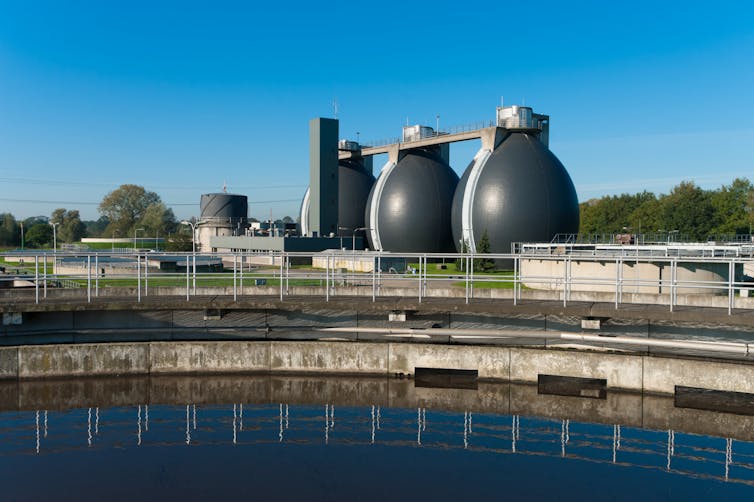
COVID-19 showed us how useful monitoring wastewater can be. But the genetic material in our wastewater, namely DNA and RNA, is a treasure trove of other useful information. It reveals the presence of thousands of different types of weird and wonderful wastewater microbes.
The diversity of these microbes can “talk” to us and tell us how to get more renewable energy out of our wastes. If only we could listen to them. Soon we can.
How will that work? It all starts with our poo. These types of microbes have been used since the 19th century to treat and reduce the ever-increasing volumes of sewage sludge arriving at our wastewater treatment plants, especially in urban areas. Two-thirds of the world’s people are expected to live in urban areas by 2050, hence sewage treatment will be in high demand.
Yet most people today have little idea how vital microbes are for sustainable growth of cities. We need them to treat our waste.
We also need sources of renewable energy. Thanks to naturally occurring microbes, our water utilities can produce renewable biogas from human waste. By reducing our reliance on fossil fuels, their poo biogas can help to mitigate climate change.
So we need to learn more about these microbes to ensure they are doing the best possible job of processing our waste. One way of doing that is by monitoring DNA in human waste sludge.
A Living Sludge Mass
First of all, this promising waste-to-energy technology, which fully relies on microbes, is called anaerobic digestion.
Operating anaerobic digesters is expensive. It requires intense monitoring strategies and frequent interventions. That is because microbes can be unpredictable.
On the face of it, the process is really simple. Wastewater sludge is pumped into large vessels without oxygen, where microbes are left alone for a few days to practically eat the sludge and breathe out biogas. Sludge goes in, treated sludge plus gas goes out.
The process reduces overall sludge mass and the number of pathogens. This ultimately makes it a safer material, while also generating renewable energy. Brilliant, right?
But there is a catch. This process is only effective if these living, breathing treatment vessels behave. Unfortunately, sometimes they get out of control without warning, making them difficult to manage.
These sludge microbes are similar to those in our gut. Once we know this, we might intuitively understand how sensitive they can be, given our experience of gastrointestinal disorders linked to our gut microbes.
So microbial happiness is not only important for our own health, it is crucial for the health of the large digester vessels managed by wastewater treatment plants. To make it cheaper to run these facilities, we urgently need to learn more about life in our sludge.
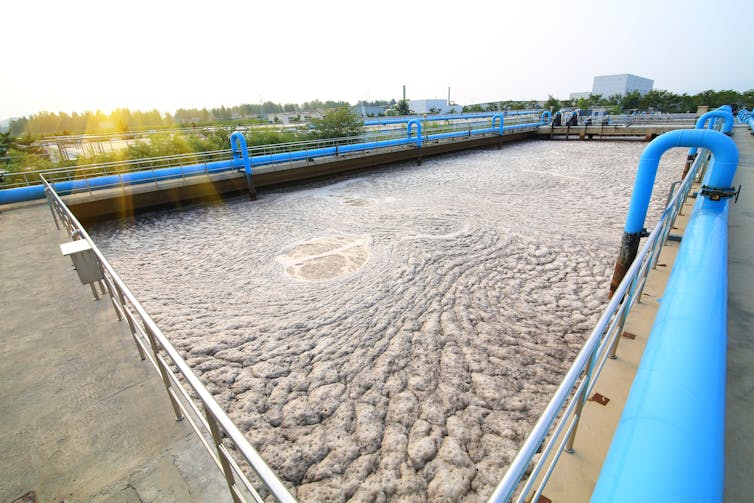
DNA, A Window On An Invisible World
At the ARC Biosolids Training Centre we want to make anaerobic digestion easier for water utilities by developing routine DNA-based monitoring tools. Essentially, we are looking for a way to predict the process to manage it better.
DNA tells the story of thousands of different types of microbes that work together to treat our sludge. To optimise the wastewater treatment process we need to identify them, the troublemakers and the do-gooders.
But sludge life is complex. Before it can tell us its story, we require empirical studies. We have to be able to relate microbial DNA to the process.
To show how that works we produced a review of the role of microbes for monitoring anaerobic digestion. This includes some of the diversity metrics that ecologists use to assess the health of the whole system based on the composition of microbes.
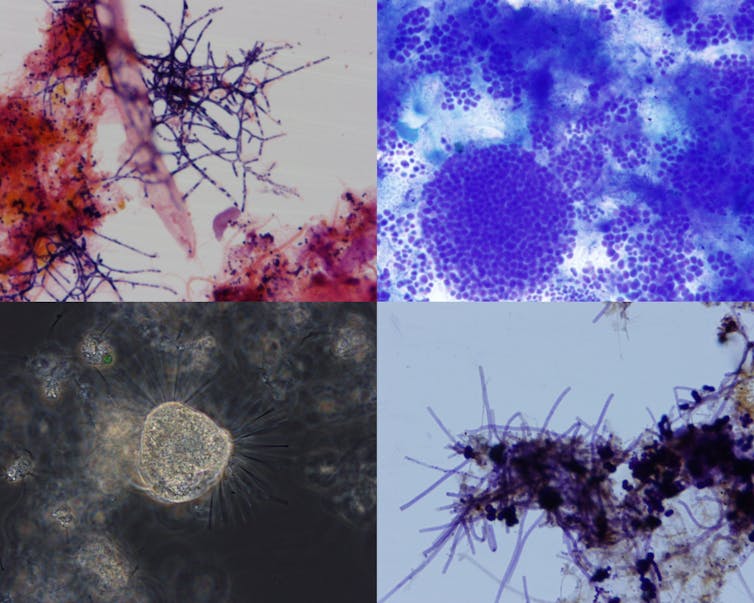
The Weird And The Wonderful
The microbes that are used to treat sludge consist of a diverse range of ancient, weird, at times alien-like bacteria and archaea (another form of single-celled organisms). They can metabolise materials that no other lifeform can.
Amazingly, some of them existed 3.5 billion years ago – the Earth formed 4.5 billion years ago. There is even a chance some have existed on Mars.
And sludge life is a very active community of microbes: some are bullies, some collaborators. Through their DNA, we count them to learn how many different types of microbes there are and how often they appear. This counted diversity can then tell us if a system is healthy or not.
For a healthy, productive system, we need diversity – as many different microbes as possible – to provide stability. If a particular organism somehow starts to grow faster or slower, it means something is getting out of control.
We can exploit that knowledge to develop risk scores for the operators of treatment facilities. And that is what we try to do.
We will keep working so that someday we can properly listen to our sludge-eating microbes and get more value out of our poo.![]()
Christian Krohn, Postoctoral Researcher, School of Science, RMIT University
This article is republished from The Conversation under a Creative Commons license. Read the original article.
Do we want a wind farm outside our window? What Australians think about the net zero transition

A paradox lies at the heart of Australian public opinion about climate change. While there is clear general support for substantial government action to achieve net zero emissions by 2050, there is also strong concern about the local impacts of new renewable energy infrastructure.
The rise of protest groups in regional Australia objecting to the installation of wind farms and transmission lines, in particular, presents a serious challenge to the Albanese government in communicating the importance of the net zero transition to the public.
In principle it seems that Australians strongly support this transition. In a poll for the Australia Institute’s Climate of the Nation report last year, two in three respondents went as far as to say our country should be a world leader in climate action.
Similarly, a 2020 Monash University study found eight out of ten Australians think the shift to renewable energy is inevitable, and two-thirds think we should be exporting renewable energy.
Studies also show strong support for renewable energy production through solar farms, with 90% of Australians prepared to live within ten kilometres of one, according to a 2021 CSIRO study. And a Guardian Essential poll from October last year found about 70% of respondents supported solar farms and 60% supported both offshore and onshore wind farms.
Local Opposition To The Net Zero Transition
But at the same time the installation of these same wind farms has attracted strong local protests, especially in NSW and Victoria. There has also been significant community pushback to the Australian Energy Market Operator’s plan to install 10,000 kilometres of overground transmission lines, which are key to carrying renewable energy to the electricity grid. Only 35% of respondents in the Guardian Essential poll supported them.
In an equally serious challenge for the net zero transition, 70% of respondents felt renewable energy should not be developed “at the expense of local communities”.
In a bid to address these concerns, the Australian Energy Market Commission has drafted new community engagement rules to ensure communities are involved early in the process of designing the routes of transmission lines.
The changes seek to ensure all stakeholders get information about a project in a clear and timely fashion (including advice on how they can best play a role) and have opportunities to be regularly involved throughout the planning of projects.
A More Nuanced Look At Public Opinion
There might be an even bigger issue that helps to explain the tension between apparent general support for acting to arrest global warming and local opposition to specific renewable energy projects. Segmentation studies, first undertaken in 2008 by researchers at Yale and George Mason Universities in the United States, and replicated in many countries, including Australia, are valuable for explaining this apparent paradox.
These studies break down views on climate change into segments of the population with different levels of concern. The original research divided American popular opinion into six groups: Alarmed, Concerned, Cautious, Disengaged, Doubtful and Dismissive.
The spectrum ranges from those most worried about climate change and who tend to take the most action, both in their personal lives and politically, to those who either don’t accept climate change is happening, or feel it isn’t something we need to address.
A range of segmentation studies conducted in 2011, 2016, 2020 and 2022 by researchers from both Australia and the US show Australians have become more worried over time. The Alarmed segment more than doubled between 2011 and 2022.
However, the studies show different segments of the population have different views of when we need to act to arrest climate change.
For example, the 2022 Climate Compass report highlights that people in the Concerned segment — the largest group, comprising one in four Australians — feel climate change is a serious problem but that its impacts will be most felt by future generations. These Australians see cost of living as a much more urgent problem.
While the polling data do not show whether many protesters against renewable energy projects belong to the Concerned segment of the population, it remains essential to explore communication strategies that might move the large numbers of Australians who identify as Concerned into the Alarmed camp. One way to do this might be on the nightly TV news.
Looking More Closely At The Weather
From flooding to heat, many Australian extreme weather records have been broken in recent years. Some people feel that is part and parcel of living in Australia, and remain unaware of the connection between climate change and the increasing frequency and intensity of extreme weather. And it can be difficult to translate complex climate phenomena into terms the public can easily understand.
Yet while the research is not conclusive, there is good evidence that floods, fires and heat waves increase popular concern about global warming by exposing the connection between extreme weather and climate change. Research from our centre argues that weather presenters can play a greater role in making this connection clearer. Australians see weather presenters, along with climate scientists, farmers and fire fighters, as the most trusted sources of information about climate change.
Looking Ahead
Whether or not we fully understand the ways climate change is impacting our society, most Australians realise it’s only going to get worse unless we do something about it. We’ve now moved into the implementation phase of the net zero transition, but many doubt that we’ll achieve it in time. The Guardian Essential poll showed just 31% of respondents felt it was “very” or “quite” likely Australia would achieve its net zero target.
Therefore, it is crucial that we ramp up action towards transforming our energy sector, but it’s equally important that communities be part of deciding how this is achieved. In doing so, we can improve public support, and bring net zero within reach. ![]()
Lucy Richardson, Post Doctoral Research Fellow, Monash Climate Change Communication Research Hub, Monash University and Ella Healy, Operations Manager, Monash University
This article is republished from The Conversation under a Creative Commons license. Read the original article.
Yes, it’s getting more humid in summer. Here’s why
Steven Sherwood, UNSW SydneyHas Sydney felt more like Cairns lately? You’re not imagining it – millions of Australians up and down the east coast have sweltered through exceptionally high humidity in recent weeks.
It’s due to normal weather patterns combined with a boost from global warming. Right now, the temperature of the sea surface is 1–3°C above normal for this time of year up and down the east coast. It’s particularly hot around the Queensland-New South Wales border and Tasmania’s east coast.
When we have high ocean temperatures, we get more water evaporating. This is taken up by the air, which can hold more moisture when the air is hotter. This moist air is then carried to us by winds, and the sweating begins.
Where Does Humidity Come From?
Humidity is just gaseous water held in the air after evaporating from liquid water or ice. It is called a vapour because it condenses into rain — the more humid, the more likely rain is.
Higher humidity makes us feel hotter in warm weather, and slows the drying of laundry on a clothesline or of plants in the garden.
How do we measure it? Two common ways are the “dew point” and “relative humidity”.
At any given air temperature, there’s a limit to how much vapour the air will retain. Any vapour above this limit will just condense out. But the limit roughly doubles with every 10°C of warming; the dew point is the temperature where the vapour would hit the limit. The less vapour there is in the air, the colder the dew point.
Relative humidity is the ratio of how much vapour the air has compared to the maximum it would retain.
If you’re in Tasmania and see that relative humidity is at 100%, you might be confused. But this measure essentially tracks how “full” the air is. At 100% relative humidity, the dew point matches the actual temperature and no more vapour can be added. If the dew point is 10°C below the actual temperature, relative humidity is about 50%.
How do we measure it? The dew point can be measured directly using a chilled mirror and a laser to detect condensation. More often it’s calculated from measurements of relative humidity and temperature.
Relative humidity determines whether material exposed to the air will moisten or dry out. That’s why relative-humidity sensors use cheap water-absorbing materials (early ones used a strand of human hair!).

What Does A Changing Climate Mean For Humidity?
The world’s higher ocean temperatures are unambiguously attributable to global warming, largely from the greenhouse gases we have added by burning fossil fuels. To date, more than 90% of all the extra heat thereby trapped has gone into the oceans.
The amount of water vapour over the oceans has increased by roughly 5% since the industrial era began, in lockstep with global warming.
Global warming will continue until we stop it. That means the atmosphere will keep getting more humid.
If the world manages to keep global warming below 2°C, we should avoid the worst health outcomes from more humidity. But even then, we would expect up to another 5% increase in peak water vapour.
Right now, we are seeing higher-than-normal temperatures in most of our surrounding oceans, with only a few exceptions. The areas hit hardest by rising humidity are mostly those that are already humid, like Queensland and the Northern Territory.
Although peak dew points are rising, you may be confused to hear average relative humidity is actually falling over land. That’s because the land is warming so fast the average dew points aren’t quite keeping up with temperature, lowering the ratio.
That means, alas, that Australia faces a double whammy: increasing water stress and bushfire risk as well as sweatier summers.
Humidity Can Be Very Dangerous
Our natural cooling system in hot weather is evaporation of sweat. Sweat forms on your skin, and the air evaporates it, taking the heat with it.
But this only works to a point. When the dew point is higher, our self-cooling methods get less and less effective. How important this is depends on how hot you feel. On a moderate but muggy day, you might feel fine until you need to climb four flights of stairs and end up sweaty and exhausted. On a hotter but less muggy day you’d feel the heat at the outset, but would more easily handle the stairs.
The Bureau of Meteorology uses something called “apparent temperature” to capture the combined effect of temperature and humidity, although this assumes you’re not exerting yourself.
How you feel with more exertion can be captured by other measures, such as the “wet bulb globe temperature” now being used at sporting events such as the Australian Open.
The Bureau has recently begun providing humidity and apparent temperature forecasts as a beta product, which is great for activity planning.
This type of information will become more important as the heat builds. As humidity increases during peak humid heat episodes, it makes heat stress worse and moves us toward our body’s physical limits.
Recent research has shown the combination of humidity and heat could make parts of the planet unlivable if Paris Agreement targets are not met, beginning in India and spreading elsewhere in the tropics – including the Top End of Australia.
We need to prepare now for increasing heat, while doing everything we can to stop the routine burning of fossil fuels as soon as possible to maintain a margin of safety for humanity.![]()
Steven Sherwood, Professor of Atmospheric Sciences, Climate Change Research Centre, UNSW Sydney
This article is republished from The Conversation under a Creative Commons license. Read the original article.
Australia’s soils are notoriously poor. Here’s how scientists are working to improve them
Ryan Borrett, Murdoch UniversityMost things you eat grew in soil or ate plants growing in soil. We don’t think much about it, but soil is essential to life.
During the last Ice Age, much of the northern hemisphere was covered in glaciers. As they moved, glaciers eroded away the top layer of rock and left a fresh layer of rock, ready to weather into soil.
But Australia didn’t have this renewal of soil from grinding ice – or from volcanoes, which dredge up minerals vital to plant life from deep below. As a result, our soils are famously very poor – heavily weathered, old, and short on nutrients. This is one reason why we have so much land devoted to grazing animals (crops need more nutrients than grass does), a heavy reliance on fertilisers and a detailed knowledge of fertile soils where they exist.
Unfortunately, our soils – valued at A$930 billion – are under threat. The latest State of the Environment report rated the health of our soils as “poor” and declining. Late last year, the government released a national plan to improve our soils.
Researchers are working on ways of improving Australian soils to make agriculture more sustainable and less reliant on fertilisers. Here are some examples.
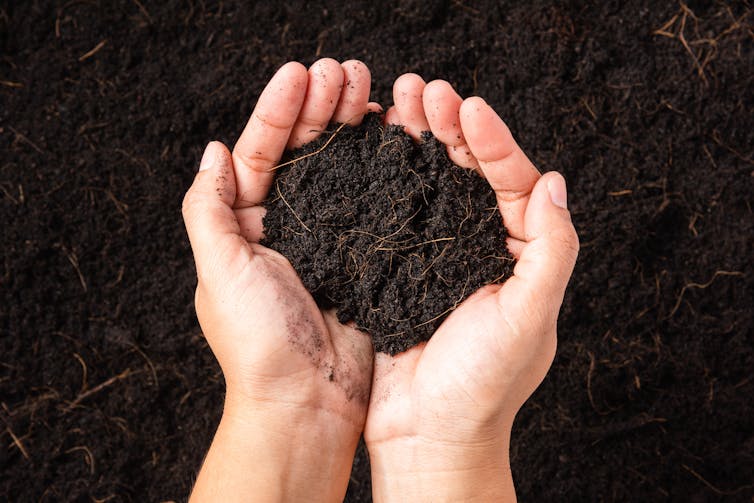
From Farm To Food
You might wonder what the problem is. Aren’t we growing and exporting more food than ever? Farm productivity and incomes are at record highs and many farmers are adopting more efficient practices informed by research to help manage their soil amid new risks such as shifting rainfall and flash droughts.
But many of our soils are fundamentally vulnerable because they function in old and weathered landscapes. To keep the food coming, farmers have had to resort to clearing more land and increasing fertilisers, pesticides and herbicides. That works short term. But there are increasing concerns this intensive approach ends up making soil worse – more eroded, more saline and more acidic. All three of these are worsened by our changing climate.
What Can Be Done?
Soil scientists have long worked on ways to get more out of our soils. The Green Revolution of the 1960s led to huge increases in yield – but required huge increases in application of fertilisers and other chemicals.
In Australia, farmers will likely have to rely on fertiliser for the foreseeable future as a way to correct soils which are naturally short on nutrients.
What we can do is learn to apply fertiliser only when it’s needed. That’s good for farmers – fertiliser is expensive – and good for the health of soil and nearby waterways.
In southwest Western Australia, for example, soil scientists are working to understand how best to dose the soil with nitrogen, potassium and phosphorus – and how much to use.
In another project, scientists are working with farmers and land managers to sample and test their soil and interpret the data together. The goal is to pare back fertiliser use, which improves water quality in nearby waterways and estuaries, as unused fertiliser runs off and can trigger algal blooms.
Precision application of fertiliser is one method. But there are many other innovative soil projects across Australia.
For instance, fungi do vital work in cycling soil nutrients. And mycorrhizal fungi go one step further and live in symbiotic relationships with plants. What if we could use these fungi as a kind of living biofertiliser for grain crops? Scientists are exploring the potential for one such species, the ridge-stemmed bolete (Austroboletus occidentalis), to play this role.
It’s Alive!
Researchers recently estimated soil contains about three-fifths of all species on the planet, including bacteria, fungi, viruses, nematodes, mites, worms and insects.
Soil is, in short, teeming with life. Some underground lifeforms are pests to farmers, chewing on the roots of crops. But many others are beneficial.
If we improve our understanding and measurement of soil microorganisms, we could use them to speed up recovery of degraded landscapes, such as former mine sites or unproductive farmland.
Our understanding of how things living in soil impact environments and respond to change is rapidly growing, but we are still scratching the surface. For example, more than 90% of the estimated 5 million species of fungi are currently unknown.
Digging Deeper
Australia has the world’s third highest loss of soil carbon over the last 250 years, caused largely by very high rates of land clearing. We risk releasing even more soil carbon in the future, as climate change is expected to worsen erosion and bushfire intensity.
One response by the government has been to create a market for soil carbon credits, the first of which went on sale last year. The market-based approach has been widely criticised. Soil experts have called for the credit system to be much more robust to ensure it actually works.
Research into the problems facing our soil is important, but we’ll need government and industry backing to better coordinate the response.
That’s why last year’s action plan has been broadly welcomed, despite being 18 months overdue. The joint federal-state plan indicates governments at both levels recognise the danger to our soil. Framed around securing soil as a “national asset”, the plan envisages standardising soil data collection and sharing, accelerating uptake of best-practice soil management, among other things.
Will it stop the damage done to our lifegiving soils? That remains to be seen. ![]()
Ryan Borrett, Science Communications Coordinator, Murdoch University
This article is republished from The Conversation under a Creative Commons license. Read the original article.
Stop killing brown snakes – they could be a farmer’s best friend

Many Australians who work outdoors – especially farmers and graziers – attempt to kill every snake they encounter, especially those thought to be venomous. In fact, research in one part of rural Australia found 38% of respondents tried to kill snakes wherever possible.
This attitude is misguided and dangerous. Despite their fearsome reputation, venomous Australian snakes pose little risk to human health. And snakes are hugely beneficial on farms by consuming pests such as rodents.
New research by myself and colleagues estimated the magnitude of that benefit. We found adult eastern brown snakes can collectively remove thousands of mice per square kilometre of farmland each year, which substantially increases farm productivity.
Our study suggests the benefits of snake populations on agricultural land far outweigh the potential costs, and farmers should tolerate rather than kill them.
A Persecuted Serpent
Brown snakes are the most common deadly snake species found in disturbed agricultural habitats in the southern half of Australia.
The snakes are fast-moving and active during the day. Brown snakes are generally persecuted in rural areas because the danger of fatal snake bites is seen to outweigh their benefits as pest controllers.
It’s true that brown snakes are the most common cause of fatal snake bite in Australia. But the bites are rarely fatal. Statistics show snakes of any species kill fewer than three people per year in Australia, on average.
Around 3,000 snake bite cases are reported annually – a high proportion of which occur when a snake retaliates to being attacked by a person.
Australian snakes, including brown snakes, generally retreat rather than attack, even when provoked. Eastern brown snakes, in particular, tend to dwell in places where they are unlikely to be encountered by people.
An Upside To Venomous Snakes
The most obvious benefit of maintaining brown snake populations is to reduce rodent numbers. Introduced species of rats and mice are a major cost to Australian agriculture. In extreme cases, mice can destroy most or all of a crop.
We wanted to calculate the number of rodents removed from Australian farmland by brown snakes.
First, we drew on work I had done in the 1980s, which involved dissecting museum specimens to find out what proportion of brown snake diets consisted of rodents.
We then estimated the number of prey consumed each year by brown snakes. This was based on the feeding rates of captive snakes, data from commercially farmed pythons in farms in Thailand and Vietnam, and studies on a species of North American snake which is similar to brown snakes.
To estimate the abundance of brown snakes on farms, we consulted previous research on brown snake abundance, and rates of capture from fieldwork involving red-bellied black snakes. We also obtained data from the Atlas of Living Australia, an online compendium of information about the continent’s plants and animals.
Based on the combined data, we found a square kilometre of farmland can contain 100 adult eastern brown snakes, even where rates of encounters between people and those snakes are low. If each adult brown snake consumes around 100 wild mice each year – which is likely an underestimate – together this must equate to about 10,000 mice per square kilometre. Each mouse removed by a brown snake may eat several kilograms of grain crops over its life.
Give Snakes A Chance
Agricultural productivity gains are not the only benefits of tolerating brown snakes on farmland.
It would also allow a reduction in the use of chemical methods for rodent control, which can be expensive and ineffective. The chemicals can also threaten the health of humans, livestock, scavenging wildlife and pets.
Tolerating brown snakes might also reduce the incidence of snake bite. Most snake bites are inflicted when people are trying to catch or kill the reptile.
What’s more, one study suggests snakes that are long-term residents of an area are less agitated by close encounters with people and know the location of nearby safe havens, and so pose relatively little threat. Culling snakes may create an influx of new animals unfamiliar with the location and not used to humans.
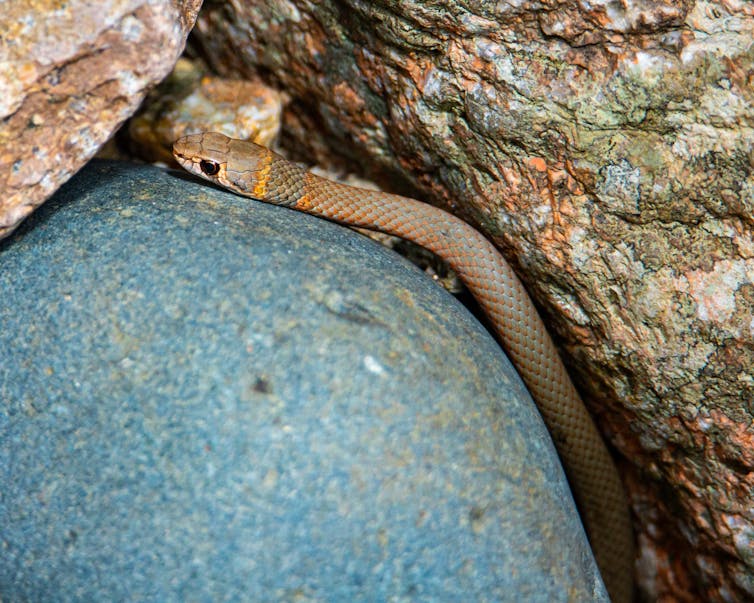
The obvious rebuttal is that killing snakes reduces the incidence of future snake bite, by reducing overall snake numbers. However, data suggests this is not necessarily the case. For example, one study in Indonesia showed reticulated pythons remained abundant despite millions of individuals being removed over decades.
Maintaining viable populations of snakes has an ecological benefit. Removing high-level predators destabilises food webs and disrupts the way ecosystems function.
Finally, conserving snakes has merit in its own right. Many species of snakes are in decline, including in Australia, and should be protected.
Our findings suggest the need for a more balanced view of the costs and benefits of snakes, including brown snakes. Tolerating them may bring benefits that outweigh the already low chance of life-threatening snake bite.
The author would like to acknowledge the contribution of Peter Mirtschin, Nathan Dunstan and Jeff Abraham to the research underpinning this article.
Correction: A figure relating to mice per square kilometre has been amended from 1,000 to 10,000.![]()
Rick Shine, Professor in Evolutionary Biology, Macquarie University
This article is republished from The Conversation under a Creative Commons license. Read the original article.
What Is A Southerly Buster?
A southerly buster is the colloquial name of an abrupt southerly wind change in the southern regions of New South Wales and Victoria, Australia, which approaches from the southeast, mainly on a hot day, bringing in cool, usually severe weather and a dramatic temperature drop, thus ultimately replacing and relieving the prior hot conditions.
This is when we can see our packed beaches suddenly empty as all hose who have been on the beach enjoying the water together suddenly lave together and drive home, together - here's a few photos we took of this occurring at Avalon Beach on Australia Day this year:
Everybody enjoying the pool and ocean at either end of the beach:
As soon as the southerly hit half an hour later everyone at the south end and north end packed up to leave - notice that the light has changed too as this southerly brought cloud with it and the ocean offshore had lots of little whitecaps very suddenly:
Marking the boundary between hot and cool air masses, a southerly buster is sometimes represented by a roll-up cloud perpendicular to the coast, which appears from the south and coexists with the wind change, though sometimes there is little visual signal of the southerly's arrival.
Southerly busters occur in the backside of a low pressure trough in the Tasman Sea, followed by the speedy advance of an anticyclone south of Western Australia and South Australia (around the Great Australian Bight). They are caused by the interaction of a shallow cold front with the blocking mountain range that aligns the coast, and frictional contrasts over the mainland and the ocean that disconnect the flow.
Southerly busters occur about 32 times each year on the coast of southeastern Australia, with variable strength, usually in Spring and Summer. Although southerly busters are often associated with NSW and Victoria, they also occur on the east coast of Tasmania, New Zealand, and in Argentina and Chile.
What Is A Leap Year?
Some of you may have noticed that this year February has a '29th' date instead of finishing on February 28th. That is because this year, 2024, is a Leap Year.
A leap year is a calendar year that contains an additional day compared to a common year.
Called by some 'Leap day', February, our shortest month of the year, typically has 28 days on the calendar. But in a leap year, we add one more day to February, making it 29 days long.
Our normal calendar years are typically 365 days long, or the number of days it takes Earth to orbit the sun. But 365 days is a rounded number. It actually takes 365.242190 days for the Earth to orbit completely, or 365 days, 5 hours, 48 minutes and 56 seconds.
By adding an extra day every four years, this allows our calendar to stay on track with the Earth's actual orbit and not have our seasons drift, as our equinoxes and solstices would no longer align with the seasons.
February 29 Marriage Proposals
Although there are no 'leaping around' activities that occur on February 29th, so far, there is one curious one that seems to have spread, although how often this takes place is not recorded.
In Ireland and Britain, it is a tradition that women may propose marriage in leap years. While it has been claimed that the tradition was initiated by Saint Patrick or Brigid of Kildare in 5th century Ireland, the tradition has not been attested before the 19th century.
Supposedly, a 1288 law by Queen Margaret of Scotland (then age five and living in Norway), required that fines be levied if a marriage proposal was refused by the man; compensation was deemed to be a pair of leather gloves, a single rose, £1, and a kiss. In some places the tradition was tightened to restricting female proposals to the modern leap day, 29 February, or to the medieval leap day, 24 February.
According to one New York journalist: "A play from the turn of the 17th century, 'The Maydes Metamorphosis,' has it that 'this is leape year/women wear breeches.'
A few hundred years later, breeches wouldn't do at all: Women looking to take advantage of their opportunity to pitch woo were expected to wear a scarlet petticoat."
In Finland, the tradition is that if a man refuses a woman's proposal on leap day, he should buy her the fabrics for a skirt.
Leap Year, a 2010 movie tells the story of a lady, Anna, who heads to Ireland to meet her boyfriend on leap day, when tradition holds that women may propose marriage to men on that day.
February 29th this year will also be the last day of Summer.

A lady eagerly awaits the upcoming leap day in this 1903 cartoon by Bob Satterfield.
Opportunities: Council Apprenticeships Currently Listed
Young People At The Centre Of Powerful New Vaping Campaign
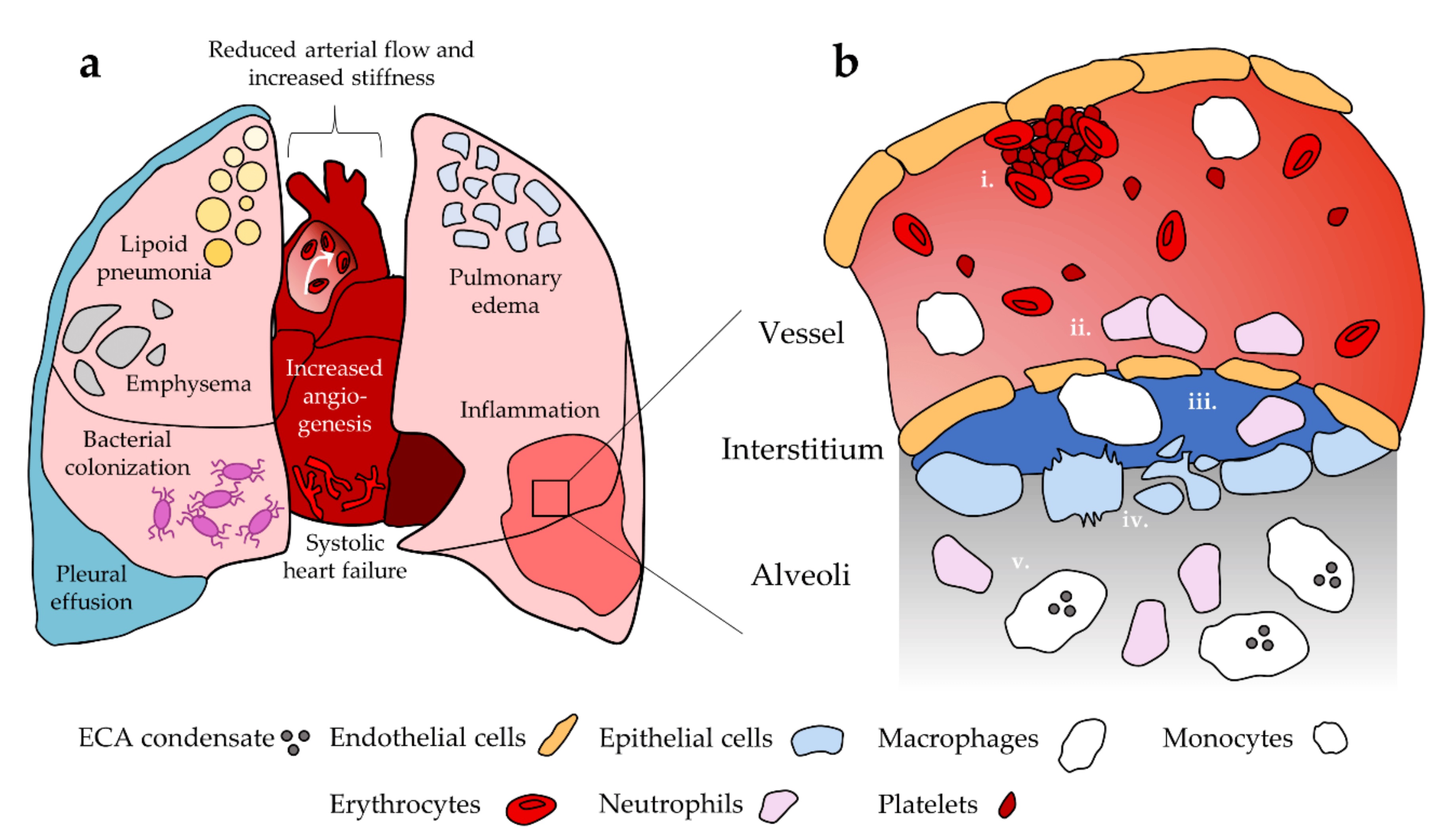
Public Health Warning: Tablets Sold As MDMA (Ecstasy) Found To Contain A Potent Opioid
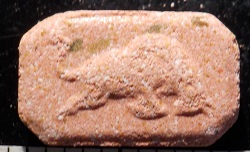

Help TAFE NSW Make A Difference In Your Community
New Service For Students Joins MyGov
Bert Evans Scholarship Winners Announced
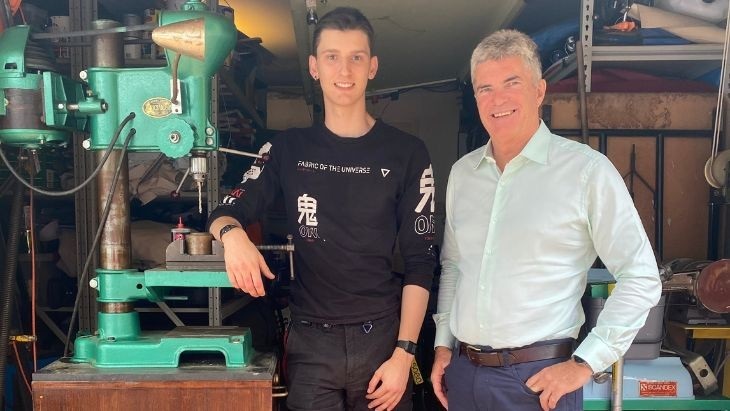
Neanderthals And Humans Lived Side By Side In Northern Europe 45,000 Years Ago
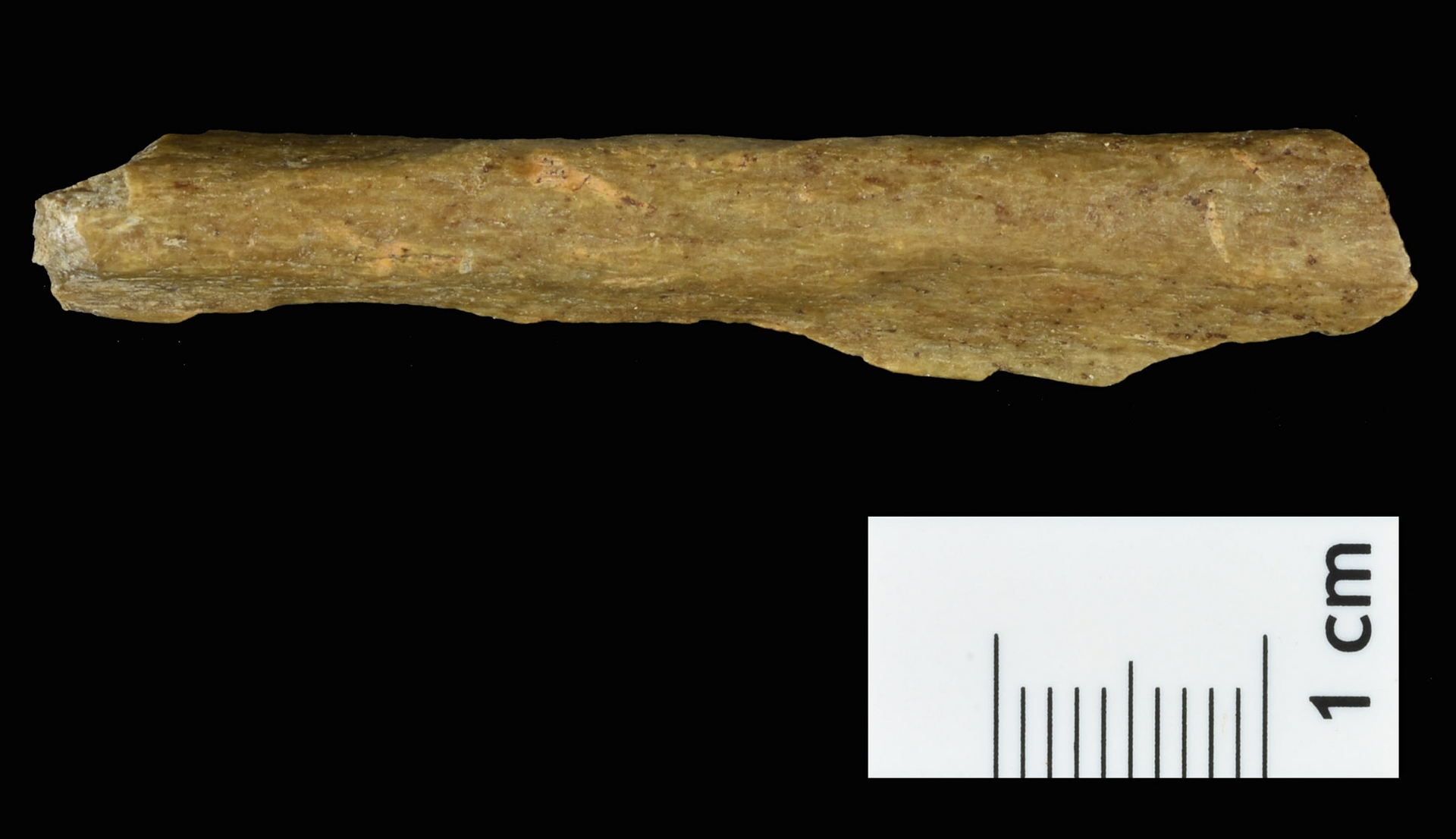
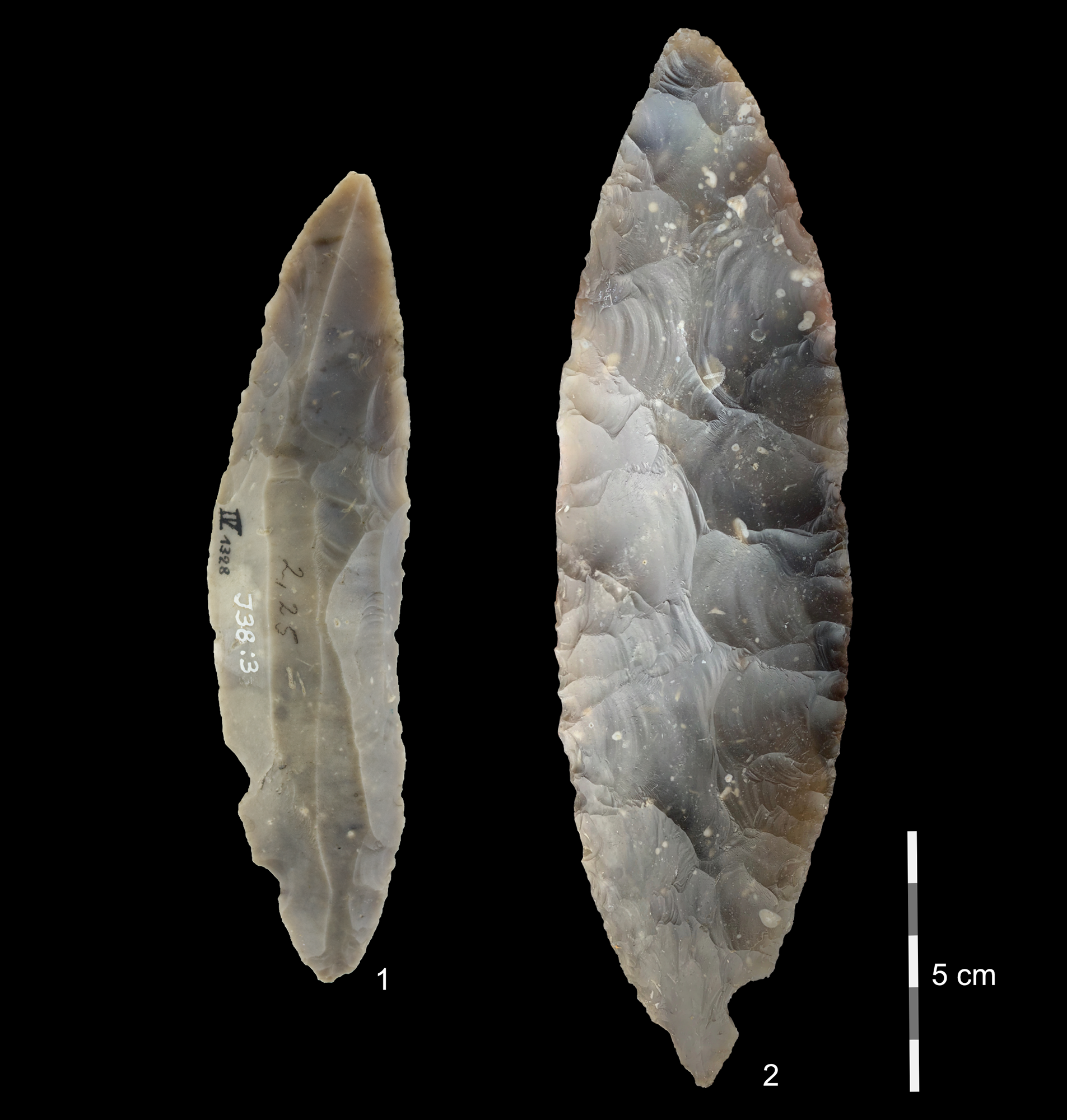
2024 Sports Registrations Open: Rugby League, Rugby Union, Soccer, Netball, Surfing - Details + Links
North Avalon Surfriders Association: NASA 2024 Registration Is Now Open.

Rugby League Registration For 2024 Season
Avalon JRLFC 2024 Registration
- Mixed boys and girls tackle teams for U6 – U12.
- Boys tackle teams for U13 – A-Grade.
- Girls blues tag teams for U12’s – U16’s.
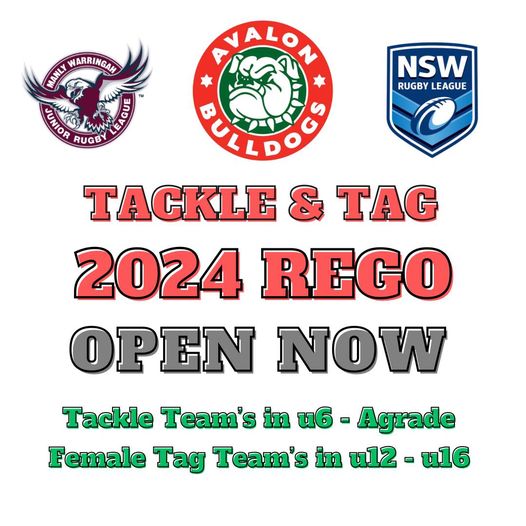
Mona Vale Raiders Rugby League Club
Narrabeen Sharks Rugby League


Soccer Registration For 2024 Season Now Open
Avalon Soccer Club

Pittwater RSL FC 2024 Registration Now Open

Narrabeen Football Club
Netball Registration For 2024 Season Now Open
Newport Breakers Netball Club 2024 Season Registration
- NetSetGo Competitions register here: https://www.playhq.com/netball-australia/register/c92c1e
- Junior Players aged 10-17 register here: https://www.playhq.com/netball-australia/register/be9c8a
- Senior Players aged 18+ register here: https://www.playhq.com/netball-australia/register/be9c8a
Narrabeen Youth Club Netball
Mona Vale Commodores Netball
- Sun 4 Feb 2024 11am to 1pm, Come and Try Netball at Pittwater New Life Gym
- Sun 4 Feb 2024 2pm to 4pm, In Person Uniform and Registration day at Mona Vale Community Centre
- TBC between 17 to 21 Feb 2024 Commodores U10 Grading day TBC
- March 9, time tba MWNA U10 Grading Day Curl Curl
Peninsula Netball Club
- NetSetGO https://www.playhq.com/netball-australia/register/3db4d5
- Juniors / Cadets / Seniors https://www.playhq.com/netball-australia/register/fcc8c5
 Registrations are open for juniors, cadets, and seniors until 30 January and for NetSetGO 14 February.
Registrations are open for juniors, cadets, and seniors until 30 January and for NetSetGO 14 February. Rugby Union
Newport Breakers Rugby Club
Newport Junior Rugby Club
Narrabeen Tigers Junior Rugby Club
Warringah Rats Women's Rugby Union 2024
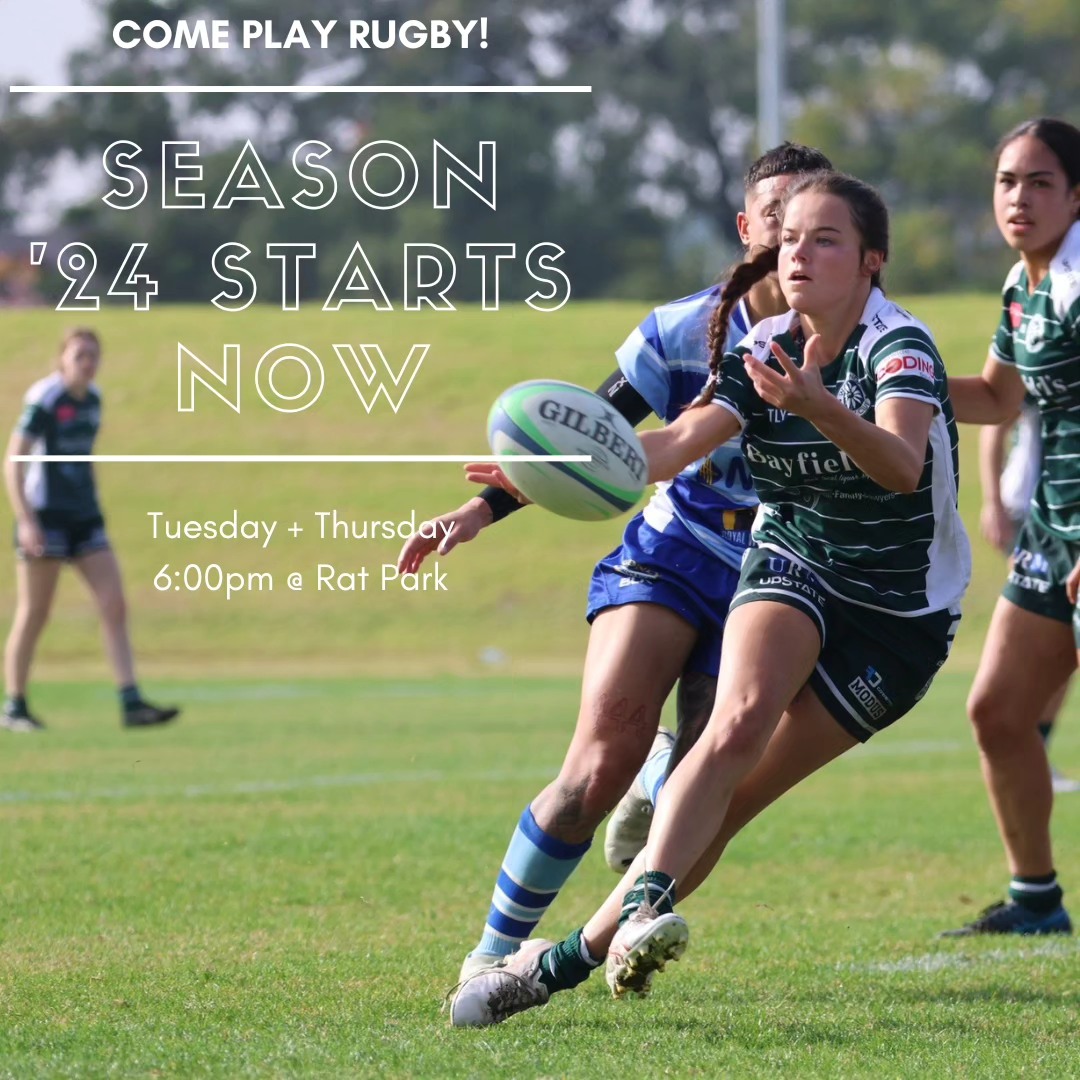
Applications Open For Study Subsidies To Boost NSW Healthcare Workforce
2024 Youth Parliament NSW Applications Now Open
The next generation of youth leaders is invited to apply to participate in the Y NSW's Youth Parliament program in 2024 with submissions now open.
Young people in Years 10, 11 and 12 (or equivalent age) in all 93 NSW state electorates are invited to express interest.
The Y (formerly YMCA) Youth Parliament provides a unique platform for individuals to actively participate in the democratic process and advocate for issues that they are passionate about.
The Y NSW is calling on young people from across the state to get involved. No experience is required, and people from diverse backgrounds are encouraged to apply, with financial sponsorships open to Aboriginal and Torres Strait Islander people, people living with a disability, individuals who identify as LGBTQIA+, those experiencing financial hardship, living in out-of-home care or rural areas, and refugee and asylum-seekers.
"At the Y, we believe in the power of inspired young people and Youth Parliament offers the opportunity for our youth to learn about the parliamentary system, develop critical thinking and public speaking skills, and engage in constructive debates about issues that matter to them and their communities," explained Executive Director/Interim CEO of the Y NSW Prue Warrilow.
"Participants will have the chance to draft, debate, and advocate for mock youth-focused legislation, gaining invaluable insights into the workings of government and policy development.
"Young parliamentarians also participate in a training camp in April and a sitting held in July in NSW Parliament next year. The Y then works actively to coordinate opportunities for the participants to present their Youth Bills to Ministers and other community leaders for consideration," continued Ms Warrilow.
Youth Parliament has supported more than 1,000 participants over the last decade with 97 per cent of participants surveyed saying they felt more empowered to advocate for issues in their local communities. Testament to the value of the program, former Youth Parliamentarians have gone on to become Members of Parliament and community leaders of influence and return to the Youth Parliament program as guests and mentors.
"We are particularly excited to welcome and encourage participation from young leaders of diverse backgrounds and those living in rural and remote communities, whose unique perspectives and experiences play a crucial role in shaping the discussions and policies at the Youth Parliament," added Ms Warrilow.
"Their active engagement and representation are vital in ensuring that the voices of all youth, regardless of location, are heard and considered in the decision-making processes that will affect our collective future," she continued.
17-year-old Cooma local Josh Abrokwah represented the Snowy Manaro region in the 2023 program and worked on a bill that addressed issues faced by migrants relocating to rural areas. Josh said he hopes the experience will enhance his academic career ambitions in international relations and praised the program for providing "activities such as mock debates, the chance to better our public speaking skills, and develop our parliamentary knowledge".
17-year-old Parramatta local, Rachel Lao was a 2023 Youth Parliament participant and is passionate about gender quality. Rachel was part of the NSW 2023 Women's Committee who put forward a bill to support mothers' reintegration into the workforce after maternity leave.
"The Youth Parliament program provides the unique opportunity to not only connect with people who have various perspectives, but who are willing to debate diplomatically about social issues," explained Ms Lao.
"I think that it's really encouraging to see the activism of our generation. Youth Parliament teaches participants how to lead and engage in debate that is productive and has the potential to make change.
"The connections and friendships I have made through Youth Parliament this year are invaluable and I know that my peers will be using their voices and actions to make change beyond their involvement in this program," she continued.
To apply to take part in the 2024 Youth Parliament, young people should visit ymcansw.org.au/community-services/youth/youth-parliament/ and submit their application before 9 February 2024.
School teachers and Members of Parliament can also nominate a young person.
School Leavers Support
- Download or explore the SLIK here to help guide Your Career.
- School Leavers Information Kit (PDF 5.2MB).
- School Leavers Information Kit (DOCX 0.9MB).
- The SLIK has also been translated into additional languages.
- Download our information booklets if you are rural, regional and remote, Aboriginal or Torres Strait Islander, or living with disability.
- Support for Regional, Rural and Remote School Leavers (PDF 2MB).
- Support for Regional, Rural and Remote School Leavers (DOCX 0.9MB).
- Support for Aboriginal and/or Torres Strait Islander School Leavers (PDF 2MB).
- Support for Aboriginal and/or Torres Strait Islander School Leavers (DOCX 1.1MB).
- Support for School Leavers with Disability (PDF 2MB).
- Support for School Leavers with Disability (DOCX 0.9MB).
- Download the Parents and Guardian’s Guide for School Leavers, which summarises the resources and information available to help you explore all the education, training, and work options available to your young person.
School Leavers Information Service
- navigate the School Leavers Information Kit (SLIK),
- access and use the Your Career website and tools; and
- find relevant support services if needed.
Word Of The Week: Positive
Adjective
1. consisting in or characterised by the presence rather than the absence of distinguishing features. 2. constructive, optimistic, or confident. 3. with no possibility of doubt; definite. 4. (of a quantity) greater than zero. 5. containing, producing, or denoting an electric charge opposite to that carried by electrons. 6. (of a photographic image) showing lights and shades or colours true to the original. 7. GRAMMAR; denoting the primary degree of an adjective or adverb, which expresses simple quality without qualification. 8. PHILOSOPHY; dealing only with matters of fact and experience; not speculative or theoretical. 9. ASTROLOGY; relating to or denoting any of the air or fire signs, considered active in nature.
Noun
1. a desirable or constructive quality or attribute. 2. a positive photographic image, especially one printed from a negative. 3. a result of a test or experiment indicating that a certain substance or condition is present or exists. 4. the part of an electric circuit that is at a higher electrical potential than another point designated as having zero electrical potential. 5. a number greater than zero. 6. GRAMMAR; an adjective or adverb in the positive degree.
From late Middle English: from Old French positif, -ive or Latin positivus, from posit- ‘placed’, from the verb ponere. The original sense referred to laws as being formally ‘laid down’, which gave rise to the sense ‘explicitly laid down and admitting no question’, hence ‘certain’.
"We didn't realise we were making memories we just knew we were having fun."
- Winnie the Pooh
Concussion in sport: why making players sit out for 21 days afterwards is a good idea
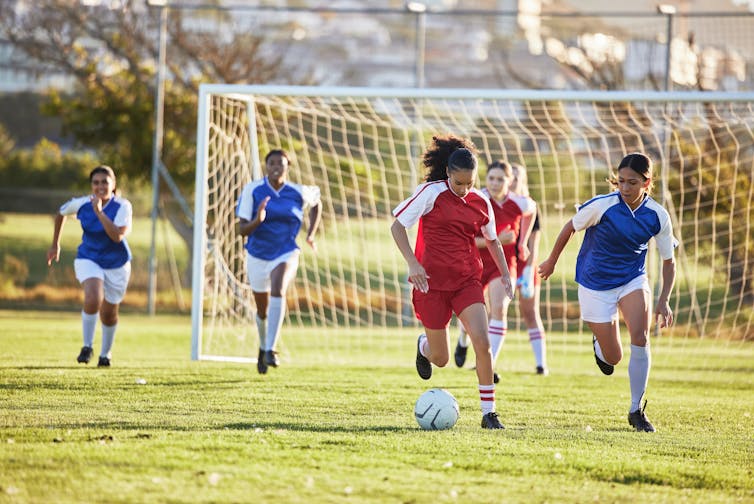
The Australian Institute of Sport (AIS) this week released new guidelines for youth and community sport designed to change the way concussion is managed across the country.
While the guidelines contain a host of recommendations about on-field concussion management and identifying symptoms, the biggest changes relate to how a concussion is managed after it happens.
Specifically, all players who sustain a concussion should be symptom-free for at least 14 days before restarting contact training. This was already the advice for children, but now applies to community sport too. And notably, all players should wait a minimum 21 days after being concussed to return to competition.
This is in contrast to the previous recommendations made by many Australian sporting organisations, which typically enforce a ten to 14 day minimum period before a concussed athlete can return to competition.
The new guidelines address a number of recommendations from last year’s Senate inquiry into concussions and repeated head trauma in contact sports. So what’s the rationale for having people sit out for longer?
The Dangers Of Concussion
Sport-related concussion has been defined as:
a traumatic brain injury caused by a direct blow to the head, neck or body resulting in an impulsive force being transmitted to the brain that occurs in sports and exercise-related activities.
Concussion in sport has become an increasingly hot topic in recent years – and for good reason. The effects of a concussion can include blood flow changes and inflammation affecting the brain.
In the short term, concussion can cause fatigue, light sensitivity and nausea, as well as more severe symptoms including behaviour change, loss of balance and coordination, and severe headaches.
There’s also some evidence to suggest repeated concussions can have long-term effects. These include lasting reductions in cognitive function (how people think, make decisions, and process information), and in some instances, an increased risk of dementia in older adulthood.

Concussion In Kids
Children who have previously had a concussion are almost four times more likely to get concussed in the future than those who have never been concussed before.
Similarly, our research has shown adolescent athletes who return from concussion are around 50% more likely to suffer any type of future injury than other athletes. My colleagues and I also found most athletes were returning to competition after roughly 12 days, which may suggest insufficient recovery is increasing their injury risk after concussion.
We don’t know the exact reason children and adolescents take longer to recover from concussion, but it seems they do.
Recent evidence has indicated that children, on average, may not be fully recovered and able to return to sport until around 20 days after concussion, while adults may be recovered after closer to 14 days. However, this is not true for everyone, with some taking much longer to recover.
A Step In The Right Direction
Taking these factors into consideration, I believe increasing the recovery period of concussion to 21 days is not only justified, but a positive step. While additional recovery time seems especially important for children, this change will also increase the likelihood adults playing community sport are ready to return, particularly if they don’t have access to medical guidance.
Most people in sport are happy to accept recovery from a muscle strain can take from four to eight weeks, so why wouldn’t they accept the brain (which is arguably a much more important part of the body) needs a shorter time?
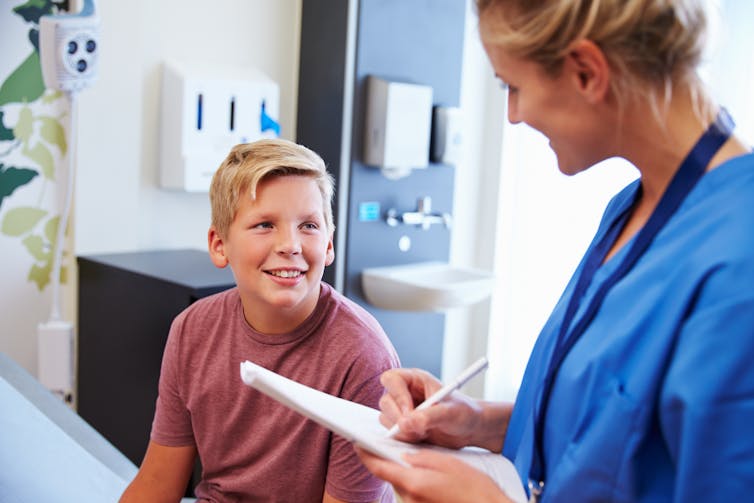
Australia is not the first country to tighten up its guidelines.
In April 2023, the first concussion guidelines for non-elite sport to cover the whole of the United Kingdom set out the same minimum recovery days.
Similar guidelines have also been implemented throughout New Zealand for a range of sports.
There’s no research examining whether these updated guidelines have had a positive effect yet, but given coming back too early may pose a risk, they offer very little downside.
Implementing The Guidelines
While these guidelines are positive for the health and welfare of athletes across the nation, there are also potential issues with their implementation – especially at the grassroots level where there may be few on-site medical staff.
The good news is, you don’t have to be an expert to reduce the effects of concussion.
The first step for those involved in community sport is simply being aware of the concussion management protocols the AIS proposes. This means making sure club staff know what the symptoms of concussion look like, and when to encourage their players to see a medical professional.
The second step, as recommended by the updated guidelines, is to introduce a “concussion officer” to oversee the management of concussion. This person doesn’t need to be a concussion expert and is not expected to diagnose concussion. Like the role of a fire warden, the concussion officer ensures anyone diagnosed with concussion follows the agreed protocol.
Lastly, when it comes to young athletes, when in doubt, sit them out. A more conservative approach is always best.![]()
Hunter Bennett, Lecturer in Exercise Science, University of South Australia
This article is republished from The Conversation under a Creative Commons license. Read the original article.
Banksias are iconic Australian plants, but their ancestors actually came from North Africa

Few plants conjure up the Australian bush better than banksias, whose beautiful flowers are irresistible to honeyeater birds, small marsupials and nature lovers.
But our research, published in Perspectives in Plant Ecology, Evolution and Systematics, shows that the ancestors of banksias actually migrated here from North Africa.
From early fossil pollen studies, we already knew that the protea family (Proteaceae), which includes banksias, grevilleas, waratahs and macadamias in Australia, originated in northwest Africa 130 million years ago.
Our task was to track their migration to Australia, where they became the unique symbols of the Australian bush that we admire today. To give credit where it’s due, we need to know where our natural heritage originated. So, how did this iconic group of plants get here?
Looking At The Entire Family
Our study relied on two approaches. We used a DNA assessment of the entire protea family to create an evolutionary tree. Then we inserted key fossil pollen records of a known age into the tree, to serve as a “molecular clock”. This helped us work out the time of origin of all genera in this family.
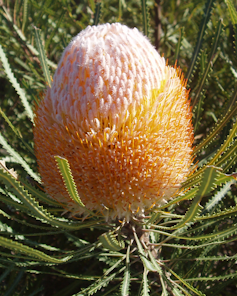
We then searched the literature for records of ancient sedimentary deposits that contain fossil pollen with affinities to banksias in Africa, South America, Antarctica (which was covered in forest until 40 million years ago) and Australia.
This was made possible by the fact the hard walls of pollen grains allow them to be preserved for millions of years. Also, the pollen grains of plants in the protea family are quite distinctive from those of other families. We then compared the dates and locations of the fossil pollen against our family tree.
This showed that by 120 million years ago, the ancestors of banksias had begun crossing into northeast South America. The two continents remained joined at their tips until 100 million years ago.
The plants then migrated down the east side of South America – first reaching the Scotia Isthmus about 110 million years ago – and crossed onto the Antarctic Peninsula.
Two Routes Into Australia
Here, the ancestors separated into two groups. One, the soft-leaved group, followed a cool-temperate rainforest pathway (dark for up to four months of the year) along the south side of Antarctica. They entered Australia via Tasmania from 105 million years ago.
The rainforest elements continued up the east coast, with some eventually reaching New Guinea; others entered New Caledonian rainforests directly from southern Antarctica. This route remained open until 45 million years ago, when Australia and Antarctica finally separated.
The other, hard-leaved group followed an open, fire-prone woodland pathway along the warmer, sunnier northern side of Antarctica. They entered Australia via the southwest tip that remained attached to Antarctica until about 70 million years ago.
The two points of entry were separated by a huge inland sea that occupied the Great Australian Bight during that period.
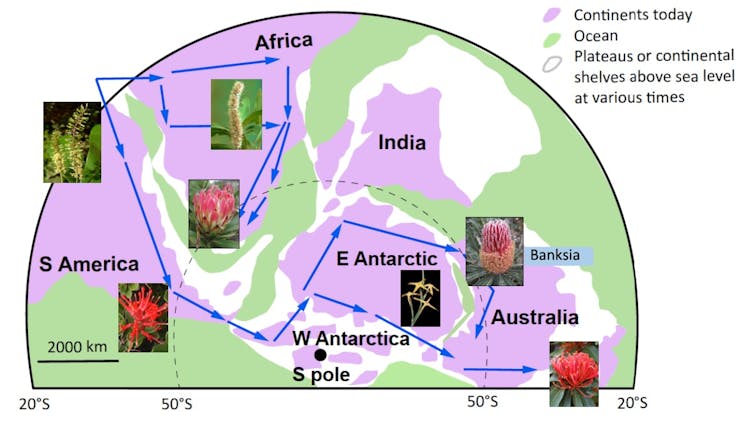
A Proliferation Of Banksias
Since banksia itself appears to have arisen 100 million years ago, the genus either evolved in northeast Antarctica or at the extreme corner of southwestern Australia. From there, they spread to the rest of Australia over the next 50 million years.
Banksias now consist of around 200 species, 90% of which are endemic to southwestern Australia. Ancestors of the bulk of the hard-leaved genera, such as grevilleas, hakeas, macadamias and waratahs, also entered Australia via the southwestern tip. They then migrated east along the margins of the Nullarbor Plain – thickly vegetated back then – to southeast Australia.
Until the results of our new study, it was believed the protea family arose in Australia and spread from here to Africa, South America, New Caledonia and Asia. Almost all migration would have needed to be over the oceans, as it was thought to have happened after the breakup of the Gondwanan supercontinent.
In fact, the journey was entirely overland as it occurred when Gondwana was largely intact, except for the early departure of Greater India.
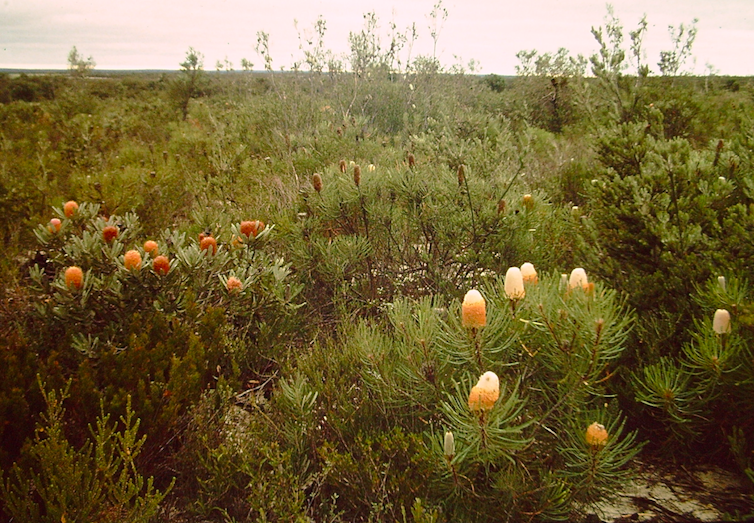
Plants Out Of Africa
Anthropologists are keen to point to the “out of Africa” hypothesis for the origin and migratory history of humans. It now appears such a hypothesis is equally applicable to some important groups of plants.
This is the first time the southwest corner of Australia has been recognised as a major migratory route for the protea family.
We now need to take seriously the Antarctic–southwest Australian link as a likely major entry route for many other hard-leaved plant groups into Australia. They could have originated in Antarctica and South America, and possibly even Africa.
This north Antarctic pathway might well also apply to eucalypts, whose oldest records are for southern South America, as well as currently endemic animals and microbes.![]()
Byron Lamont, Distinguished Professor Emeritus in Plant Ecology, Curtin University; Lynne Milne, , Curtin University; Richard Cowling, Professor, Nelson Mandela University, and Tianhua He, Senior lecturer, Murdoch University
This article is republished from The Conversation under a Creative Commons license. Read the original article.
The first flowers evolved before bees – so how did they become so dazzling?
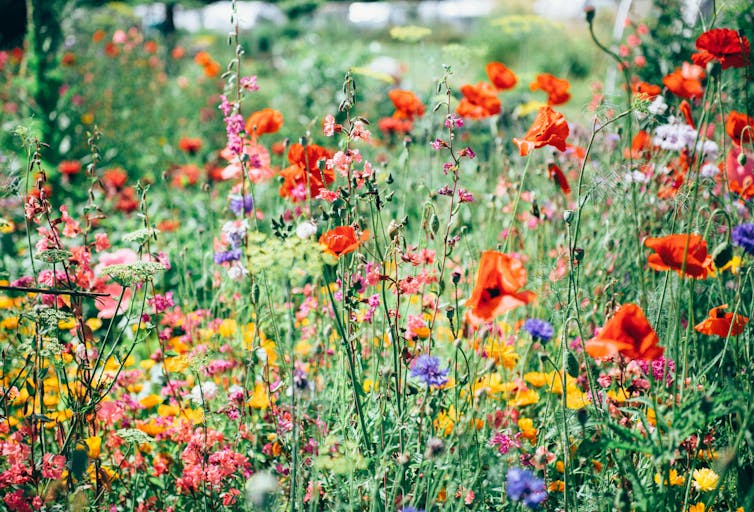
Colourful flowers, and the insects and birds that fly among their dazzling displays, are a joy of nature. But how did early relationships between flower colour and animal pollinators emerge?
In a study published in Proceedings of the Royal Society, we have unravelled this mystery by analysing the visual environments in which the ancestors of today’s bees foraged from flowers.
We measured and analysed the light reflected from today’s flowers, as well as the rocks, soil, sticks, bark and leaves that form their natural backgrounds.
From this data we built computer simulations that recreate the ancient visual environment when the first flowers emerged.
Insect Colour Vision Came Before Flowers
Today, bees are prolific pollinators of flowering plants, including food crops. Bees use colour vision based on ultraviolet, blue and green sensitive photoreceptors (light-sensing cells) to detect and discriminate the most rewarding flowers. In comparison, most humans perceive colour using blue, green and red sensitive photoreceptors.
When the first flowers evolved during the Mesozoic era, between 252 million and 66 million years ago, the ancestors of bees had to orientate themselves, maintain stable flight, avoid collisions, and find food among natural backgrounds. We suspect their visual systems may have been influenced by evolution to efficiently operate in that environment.
By the time the first flowering plants appeared, bees’ ancestors had already evolved colour vision – and we know it has stuck around throughout the evolutionary history of bees.
So, while bees weren’t initially around, their ancestors were. Flower colours likely evolved the vivid colours we see today to suit this ancient visual system. At the same time, the first bees emerged as the most efficient pollinators.
What Colour Were Flower Backgrounds On The Ancient Earth?
Australia is an ideal place to collect data on natural background materials that early insects would have seen, as it is a geologically ancient continent.
We collected background samples from across Australia and measured their reflective properties using a tool called a spectrophotometer.
We used this data to create a database of materials that would have been present in the visual environment of flying insects more than 100 million years ago – when the first flowers appeared.
Flower Colour Evolved In Response To Bee Colour Vision
For our collection of natural backgrounds, insect and bird pollinated flowers, we calculated marker points – rapid changes in the intensity of light reflected from a surface, within a small wavelength band.
These marker points identify the key visual features of coloured surfaces, and we can use them for statistical testing of the evolutionary process.
We then wrote computer simulations to generate possible flower backgrounds. By analysing their marker points, we tested the visibility of today’s flowers against the simulated backgrounds.
Interestingly, we showed that the distribution of marker points on petals from plants pollinated by bees clearly indicates these flowers are “salient” – that is, they stand out as stronger signals from natural backgrounds.
This finding matches with previous studies suggesting that in the Northern Hemisphere and Australia, flowering plants evolved colour signals to facilitate colour perception by bees.
The very first flowers were likely a dull greenish-yellow colour and initially pollinated by flies. However, as the first bees – with their tuned vision systems – started pollinating flowers, the flowers likely evolved new colours to match the bees’ visual capabilities.
The process of natural selection seems to have driven flower colours to stand out from their backgrounds in the eyes of pollinators.
Birds Were Involved, Too
Birds became established as flower visitors millions of years after insect pollination evolved. Bird vision uses four types of colour photoreceptors, and they can see long-wavelength red colours that bees cannot easily process against natural backgrounds.
Our analysis confirmed that bird-pollinated flowers evolved marker points towards longer wavelengths than bee-pollinated flowers. Our new discovery also showed that these flowers systematically differ from natural backgrounds.
As Earth’s climate changes, it is important to consider what might happen to ecosystems and our food production systems in a world without bees. It is vital that we understand how pollination and plant reproduction may be altered.
Our research shows that bees are a major driver of floral evolution. Unless we protect these insects and their habitat, we will lose fundamental and beautiful aspects of life we all enjoy and need.![]()
Adrian Dyer, Associate Professor, Department of Physiology, Monash University; Alan Dorin, Associate Professor, Faculty of Information Technology, Monash University; Jair Garcia, Researcher and analyst, Monash University, and Mani Shrestha, Senior Researcher and International Fellow, Disturbance Ecology, University of Bayreuth, Germany, Bayreuth University
This article is republished from The Conversation under a Creative Commons license. Read the original article.
Playing a musical instrument or singing in a choir may boost your brain – new study
Michael Hornberger, University of East AngliaGenerations of parents have told their children to practice their musical instruments. Parents have good reason to keep on top of their children’s musical education, since learning an instrument is not only associated with better educational attainment but also cognition (thinking) and even intelligence scores in children. But does this musicality translate to better cognition later in life?
A recent study in the International Journal of Geriatric Psychiatry investigated this question by asking middle-aged and older people to complete a questionnaire on their lifetime musical experience before completing cognitive (thinking) tests. The results showed that musical people had better memory and executive function (the ability to stay focused on tasks, plan and have self-control) than those with less or no musicality.
A good memory is important for playing a musical instrument, such as playing music from memory, and this seems to translate to people’s cognitive performance. Similarly, executive function is required when playing an instrument, and this too translated to improved cognitive performance.
This finding was similar, regardless of which instrument people played or the level of musical proficiency people acquired – although most people in the study played an instrument for only a few years of their lives.
What made a difference, however, was whether people still played an instrument or only played in the past, with current amateur musicians showing the highest cognitive performance of participants.
This makes sense as continued engagement in cognitively stimulating activities, such as playing an instrument, should result in continued brain health benefits, whereas having played the recorder for three years at primary school might not have that big an impact on our cognitive performance later in life. But how about being musical without playing an instrument?
Singing is a very popular musical activity as it allows joining musical groups, such as choirs, without the need to learn a musical instrument. But does singing provide the same cognitive benefit as playing an instrument?
According to the study findings, singing can result in better executive function but not memory, suggesting that playing an instrument has additional brain health benefits.
Why singing would help us with our executive function is not clear and requires further investigation. However, singing has a strong social benefit when done in choirs, and there is good evidence that being engaged in social activity is good for our brain health.
The ‘Mozart Effect’
How about just listening to music? Does it also improve our cognition and potentially brain health?
Many people might remember the famous “Mozart effect”, which was based on a study published in Nature in 1993 showing that when students were played Mozart, they scored higher on intelligence tests.
This led to a whole industry promising us that playing such music to ourselves or even our babies could lead to cognitive benefits, even though the evidence for the original study is still controversially discussed to this day.

Sadly, the current study found no association between listening to music and cognitive performance. Cognitive stimulation depends on us being actively engaged in activities, so passively listening to music doesn’t seem to provide any cognitive benefits.
Playing an instrument or singing seems to have benefits to our brain health in ageing, according to the study. What is yet to be established is whether this would also help prevent future cognitive decline or dementia.
The study provides no evidence for this yet and it is also not clear how the findings apply to the general population, since most people in the study were female, well-educated and well-off.
Still, considering the overall cognitive and social benefits of learning an instrument or singing in a choir, it might be worth engaging in such cognitive stimulation as we age. Our parents would be proud of us.![]()
Michael Hornberger, Professor of Applied Dementia Research, University of East Anglia
This article is republished from The Conversation under a Creative Commons license. Read the original article.
According to Ireland’s constitution, a woman’s duties are in the home – but a referendum could be about to change its sexist wording

On March 8 – International Women’s Day – Irish citizens will vote in a referendum on whether or not to replace the so-called “woman in the home” clause in the Irish constitution.
This clause, which dates from 1937, specifies that: “The State recognises that by her life within the home, woman gives to the State a support without which the common good cannot be achieved.” It goes on to say that: “The State shall, therefore, endeavour to ensure that mothers shall not be obliged by economic necessity to engage in labour to the neglect of their duties in the home.”
Originally, the purpose of the provision was to acknowledge the importance of care in the home, which was then provided almost exclusively by mothers. The purpose was to ensure that mothers could remain in the home and would not be forced to work due to financial reasons.
However, the state help implied by the wording was never actually put into practice – women were never supported to provide care in the home. Worse, the constitution was often used to bolster arguments that a woman’s place was in the home and that policies which excluded women from work were acceptable.
Now, as part of a double referendum, Irish citizens will have the chance to change the constitution to a more gender-neutral wording. This is alongside another vote on whether to change the constitution’s definition of “family” to expand it beyond marriage.
What’s At Stake?
Some confusion seems to have arisen ahead of the referendum, with some groups arguing that removing the reference to women will mean removing any right of women to stay at home and raise their children.
However, the reality is that the provision has never resulted in any rights for women to remain in the home. Nor has it resulted in any economic duty on the state to provide for those who wish to do so. This is primarily due to the wording which only requires the state to “endeavour” to provide such support.
That effectively means the government only has to make an effort – not that it is obliged to help. In fact, any attempts to use the provision to provide for such rights have failed in the courts. So, the current provision is not only an anachronism but a useless one. It has never had any positive legal effect. We are instead left with the declaration, in the most basic law of the state, that women (and not men) have duties they are expected to attend to in the home.
This part of the constitution has long been controversial and there have been many recommendations to either delete or replace it. The most recent of these came from a citizens’ assembly established for the very purpose of advising on the fate of the clause.
In 2022, this assembly voted to replace the clause with a gender-neutral alternative. But the assembly also wanted the words to have meaning rather than just being symbolic, so it proposed a wording that would oblige the state to take reasonable measures to support care, drawing on similar wording from the South African constitution. A parliamentary committee set up to consider the proposals also endorsed this wording.
However, the Irish government has decided to put a watered-down version to the people. The amendment being proposed in the referendum reads:
The State recognises that the provision of care, by members of a family to one another by reason of the bonds that exist among them, gives to Society a support without which the common good cannot be achieved, and shall strive to support such provision.
An Important Change – But An Opportunity Missed
The wording is a disappointment for those who had pushed for reform. While it replaces the gendered language and removes the implication that a woman’s proper place is in the home, it fails to commit the state to providing support for people who work in the home caring for others. They can no more expect to receive benefits or rights that compensate them for this essential work than they would have before the referendum.
The proposed text merely replaces the word “endeavour” with the word “strive”. This means it is unlikely to lead to any concrete rights or any legally recognisable duty on the part of the state.
So, while one historical anachronism looks set to be corrected in this referendum, Ireland is still essentially being asked to replace a non-operative clause containing outdated and patronising language with a new non-operative clause with slightly more acceptable language.
But disappointing though it may be that no positive rights or duties are likely to ensue, the removal from the constitution of a 1930s mentality that does not reflect in any way the reality of Irish life in the 21st century is at least an improvement – and surely worth a yes vote.![]()
Laura Cahillane, Associate Professor of Law, University of Limerick, University of Limerick
This article is republished from The Conversation under a Creative Commons license. Read the original article.
Neuralink has put its first chip in a human brain. What could possibly go wrong?

Earlier this week, Elon Musk announced his brain-computer interface company, Neuralink, had implanted a device in a human for the first time. The company’s PRIME study, approved by the US Food and Drug Administration last year, is testing a brain implant for “people with paralysis to control external devices with their thoughts”.
In the past few years, Neuralink has faced investigation for mistreatment of lab animals and seen the departure of several company executives. Nevertheless, the PRIME trial is a significant milestone for a company less than ten years old.
However, Neuralink’s challenges are far from over. Implanting a device is just the beginning of a decades-long clinical project beset with competitors, financial hurdles and ethical quandaries.
Decades Of Development
The first reported demonstration of a brain-computer interface occurred in 1963. During a lecture at the University of Oxford, neuroscientist William Grey Walter bewildered his audience by linking one of his patient’s brains to the projector, where they advanced the slides of his presentation using only their thoughts.
However, the current wave of exploration in using brain-recording techniques to restore movement and communication to patients with severe paralysis began in the early 2000s. It draws on studies from the 1940s which measured the activity of single neurons, and more complex experiments on rats and monkeys in the 1990s.
Neuralink’s technology belongs to the next generation of recording devices. These have multiple electrodes, greater precision, and are safer, longer-lasting, and more compatible with the body. The Neuralink implant is thinner, smaller and less obtrusive than the “Utah array” device, widely used in existing brain-computer interfaces, which has been available since 2005.
Neuralink’s device is implanted by a special robot which rapidly inserts polymer threads, each containing dozens of electrodes. In total, the device has 3,072 electrodes – dwarfing the 100 electrodes of the Utah array.
Competitors
Neuralink faces stiff competition in the race to commercialise the first next-generation brain-computer interface.
Arguably its most fierce competitor is an Australian company called Synchron. This Melbourne-based start-up recently used a microelectrode mesh threaded through the blood vessels of the brain. This allowed paralysed patients to use tablets and smartphones, surf the internet, send emails, manage finances (and post on X, formerly Twitter).
The Synchron implant is described as a “minimally invasive” brain-computer interface. It requires only a minor incision in the neck, rather than the elaborate neurosurgery required by Neuralink and most other brain-computer interfaces.
In 2021, Synchron received a “Breakthrough Device Designation” in the United States, and is now onto its third clinical trial.
Patient Welfare
This competitive landscape raises potential ethical issues concerning the welfare of patients in the PRIME study. For one, it is notoriously difficult to recruit participants to neural implant studies. Patients must meet strict criteria to be eligible, and the trials are inherently risky and ask a lot of participants.
Musk’s public profile may help Neuralink find and enrol suitable patients. However, the company will need to be prepared to provide long-term support (potentially decades) to patients. If things go wrong, patients may need support to live with the consequences; if things go right, Neuralink may need to make sure the devices don’t stop working.
In 2022, a company called Second Sight Medical Product demonstrated the risks. Second Sight made retinal implants to treat blindness. When the company went bankrupt, it left more than 350 patients around the world with obsolete implants and no way to remove them.
If Neuralink’s devices are successful, they are likely to transform patients’ lives. What happens if the company winds up operations because it can’t make a profit? A plan for long-term care is essential.
What’s more, the considerable hype surrounding Neuralink may have implications for obtaining informed consent from potential participants.
Musk famously compared the implant to a “Fitbit in your skull”. The device itself, Musk recently revealed, is misleadingly named “Telepathy”.
This techno-futurist language may give participants unrealistic expectations about the likelihood and kind of individual benefit. They may also underappreciate the risks, which could include severe brain damage.
The Way Forward
In this next chapter of the Neuralink odyssey, Musk and his team must maintain a strong commitment to research integrity and patient care. Neuralink’s establishment of a patient registry to connect with patient communities is a step in the right direction.
Long-term planning and careful use of language will be necessary to preventing harm to patients and families.
The nightmare scenario for all neurotechnology research would be a repeat of Walter Freeman’s disastrous pre-frontal lobotomy experiments in the 1940s and 1950s. These had catastrophic consequences for patients and set research back by generations.![]()
Nathan Higgins, PhD candidate in Psychology, Monash University
This article is republished from The Conversation under a Creative Commons license. Read the original article.
Hidden women of history: Olympias, who took on an emperor, dodged a second marriage and fought for her faith

Olympias was born to a wealthy family in the fourth-century CE, probably in the capital city of the Roman empire: Constantinople (now Istanbul).
Not to be confused with the mother of Alexander the Great (who lived around 800 years earlier), this Olympias is remembered in various texts as a patron of the church and a champion of female ascetics, a determined advocate for her friends, and a faithful and dedicated Christian.
A sad fact about the early Christian period is that very few texts written by women survive. Olympias was well educated and acquainted with bishops and even the emperor. We know she wrote letters to some of these men, but only the men’s letters to her remain.
There are stories about her life as well, and some about her monastery and her bodily remains after her death, but most of these were also written by men. Nevertheless, these sources can give us insight into the life of a formidable woman who opposed the emperor and fought for her way of life and her faith.
A Husband Chosen
When Olympias was born, in the second half of the fourth century, the Roman Empire was rapidly becoming more Christian. The emperor Constantine (306-337) had converted to Christianity in 312, legalising the religion a year later and promoting it through patronage of the church. His nephew, the emperor Julian (361-363), briefly tried to restore the empire to Roman religion (“paganism”) but his reign was short and his religious campaign unsuccessful.
Olympias was orphaned as a child. When she was between the ages of 12 and 15, her guardian chose a suitable husband for her. Nebridius was the prefect of the city of Constantinople, roughly equivalent to a city mayor. This was his second marriage. According to some sources, his son from his first marriage was older than Olympias. She is unlikely to have had much say in the match.
Olympias’s family was wealthy and she would have taken a substantial dowry with her on marrying. The law decreed Nebridius had to keep that fortune safe for her as a dowry for a second husband in case of his death. And indeed, Nebridius lived less than two years after their marriage. Olympias was now a widow and probably only about 17.
When she was widowed, according to an anonymous Life of Olympias, the emperor Theodosius tried to marry her off to a relative of his named Elpidius. Her extensive wealth - she owned property all over the empire including palaces in Constantinople – made her quite a catch.
But Olympias refused, apparently declaring
if the Lord Jesus Christ had wanted me to live with a man, he would not have taken away my first husband.
A Celibate Life
She told the emperor she wanted to live a celibate life as a monastic rather than marry again.

This, at least, is the way the Life presents it. We cannot be certain this is an accurate representation of Olympias’s interactions with the emperor. Given the life she went on to lead, it seems clear she had a particular devotion to God and a strong desire to live an ascetic, celibate life.
But there are other reasons in this period why a young widow might not want to marry again. Mortality rates for women in childbirth were high, as were infant mortality rates. If she married again, she might die in childbirth, or her child might die soon after.
There were good theological reasons to remain unmarried too. There were debates in the early church about whether a second marriage counted as adultery and many theologians encouraged women to remain a univira – a “one-man woman”.
Perhaps Olympias was also keen to maintain some financial independence. Another marriage would bring her squarely under the authority of another man. Perhaps she hoped by remaining a widow she could use her wealth as she saw fit.
If this was her aim, she was disappointed. When Olympias refused to marry Elpidius, the emperor Theodosius commanded the prefect of the city, Clementius, be guardian of all her possessions until Olympias turned 30.
A Determined Young Woman
The Life gives Olympias a pithy reply in which she says she is glad to be relieved from the burden of her wealth and begs Clementius to distribute her wealth to the poor and the churches.
This fifth century CE text presents Olympias as a determined young woman who is not afraid to advocate for herself and fight to live her chosen way of life.
A few years later, Theodosius relented when he saw how dedicated Olympias was to the ascetic life, restoring her fortune. This enabled Olympias to establish a monastery or holy house for women in Constantinople.
She built it right next to the cathedral church of Hagia Sophia (Holy Wisdom) and lived there with many other female ascetics. The proximity of the monastery to the church is likely one of the reasons that Olympias became such close friends with the bishop John Chrysostom. John, who became archbishop (Patriarch) of Constantinople, was given the name “Chrysostom” (“Golden-Mouth”) because he preached fabulous sermons. Over 700 of his sermons survive.

Olympias was ordained a deaconess by the archbishop Nectarius when only around 30. (It was unusual to be made a deaconess before the age of 60.) Such a role gave Olympias the authority to act for, and on behalf of, women in the church, as the guide and protector of the women who came to join her in her holy house.
She used her wealth and new status as deaconess to support the poor and the works of the church, becoming a strong advocate for Chrysostom. She became a patron and friend of other bishops too.
When Gregory of Nyssa, theologian and bishop in Cappadocia, wrote a commentary on the Song of Songs, around the year 394, he dedicated it to Olympias. She had suggested he should write it:
You have enjoined upon me, both in person and by your letters, a study of the Song of Songs, and I have undertaken it because it is suited to your holy life and your pure heart.
An Advocate For Her Friend
When Chrysostom was sent into exile, for reasons that remain a bit unclear, he wrote regularly to Olympias. Seventeen of his letters to her survive, more than from him to any other person. She kept advocating for him and was angry with those who had deserted him.
Chrysostom told her Jesus’ friends had also deserted him. He was impressed by Olympias’s perseverance even under suffering – her ill health didn’t stop her from being a “tower”, a “haven” and a “wall of defence”.
Perhaps he was referring to the protection Olympias gave to monks who had been banished for their support of Chrysostom. When an ally was imprisoned, Chrysostom wrote to Olympias to strategise about how to get him released.
These actions, protecting the supporters of the exiled bishop, were ultimately Olympias’s downfall. She was persecuted, wrongfully accused of causing a fire in the city and sent into exile to Nicomedia (modern Izmit, Turkey) where she died, probably in 409.
A Significant Figure
Although she died in exile, Olympias was a significant figure who fought against the mould women were supposed to fit into, supporting a lot of people along the way.
The anonymous Life describes her as practising hospitality in a similar way to the Old Testament patriarch Abraham, fighting for self-control like Joseph, suffering patiently and faithfully like Job and being martyred like the legendary early Christian, Thecla.
In the seventh century, a woman named Sergia became the leader of Olympias’s monastery in Constantinople. Sergia wrote about finding Olympias’s bones in the wreckage of another monastery and bringing them back to her own.
When a later Patriarch anointed the remains, Sergia says, they bled until his hands were full of blood.
This rather frightening miracle had a big impact on the assembled audience. Sergia records many people were cured of diseases by Olympias’s remains after this bloody episode.
Such miracle stories, which seem so strange to us, show Olympias’s continued importance in the monastery she founded and the city which was her home.![]()
Sarah Gador-Whyte, Research Fellow in Biblical and Early Christian Studies, Australian Catholic University
This article is republished from The Conversation under a Creative Commons license. Read the original article.
Australia’s young people are moving to the left – though young women are more progressive than men, reflecting a global trend
Intifar Chowdhury, Flinders UniversityRecent research suggests a growing gender gap in political leanings around the world. In Gen Z, the youngest voting generation, young women are becoming more progressive than men.
Young Australian women, too, are significantly shifting towards the political left – but so are young Australian men, although at a relatively slower rate.
I’ve analysed data from the Australian Election Study, spanning 1996 to 2022, to find out what’s happening.
Just 24.3% of Millennials born between 1980 and 1994 – 21.9% of men and 25.7% of women – said they voted for the Coalition in 2022, representing the lowest level of support for either major party among younger people in the 35-year history of the Australian Election Study.
A slightly higher proportion of Gen Z voted for the Coalition: 24.6%, with a gender breakdown of 34.0% of men and 29.8% of women.
(These numbers will slightly vary based on exact generational definitions – birth-year boundaries – and whether non-voters are excluded from the analysis.)
I found that Australian Millennial and Gen Z men are more conservative than their female counterparts, but are more progressive than men of previous generations at the same stage of life. Across genders, these generations also report being in the political centre less than previous ones.
This runs counter to reported trends in most countries, where women have been shifting left “while men stand still”. In fact, in some countries like Germany, signs suggest young men are moving right.
A Global Youth Political Gender Gap
A substantial global gender gap has opened in the past six years, following decades of roughly equal ideological distribution. Young American women aged 18-30 are now 30 percentage points more liberal than their male peers, according to US Gallup data.
Germany reflects a similar 30-point divide, while the UK sees a 25-point gap.
In 2022, almost half of Polish men aged 18-21 supported the far-right Confederation party, in contrast to just a sixth of women in that age group. In Germany, there are signs young men under 30 are moving towards the far-right Alternative for Germany (AfD), actively opposing immigration more than their elders.
The pattern is reflected beyond the West, too. It is evident in China, Tunisia and South Korea – where, in the 2022 election, young men backed the right-wing People Power party and young women backed the liberal Democratic party.
In all these cases, the dramatic divide is either exclusive to the youngest generation or is far more pronounced than the gender gap in older generations.
How I Reached My Findings
After each federal election, the Australian Election Study survey asks respondents to place themselves on an 11-point ideological scale, where 0 is extreme left, 10 is extreme right, and 5 is often interpreted as neither left nor right (the political centre).
I analysed this data, using six generational categories.
They were:
- War generation (born 1920s and came of age during WWII – 1,305 participants)
- Builders (born between 1930 and before the end of the WWII – 4,133 participants)
- postwar Baby Boomers (born 1946–1960 - 6,651 participants)
- Gen X (born 1961-1979 - 5,229 participants)
- Millennials or Gen Y (born 1980–1994 - 1,672 participants)
- Gen Z (born after 1994 – a smaller size of 264 participants, which requires caution in statistical conclusions).
A person’s position on the ideological scale is influenced by their age, gender and education.
Women’s Move To The Left
In Australia’s 2022 election, the Coalition received its lowest-ever share of the women’s vote – just 32%. Conversely, the Labor party attracted more women than men (albeit to a lesser extent).
Reasons included a fierce rise in feminist views following the global #MeToo movement, the Liberal government’s poor response to sexual assault claims, and the mistreatment of women within the Liberal party and the parliament.
This reflects the global analysis reported by The Financial Times: the #MeToo movement has empowered young women worldwide to embrace fiercely feminist values, influencing their political outlook.
But the Coalition’s loss of support among women is not isolated to the 2022 election: it’s been happening since the early 2000s.
Men Moving Left Too – But In Lower Numbers
My analysis showed women are significantly more likely to be progressive than men. Across generations and political views, the gender gap has widened.
The most recent generation, Gen Z, appears to be the most progressive, with women in particular starkly preferring the left and placing themselves at the centre in dwindling numbers.
However, while Gen Z has more men than women on the right, it has less right-leaning men than any other generation – so it would be wrong to say our young men are rushing to the right, like in South Korea or Germany.
The Australian data mirrors international trends, with a slight twist. Over the past decades, and across generations, Australian men and women have been moving to the left and away from the right. At the same time, they have moved away from the centre (though this is more pronounced for women).
Despite the gender gap, they are heading in the same direction.
Exploring the connection between gender and generation, I tailored my analysis to see what happened when other factors that influence political leanings were taken into account, like educational attainment, marital status and home ownership.
Gender remained a significant influence, though this varies depending on the generation, with some generations more gender-divided than others.
Tertiary education was also significant. Women with a tertiary education are likely to be more progressive than those without one. The same applies to men, although to a lesser extent.
Men and women who are married and own a home are more conservative in their political views. Income itself is neither substantial, nor significant in its effect.
Implications For Australian Politics
The gender gap, along with many other factors, is reshaping how young Australians engage with politics. Acknowledging and addressing this divide is a vital step towards fostering an inclusive and representative democracy.
As better educated, younger women become a formidable force in shaping political landscapes, political parties risk losing touch with this influential segment if they fail to address gender-specific issues, such as those related to education, healthcare, childcare, and workplace equality.
The Coalition is definitely on notice, but all political parties must adapt their strategies to align with the evolving demographics.
The move to the left may not stop at left-of-centre parties, but continue further left, towards the Greens for example. Generational replacement may not necessarily continue to favour the Labor party if their party positions do not speak to young women in the next election.
Note: I wrongly synonymise “sex” and “gender” in my analyses, because survey research is yet to properly acknowledge and capture the gender diversity that exists in our society. However, I note it is impossible to truly understand the gender gap (and the progressive direction of younger people’s leanings) in politics if we continue to discuss the “modern” gender gap while still “traditionally” defining gender as a binary concept. ![]()
Intifar Chowdhury, Lecturer in Government, Flinders University
This article is republished from The Conversation under a Creative Commons license. Read the original article.
Taylor Swift deepfakes: new technologies have long been weaponised against women. The solution involves us all
Nicola Henry, RMIT University and Alice Witt, RMIT UniversitySexually graphic “deepfake” images of Taylor Swift went viral on social media last week, fuelling widespread condemnation from Swifties, the general public and even the White House.
This problem isn’t new. Swift is one of many celebrities and public figures, mainly women, who have fallen victim to deepfake pornography in recent years. High-profile examples garner significant media attention, but the increasingly sophisticated nature of AI means anyone can now be targeted.
While there are grave concerns about the broader implications of deepfakes, it’s important to remember the technology isn’t the cause of abuse. It’s just another tool used to enact it.
Deepfakes And Other Digitally Manipulated Media
The sexually explicit deepfakes of Swift appeared on multiple social media platforms last week, including X (formerly Twitter), Instagram, Facebook and Reddit.
Most major platforms have bans on sharing synthetic and digitally manipulated media that cause harm, confusion or deception, including deepfake porn. This includes images created through simpler means such as photo-editing software. Nonetheless, one deepfake depicting Swift was viewed 47 million times over a 17-hour period before it was removed from X.
There’s a long history of digital technologies, apps and services being used to facilitate gender-based violence, including sexual harassment, sexual assault, domestic or family violence, dating abuse, stalking and monitoring, and hate speech.
As such, our focus should also be on addressing the problematic gender norms and beliefs that often underpin these types of abuse.
The Emergence Of Deepfakes
The origins of deepfakes can be traced to November 2017 when a Reddit user called “deepfakes” created a forum and video-editing software that allowed users to train their computers to swap the faces of porn actors with the faces of celebrities.
Since then, there’s been a massive expansion of dedicated deepfake websites and threads, as well as apps that can create customised deepfakes for free or for a fee.
In the past, creating a convincing deepfake often required extensive time and expertise, a powerful computer and access to multiple images of the person being targeted. Today, almost anyone can make a deepfake – sometimes in a matter of seconds.
The Harms Of Deepfake Porn
Not all applications of AI-generated imagery are harmful. You might have seen funny viral deepfakes such as the images of Pope Francis in a puffer jacket. Or if you watch the latest Indiana Jones film, you’ll see Harrison Ford “de-aged” by 40 years thanks to AI.
That said, deepfakes are often created for malicious purposes, including disinformation, cyberbullying, child sexual abuse, sexual extortion and other forms of image-based sexual abuse.
A report published by startup Home Security Heroes estimated there were 95,820 deepfake videos online in 2023, a 550% increase since 2019.
When it comes to deepfake porn, women in particular are disproportionately targeted. According to DeepTrace, 96% of all deepfakes online are non-consensual fake videos of women. These are mostly (but not exclusively) well-known actors and musicians.
This is concerning but not surprising. Research shows online abuse disproportionately affects women and girls, particularly Indigenous women, women from migrant backgrounds and lesbian, gay, bisexual, transgender and intersex people.
Public figures in particular face higher rates of online abuse, especially women and gender-diverse people. One study found celebrities are attributed more blame than non-celebrities for the abuse they receive online, and this abuse is often viewed as less serious.
Research shows image-based abuse can result in significant harms for victims, including anxiety, depression, suicidal ideation, social isolation and reputational damage. For public figures, deepfakes and other forms of online abuse can similarly result in diminished career prospects, withdrawal from public life and negative mental health outcomes.
In 2016, Australian activist and law reform campaigner Noelle Martin’s photos were taken from social media and superimposed onto pornographic images. Martin reported feeling “physically sick, disgusted, angry, degraded, dehumanised” as a result. Digitally altered and deepfake images of Martin continue to circulate online without her consent.
Responding To Deepfake Porn
Anyone can be targeted through deepfakes. All that’s needed is an image of someone’s face. Even professional work images can be used.
Although law reform alone won’t solve this socio-legal problem, it can signal the issue is being taken seriously. We need laws specifically targeting non-consensual deepfake porn.
In Australia, there are image-based sexual abuse offences in every Australian state and territory except Tasmania, as well as at the federal level. However, only some laws specifically mention digitally altered images (including deepfakes).
Technology companies could also do a lot more to proactively detect and moderate deepfake porn. They need to prioritise embedding “safety by design” approaches into their services from the outset. This could mean:
- designing and testing AI with potential misuses in mind
- using watermarks and other indicators to label content as synthetic
- “nudging” users to refrain from certain behaviours (such as using pop-ups to remind them about the importance of consent).
Research shows there are gaps in public understanding of deepfakes and how to detect them. This further highlights a need for digital literacy and education on the difference between consensual and non-consensual uses of intimate images, and the harms of non-consensual deepfake porn.
Finally, and perhaps most importantly, we need to address the underlying systemic inequalities that contribute to technology-facilitated abuse against women and gender-diverse people. This includes recognising deepfake porn for the often-gendered problem it is – for celebrities and non-celebrities alike.
If this article has raised issues for you, or if you’re concerned about someone you know, call 1800RESPECT on 1800 737 732 or visit the eSafety Commissioner’s website for help with image-based abuse. In immediate danger, call 000.![]()
Nicola Henry, Professor & Australian Research Council Future Fellow, Social and Global Studies Centre, RMIT University and Alice Witt, Research Fellow, Social and Global Studies Centre, RMIT University
This article is republished from The Conversation under a Creative Commons license. Read the original article.
Nine was slammed for ‘AI editing’ a Victorian MP’s dress. How can news media use AI responsibly?

Earlier this week, Channel Nine published an altered image of Victorian MP Georgie Purcell that showed her in a midriff-exposing tank top. The outfit was actually a dress.
Purcell chastised the channel for the image manipulation and accused it of being sexist. Nine apologised for the edit and blamed it on an artificial intelligence (AI) tool in Adobe Photoshop.
Generative AI has become increasingly prevalent over the past six months, as popular image editing and design tools like Photoshop and Canva have started integrating AI features into their programs.
But what are they capable of, exactly? Can they be blamed for doctored images? As these tools become more widespread, learning more about them and their dangers – alongside opportunities – is increasingly important.
What Happened With The Photo Of Purcell?
Typically, making AI-generated or AI-augmented images involves “prompting” – using text commands to describe what you want to see or edit.
But late last year, Photoshop unveiled a new feature, generative fill. Among its options is an “expand” tool that can add content to images, even without text prompts.
For example, to expand an image beyond its original borders, a user can simply extend the canvas and Photoshop will “imagine” content that could go beyond the frame. This ability is powered by Firefly, Adobe’s own generative AI tool.
Nine resized the image to better fit its television composition but, in doing so, also generated new parts of the image that weren’t there originally.
The source material – and if it’s cropped – are of critical importance here.
In the above example where the frame of the photo stops around Purcell’s hips, Photoshop just extends the dress as might be expected. But if you use generative expand with a more tightly cropped or composed photo, Photoshop has to “imagine” more of what is going on in the image, with variable results.
Is it legal to alter someone’s image like this? It’s ultimately up to the courts to decide. It depends on the jurisdiction and, among other aspects, the risk of reputational harm. If a party can argue that publication of an altered image has caused or could cause them “serious harm”, they might have a defamation case.
How Else Is Generative AI Being Used?
Generative fill is just one way news organisations are using AI. Some are also using it to make or publish images, including photorealistic ones, depicting current events. An example of this is the ongoing Israel-Hamas conflict.
Others use it in place of stock photography or to create illustrations for hard-to-visualise topics, like AI itself.
Many adhere to institutional or industry-wide codes of conduct, such as the Journalist Code of Ethics from the Media, Entertainment & Arts Alliance of Australia. This states journalists should “present pictures and sound which are true and accurate” and disclose “any manipulation likely to mislead.”
Some outlets do not use AI-generated or augmented images at all, or only when reporting on such images if they go viral.
Newsrooms can also benefit from generative AI tools. An example includes uploading a spreadsheet to a service like ChatGPT-4 and receiving suggestions on how to visualise the data. Or using it to help create a three-dimensional model that illustrates how a process works or how an event unfolded.
What Safeguards Should Media Have For Responsible Generative AI Use?
I’ve spent the last year interviewing photo editors and people in related roles about how they use generative AI and what policies they have in place to do so safely.
I’ve learned that some media outlets bar their staff from using AI to generate any content. Others allow it only for non-realistic illustrations, such as using AI to create a bitcoin symbol or illustrate a story about finance.
News outlets, according to editors I spoke to, want to be transparent with their audiences about the content they create and how it is edited.
In 2019, Adobe started the Content Authenticity Initiative, which now includes major media organisations, image libraries and multimedia companies. This has led to the rollout of content credentials, a digital history of what equipment was used to make an image and what edits have been done to it.
This has been touted as a way to be more transparent with AI-generated or augmented content. But content credentials are not widely used yet. Besides, audiences shouldn’t outsource their critical thinking to a third party.
In addition to transparency, news editors I spoke to were sensitive to AI potentially displacing human labour. Many outlets strive to use only AI generators that have been trained with proprietary content. This is because of the ongoing cases in jurisdictions around the world over AI training data and whether resulting generations breach copyright.
Lastly, news editors said they are aware of the potential for bias in AI generations, given the unrepresentative data AI models are trained on.
This year, the World Economic Forum has named AI-fuelled misinformation and disinformation as the world’s greatest short-term risk. It placed this above even disasters like extreme weather events, inflation and armed conflict.
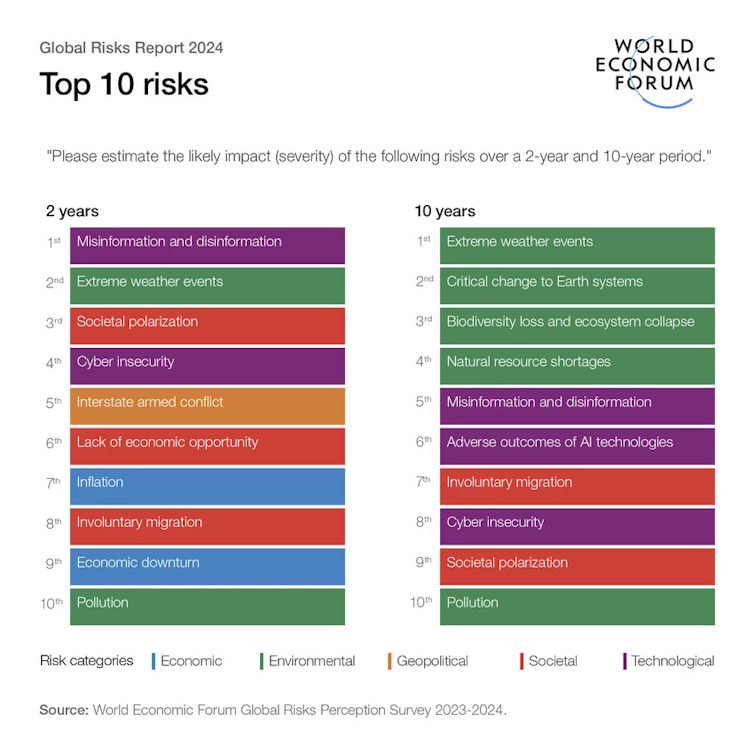
Because of this risk and the elections happening in the United States and around the world this year, engaging in healthy scepticism about what you see online is a must.
As is being thoughtful about where you get your news and information from. Doing so makes you better equipped to participate in a democracy, and less likely to fall for scams.![]()
T.J. Thomson, Senior Lecturer in Visual Communication & Digital Media, RMIT University
This article is republished from The Conversation under a Creative Commons license. Read the original article.
Congratulations!
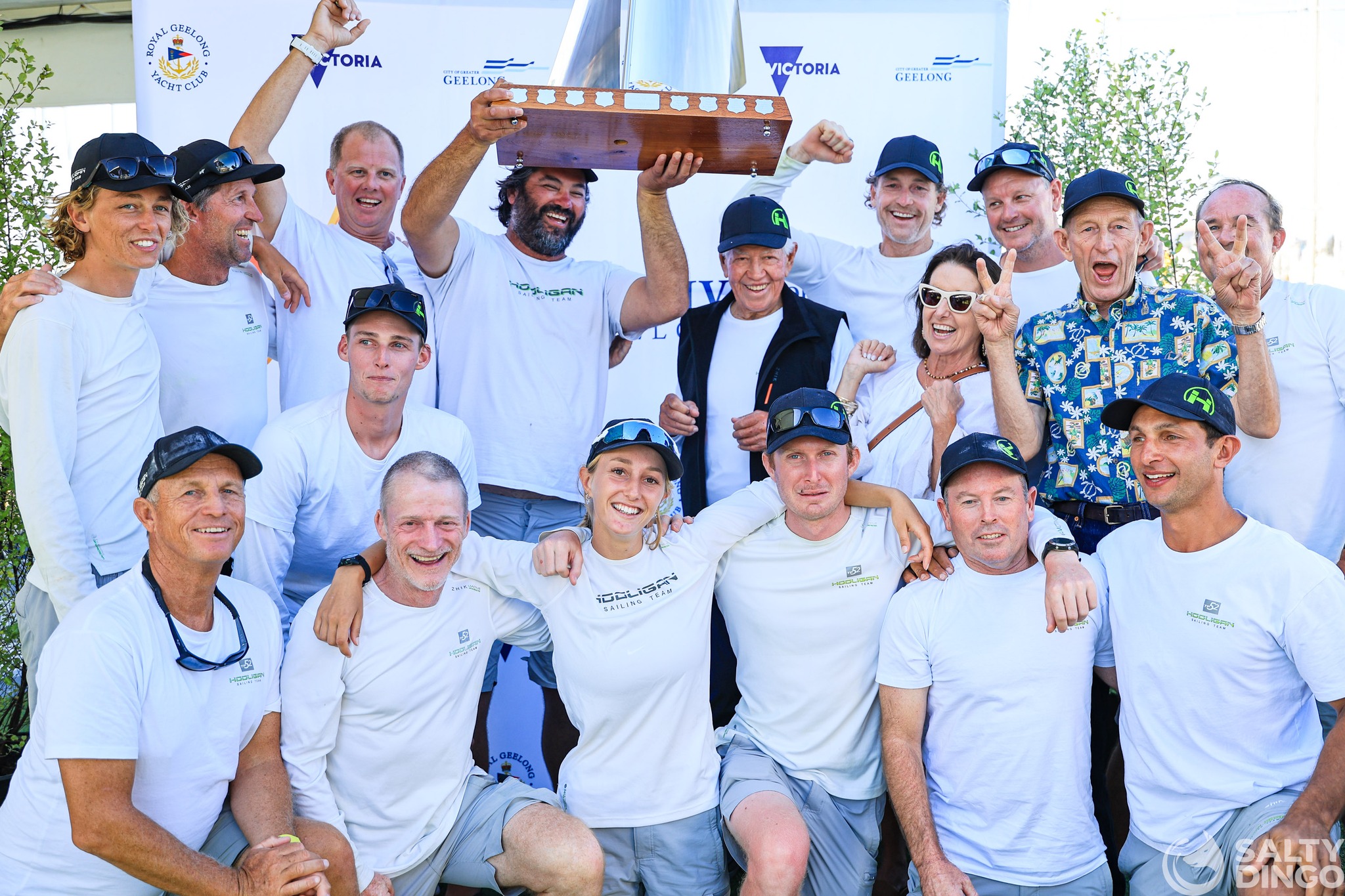

No Fresh Fruit, Stockpiled Petrol, Insurance Not Hugs: Experiences Of The Cost-Of-Living Crisis
Superannuation In Retirement Consultation: Federal Government
- Supporting members to navigate the retirement income system,
- Supporting funds to deliver better retirement income products and services, and
- Making lifetime income products more accessible.
Medicare turns 40: since 1984 our health needs have changed but the system hasn’t. 3 reforms to update it

Forty years ago, Medicare as we know it today was born. It was the reincarnation of the Whitlam government’s Medibank, introduced in 1975 but dismantled in stages by the Fraser Liberal government.
Medibank was developed in the 1960s by health economists Dick Scotton and John Deeble, when disease prevalence was different and the politics of reform were diabolical.
But the nation has changed since 1984, and so have our health needs. Medicare is now struggling to ensure the access to health care for millions of Australians we were once promised.
Let’s look at how we got here – and three radical changes we need to keep the Medicare promise into the future: making it cheaper to see a GP; paying less for blood and imaging tests; and covering dental care.
Free Hospital Care, But You Might Pay To See A GP
One of my first jobs in the health system, in the days before Medicare and Medibank, was acting in charge of revenue collection for three public hospitals. A small subset of people could get free, albeit stigmatised, care.
We had bad debts, because some people couldn’t afford to pay their hospital bills and I was allowed by policy to recommend that some be written off. But for others I had to seek court authorisation to seize their wages to pay off their hospital debt.
Medibank changed that. Now all Australians can get public hospital care without any financial barrier.

But the financial barriers to seeing a GP or a private specialist (out of hospital) have remained. Doctors continue to charge what they like, with Medicare often only covering a portion of their fees. This has left many patients facing significant out-of-pocket payments.
When Medicare was designed, medical care was provided mostly by solo medical practitioners working in practices they owned. It was a one-to-one professional relationship, with the patient paying the practitioner for each service.
Over time, general practice evolved into group practices organised as partnerships. Next, they consolidated and corporatised. A handful of corporates now provide all private pathology (which tests blood and other tissues) and radiology (which provides imaging services) and a large proportion of GP care.
Corporates have not made the same inroads into most other specialties. But since the 1980s, states have reduced public hospital outpatient services. So patients are now more reliant on private medical specialists for care referred by their GP.
Much Has Changed, But Cost Of Living Pressures Remain
Health-care needs have changed. As we live longer, we live with more diseases, many of which are chronic. The care required increasingly involves many different health providers and includes non-medical specialties such as podiatry, physiotherapy and psychology.
When Medicare was introduced, university education was offered for only a few of these professions. But their training has evolved and so too what they can do. This is particularly the case for nursing. It has evolved from an apprenticeship model to a profession with its own specialties. A subset – nurse practitioners – have the authority to diagnose and prescribe medication.
Broader technology trends have also had an impact on health care, as with all other sectors. Virtual care and telehealth proved their worth during the early years of the COVID pandemic, just as generative AI is beginning to show its promise now.
Medicare was first and foremost about efficiently removing financial barriers to access. It was introduced as part of an agreement with the Labor movement about reducing costs of living and, in particular, ensuring people could attend a doctor without having to worry about how they would pay for the visit.
However, about 1.2 million Australians deferred or missed out on seeing a GP because of cost in the 2022-23 financial year. Lower-income Australians have higher rates of missing out on care.
Medical fees aren’t regulated and so consumers face a lottery – not knowing whether a fee will be charged and having no control over that decision. Only about 52% of all Australians were always bulk-billed in 2022-23, down from 66% a year earlier.
So how can we get Medicare back on track towards its goal of universal health care for all Australians? Here are three radical reforms we should prioritise.
1. Make GP Care Affordable For All
Rebates are currently subject to political whim. The Liberal government (in office from 2013 to 2022) froze rebates, leading to increases in average out-of-pocket payments and reduced bulk-billing.
The first step in reducing costs as a barrier to GP care should be introduction of independent fee-setting.
Canadian Medicare – which was the model for Australia’s system – mostly has no out-of-pocket payments. Fees are set by negotiations, not politicians’ whims, and this is enshrined in legislation.
With independent fee-setting in place, a new scheme of “participating providers” should be introduced. Under such a scheme, practices would bulk-bill everyone, and participate in agreed quality-improvement programs.
If fees are set independently and fairly, extra billing over and above the fee is unjustifiable. Non-participating practices would not be eligible for Medicare benefits.
It’s anticipated the vast majority of practices would agree to participate. In Canada, the participation rate is roughly 100%, and bulk billing in Australia is still over 75%.
Participating practices should also be eligible for additional grants to employ other health professionals to provide a more comprehensive range of services – such as physiotherapists and psychologists – to meet the contemporary needs of a population with increasing chronic illness.
If successful, these changes would mean all Australians can access a GP and other primary care services without any out-of-pocket costs.
2. Deal With Diagnostics

Despite the evolution of ownership and market structures, pathology and radiology services are still reimbursed by fees for each service (with complex rules about rebates when multiple tests are performed simultaneously).
But while both industries are expensive to set up and buy or lease equipment, the cost of processing an additional test or image is low and sometimes close to zero. This means Medicare pays pathology and radiology providers much more than the tests or images cost.
Both industries are also ripe for further technological change, with the quality of generative AI rapidly improving, and costs likely to further reduce.
The uncapped fee-for-service model for pathology and radiology needs to be replaced by one in which the benefits of technological change are shared between shareholders and taxpayers, rather than all accruing to the former.
This could be done by replacing fee-for-service payments with a payment model used in the corporate world. Private and public providers could be invited to tender to provide these services in certain areas, with conditions around geographic access, quality and no out-of-pocket payments for consumers.
The same model could also apply to other technology-intensive types of health care, such as radiotherapy for cancer.
These changes might be cost-neutral for government, and save consumers the $24 they currently pay out of pocket on every pathology test that is not currently bulk-billed and $122 on each non-bulk-billed diagnostic imaging test.
3. Cover Dental Care Too

A major omission from Medicare from the start, and a source of continuing inequity, is oral health care. More than two million Australians missed out on oral health care because of cost in 2022-23.
A new scheme to slowly expand universal protection against the costs of oral health care should be phased in over the next decade. This would eventually mean all preventive and basic dental care would be available for everyone, with no out-of-pocket payments.
This would require a parallel expansion of the oral health workforce (dentists and oral health therapists) and development of new payment models based on a participating practice model rather than simply introducing another unregulated schedule of oral health fees paid via Medicare.
Innovation needs to be built into the Australian health system. However, the foundations for innovation must be based on Medicare’s founding principles of addressing financial barriers to provide universal and equitable health care to all Australians. ![]()
Stephen Duckett, Honorary Enterprise Professor, School of Population and Global Health, and Department of General Practice, The University of Melbourne
This article is republished from The Conversation under a Creative Commons license. Read the original article.
Alzheimer’s may have once spread from person to person, but the risk of that happening today is incredibly low

An article published this week in the prestigious journal Nature Medicine documents what is believed to be the first evidence that Alzheimer’s disease can be transmitted from person to person.
The finding arose from long-term follow up of patients who received human growth hormone (hGH) that was taken from brain tissue of deceased donors.
Preparations of donated hGH were used in medicine to treat a variety of conditions from 1959 onwards – including in Australia from the mid 60s.
The practice stopped in 1985 when it was discovered around 200 patients worldwide who had received these donations went on to develop Creuztfeldt-Jakob disease (CJD), which causes a rapidly progressive dementia. This is an otherwise extremely rare condition, affecting roughly one person in a million.
What’s CJD Got To Do With Alzehimer’s?
CJD is caused by prions: infective particles that are neither bacterial or viral, but consist of abnormally folded proteins that can be transmitted from cell to cell.
Other prion diseases include kuru, a dementia seen in New Guinea tribespeople caused by eating human tissue, scrapie (a disease of sheep) and variant CJD or bovine spongiform encephalopathy, otherwise known as mad cow disease. This raised public health concerns over the eating of beef products in the United Kingdom in the 1980s.
Human Growth Hormone Used To Come From Donated Organs
Human growth hormone (hGH) is produced in the brain by the pituitary gland. Treatments were originally prepared from purified human pituitary tissue.
But because the amount of hGH contained in a single gland is extremely small, any single dose given to any one patient could contain material from around 16,000 donated glands.
An average course of hGH treatment lasts around four years, so the chances of receiving contaminated material – even for a very rare condition such as CJD – became quite high for such people.
hGH is now manufactured synthetically in a laboratory, rather than from human tissue. So this particular mode of CJD transmission is no longer a risk.
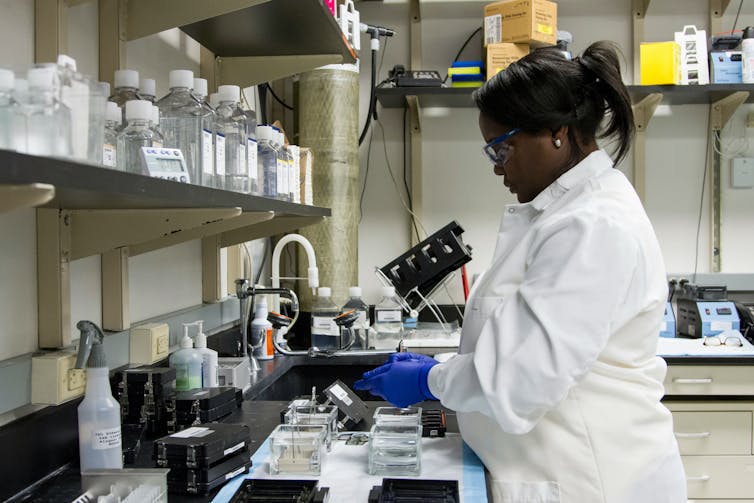
What Are The Latest Findings About Alzheimer’s Disease?
The Nature Medicine paper provides the first evidence that transmission of Alzheimer’s disease can occur via human-to-human transmission.
The authors examined the outcomes of people who received donated hGH until 1985. They found five such recipients had developed early-onset Alzheimer’s disease.
They considered other explanations for the findings but concluded donated hGH was the likely cause.
Given Alzheimer’s disease is a much more common illness than CJD, the authors presume those who received donated hGH before 1985 may be at higher risk of developing Alzheimer’s disease.
Alzheimer’s disease is caused by presence of two abnormally folded proteins: amyloid and tau. There is increasing evidence these proteins spread in the brain in a similar way to prion diseases. So the mode of transmission the authors propose is certainly plausible.
However, given the amyloid protein deposits in the brain at least 20 years before clinical Alzheimer’s disease develops, there is likely to be a considerable time lag before cases that might arise from the receipt of donated hGH become evident.
When Was This Process Used In Australia?
In Australia, donated pituitary material was used from 1967 to 1985 to treat people with short stature and infertility.
More than 2,000 people received such treatment. Four developed CJD, the last case identified in 1991. All four cases were likely linked to a single contaminated batch.
The risks of any other cases of CJD developing now in pituitary material recipients, so long after the occurrence of the last identified case in Australia, are considered to be incredibly small.
Early-onset Alzheimer’s disease (defined as occurring before the age of 65) is uncommon, accounting for around 5% of all cases. Below the age of 50 it’s rare and likely to have a genetic contribution.

The Risk Is Very Low – And You Can’t ‘Catch’ It Like A Virus
The Nature Medicine paper identified five cases which were diagnosed in people aged 38 to 55. This is more than could be expected by chance, but still very low in comparison to the total number of patients treated worldwide.
Although the long “incubation period” of Alzheimer’s disease may mean more similar cases may be identified in the future, the absolute risk remains very low. The main scientific interest of the article lies in the fact it’s first to demonstrate that Alzheimer’s disease can be transmitted from person to person in a similar way to prion diseases, rather than in any public health risk.
The authors were keen to emphasise, as I will, that Alzheimer’s cannot be contracted via contact with or providing care to people with Alzheimer’s disease.![]()
Steve Macfarlane, Head of Clinical Services, Dementia Support Australia, & Associate Professor of Psychiatry, Monash University
This article is republished from The Conversation under a Creative Commons license. Read the original article.
Eight Bells – Lang Walker AO
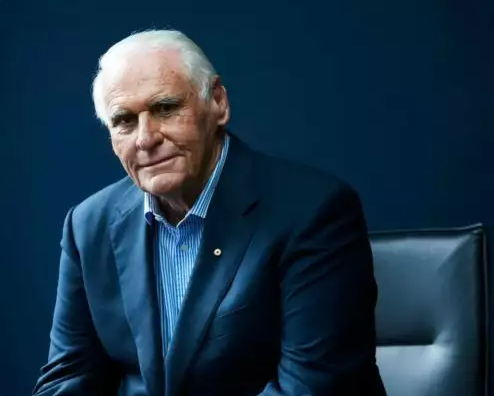
Advocacy Organisations For Older People Release Aged Care Act Key Issues Paper
- Enforceable rights of older people that address the current power imbalance
- A robust, independent complaints system
- Transparency of timelines and funding
- Strong regulation and penalties for those found guilty of not upholding the rights of older people.
Supplies Of The Shingrix Vaccine
We are living in a ‘digital dark age’ – here’s how to protect your photos, videos and other data

If you have grown up with social media, chances are you have taken more photos in the last couple of decades than you will ever remember. When mobile phones suddenly became cameras too, social media turned into a community photo album, with memories kept online forever and ever. Or so we thought.
In 2019, MySpace lost 12 years’ worth of music and photos, affecting over 14 million artists and 50 million tracks. If Instagram or the entire internet suddenly disappeared, would you be able to access your precious memories?
We are living in a “digital dark age”, a term popularised by information and communication specialist Terry Kuny. Back in 1997, Kuny warned we were “moving into an era where much of what we know today, much of what is coded and written electronically, will be lost forever”.
He argued that, like monks from the Middle Ages who preserved books (and therefore, knowledge), we must preserve digital objects of today. Otherwise, future generations will be left with gaps in knowledge about our present-day lives.

This article is part of Quarter Life, a series about issues affecting those of us in our twenties and thirties. From the challenges of beginning a career and taking care of our mental health, to the excitement of starting a family, adopting a pet or just making friends as an adult. The articles in this series explore the questions and bring answers as we navigate this turbulent period of life.
You may be interested in:
Instapoetry is successful and there’s nothing wrong with that
People often say the “internet is forever”, but digital artefacts like photos and videos are actually unstable and non-permanent. You’ve likely encountered “linkrot”, when a URL to an important source leads to a now-deleted webpage. Hardware becomes obsolete, degraded and upgraded over time. Bit-rot (also called data or file rot, or data degradation) means we may have no physical means to access our past data.
Many people already find it hard to use technology and software that has reached its “end of life”. With the lack of backwards compatibility (when updated technology or software cannot support older versions), how will future generations access old data stored in obsolete formats?
We are also seeing issues emerge related to ownership of data, particularly when controlled by private corporations. Families have faced legal difficulties accessing the social media accounts of deceased loved ones. Similarly, if Spotify or Netflix shut down tomorrow, you wouldn’t own any of the songs or films you stream on a daily basis.
A Digital Life
For a number of reasons, you may not even notice that we are in the middle of a new digital dark age.
From Google smart homes to contact-tracing technology, life is increasingly digital. Without an app, internet or social media account, it is difficult to verify your identity and gain access to data – even your own. Many people don’t even consider non-digital means of recording, proving and living their existence.
With Instagram stories disappearing after 24 hours, and Snapchat and WhatsApp’s vanishing messages features, you are probably used to data disappearing instantly.
With the growing need for environmental sustainability, turning to digital formats seems like the responsible solution to reducing our carbon footprint – though have you thought about the e-waste you produce?
Even with data protection laws now giving people the right to have personal data erased, many may not want their data to be preserved forever. Identity theft can occur with social media content that reveals biometric or other personal data. And that’s not to mention cyberstalking, cyberbullying, the distribution of “revenge porn” and online grooming.
But despite all these very understandable concerns, there are still good reasons to think seriously about how you preserve the digital artefacts and data that are most important to you.

Protecting And Preserving Your Old Data
If you misplaced your phone, could you remember important phone numbers, or navigate streets when lost? If the answer is no, you may want to think more carefully about data preservation.
This is something we should all think about, and not just leave it to digital archivists and preservationists. When organised efforts are made to preserve data, who decides what should be preserved can become a political issue as much as a technological one.
When it comes to your own digital memories, there are services you can use and steps you can take to preserve data from being lost to history:
Keep multiple copies (and formats) of important data across different devices: SD cards, USB thumb drives, DVD/Blu-ray discs, external hard drives and NAS (network attached storage) boxes. This has to be coupled with ensuring you regularly migrate important data to the newest device or format (remember, avoid bit-rot).
Try (re)discovering analogue trends – board games alongside video games, vinyl records over streaming music, or celebrate the resurgence of Polaroid cameras. Many services are available to convert digital photos into printed photos, albums and physical artwork.
Embrace the ethos of the FAIR principles) – findable, accessible, interoperable, and reusable– so that you and others can locate and access any important data you wish to preserve easily.
Finally, if you come across a rotten link or other missing data, you can explore data preservation initiatives like the Long Now Foundation’s publicly accessible Rosetta Project or the Internet Archive, a non-profit library of free digital books, movies, software, music and websites.

Esperanza Miyake, Chancellor's Fellow - Journalism, Media and Communication, University of Strathclyde
This article is republished from The Conversation under a Creative Commons license. Read the original article.
Early humans reached northwest Europe 45,000 years ago, new research shows

The period between 50,000 to 40,000 years ago saw a crucial biological and cultural transformation for humans: this was the time when local groups of Neanderthals were replaced by incoming groups of our own species, Homo sapiens.
The exact reasons behind this replacement are still poorly understood, but recent advances in archaeological and biomolecular science – combined with new archaeological discoveries – have provided illuminating new insights into the northward dispersal of early groups of Homo sapiens.
Our research – published today in Nature – has used these new techniques to the fullest, opening a new chapter in our understanding of how modern humans came to inhabit northwestern Europe.
Ranis: A Stone Age Mystery?
In the 1930s, at the site of Ilsenhöhle in Ranis (Thuringia, Germany), Werner M. Hülle uncovered a wealth of archaeological materials, including stone tools linked to the transition between the Middle Palaeolithic (Neanderthal) and Upper Palaeolithic (Homo sapiens). This stone tool industry – known as the Lincombian-Ranisian-Jerzmanowician (LRJ) – can be traced across central and northwest Europe, from Czechia to Britain.
Hülle was not able to identify human remains in the LRJ layers at Ranis. Poor bone preservation at many other LRJ sites meant there was strong debate about whether these tools had been made by Neanderthals or early Homo sapiens.
Our team re-excavated the Ranis site from 2016 to 2022. This was done by an international research group, led by Jean-Jacques Hublin, Shannon McPherron, Tim Schüler and Marcel Weiss. Over the course of our work, we successfully located the trenches from Hülle’s excavation, and found remaining LRJ deposits at a depth of nearly 8 metres.
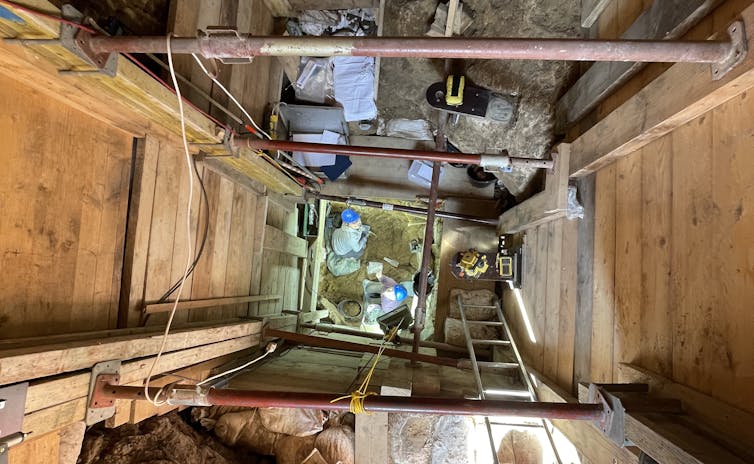
Identifying Ancient Human Remains
Around 1,800 bone fragments were recovered thanks to the new excavation. However, heavy fragmentation meant that only around 10% of the LRJ bone material could be identified to species. To increase the identification rate, we sampled previously unidentifiable bone fragments from both new and old excavations, and used new proteomic methods (analysing ancient proteins) to provide further species identifications.
It was a welcome surprise when we identified human remains, from both our new excavations and those from the 1930s: for the first time, human remains had been securely identified from an LRJ layer. Further visual assessment of the 1930s bone fragments brought the total number of identified human fragments up to thirteen.
Ancient DNA analysis identified all of these human fragments as Homo sapiens. A series of direct radiocarbon dates then securely placed them around 45,000 years ago.
Early Humans As Climate-Resilient Hunters
These human fossils were found alongside bone remains from reindeer, bison, woolly rhinoceros, arctic fox, wolf and wolverine, suggesting an extremely cold environment. This was confirmed by temperature estimates obtained by looking at oxygen isotopes on horse teeth, suggesting sub-arctic, tundra-like climate conditions similar to modern day northwestern Russia.
While some animal bones had clear traces of being butchered by humans, a lot of the material showed clear signs of being consumed by hyenas. Both archaeological analysis and data extracted directly from human remains show a diet based on large herbivores – especially reindeer and horse – with a focus on highly nutritious bone marrow. We also identified cut marks on carnivores, including wolves, suggesting that their furs were used to combat the cold.
We were also able to compare our species identifications on bone with those identified in ancient sediment DNA samples. By doing this, we found an increase in carnivore DNA in layers with more herbivore remains and material that had been consumed by carnivores. Overall, it is clear that the Ranis cave was used intermittently by hyenas, hibernating bears, and small, pioneer groups of climate-resilient Homo sapiens.
New Understandings Of Early Human Presence In Northwest Europe
Our work marks a significant shift in the understanding of Homo sapiens‘ initial incursions into the plains of northwestern Europe 47,500 years ago, which took place under severely cold climatic conditions. Moving in small groups, they shared their environment and sites with large carnivores, such as hyenas, and manufactured finely made stone points.
The brief use of the Ranis cave by small groups of Homo sapiens contrasts with evidence from the same period of their longer and more intensive presence at Bacho Kiro Cave in Bulgaria. This shows that we are only beginning to understand the settlement dynamics of the earliest dispersals of Homo sapiens into Europe, as well as their interactions with groups of local Neanderthals.
With a new suite of analytical tools at our disposal, and with large quantities of bone material available to study – both from new excavations and existing museum collections – we are now entering a new and exciting phase of archaeological research into the coexistence of our species with Neanderthals.![]()
Geoffrey Smith, Researcher, University of Kent; Dorothea Mylopotamitaki, Doctorante, Centre interdisciplinaire de recherche en biologie (CIRB), Collège de France; Karen Ruebens, Researcher, Paléaoanthropologie, CIRB, Collège de France, and Marcel Weiss, , Friedrich-Alexander-Universität Erlangen-Nürnberg
This article is republished from The Conversation under a Creative Commons license. Read the original article.
Playing a musical instrument or singing in a choir may boost your brain – new study
Michael Hornberger, University of East AngliaGenerations of parents have told their children to practice their musical instruments. Parents have good reason to keep on top of their children’s musical education, since learning an instrument is not only associated with better educational attainment but also cognition (thinking) and even intelligence scores in children. But does this musicality translate to better cognition later in life?
A recent study in the International Journal of Geriatric Psychiatry investigated this question by asking middle-aged and older people to complete a questionnaire on their lifetime musical experience before completing cognitive (thinking) tests. The results showed that musical people had better memory and executive function (the ability to stay focused on tasks, plan and have self-control) than those with less or no musicality.
A good memory is important for playing a musical instrument, such as playing music from memory, and this seems to translate to people’s cognitive performance. Similarly, executive function is required when playing an instrument, and this too translated to improved cognitive performance.
This finding was similar, regardless of which instrument people played or the level of musical proficiency people acquired – although most people in the study played an instrument for only a few years of their lives.
What made a difference, however, was whether people still played an instrument or only played in the past, with current amateur musicians showing the highest cognitive performance of participants.
This makes sense as continued engagement in cognitively stimulating activities, such as playing an instrument, should result in continued brain health benefits, whereas having played the recorder for three years at primary school might not have that big an impact on our cognitive performance later in life. But how about being musical without playing an instrument?
Singing is a very popular musical activity as it allows joining musical groups, such as choirs, without the need to learn a musical instrument. But does singing provide the same cognitive benefit as playing an instrument?
According to the study findings, singing can result in better executive function but not memory, suggesting that playing an instrument has additional brain health benefits.
Why singing would help us with our executive function is not clear and requires further investigation. However, singing has a strong social benefit when done in choirs, and there is good evidence that being engaged in social activity is good for our brain health.
The ‘Mozart Effect’
How about just listening to music? Does it also improve our cognition and potentially brain health?
Many people might remember the famous “Mozart effect”, which was based on a study published in Nature in 1993 showing that when students were played Mozart, they scored higher on intelligence tests.
This led to a whole industry promising us that playing such music to ourselves or even our babies could lead to cognitive benefits, even though the evidence for the original study is still controversially discussed to this day.

Sadly, the current study found no association between listening to music and cognitive performance. Cognitive stimulation depends on us being actively engaged in activities, so passively listening to music doesn’t seem to provide any cognitive benefits.
Playing an instrument or singing seems to have benefits to our brain health in ageing, according to the study. What is yet to be established is whether this would also help prevent future cognitive decline or dementia.
The study provides no evidence for this yet and it is also not clear how the findings apply to the general population, since most people in the study were female, well-educated and well-off.
Still, considering the overall cognitive and social benefits of learning an instrument or singing in a choir, it might be worth engaging in such cognitive stimulation as we age. Our parents would be proud of us.![]()
Michael Hornberger, Professor of Applied Dementia Research, University of East Anglia
This article is republished from The Conversation under a Creative Commons license. Read the original article.
Homes NSW To Rebuild The Social And Affordable Housing System In NSW
- turbocharge and streamline the building and maintenance of all publicly owned and operated social homes across NSW.
- simplify and fix tenancy services, including maintenance, support, allocation of properties and transfers to improve outcomes for tenants and the tenant experience.
- focus on providing important homelessness services, with the goal of creating a state where experiences of homelessness are rare, brief, and not repeated.
- drive collaboration between the NSW Government, the Federal Government, sector experts and peak bodies, local councils, and Community Housing Providers to work closer together than ever before to address the state’s housing and homelessness crisis. This work will include:
- ensuring NSW is in the best position to make use of the $10 billion Housing Australia Future Fund that provides funding to create thousands of new social and affordable homes across the state
- bringing the housing maintenance call centre back into public hands – a once-in-a-generation opportunity to overhaul the way maintenance is administered across the state's social housing properties and slash unnecessary bureaucracy
- addressing the rising number of rough sleepers in NSW by better incorporating homelessness services and a clear commitment to the principles of housing first – you can’t solve homelessness if you don’t have homes for people to live in.
- the creation of a pilot project for 3 sites at North Parramatta, whereby the NSW Government put to tender the search for a Community Housing Provider as a development partner, a process that mirrors one of the ways we will partner with CHPs in NSW for the HAFF
- immediate use of the Federal Government’s Social Housing Accelerator Fund, which has already seen hundreds of vacant homes refurbished and brought back online
- a state-wide audit of public and crown land to find surplus land that can be used to deliver much-needed homes for those in need
- significant planning reforms to cut through red tape at both local and state levels to slash delays and get the construction industry moving and building homes for people in need.
5 questions your child’s school should be able to answer about bullying

As children return to classrooms for 2024, school communities will be confronting bullying in person and via technology.
In-person bullying and cyberbullying affect significant numbers of children and young people in Australia and around the world.
The eSafety Commission recently revealed a 40% jump in cyberbullying reports. In 2023, it received 2,383 reports of cyberbullying compared with 1,700 in 2022. Two-thirds (67%) of reports concerned children aged 12–15 years.
A 2019 headspace survey found 53% of young Australians aged 12–25 have experienced cyberbullying.
A 2016 survey of 12- and 13-year-olds found seven in ten children had experienced at least one bullying-like behaviour within the past year.
Schools have a responsibility to provide a safe learning environment. As part of our work on bullying, we have identified five key ways schools can prevent and respond to bullying.
What Is Bullying?
In-person bullying is unwanted, negative and aggressive behaviour. It is done on purpose and done repeatedly, and can cause physical, emotional or social harm.
As the eSafety Commission explains, cyberbullying occurs
when someone uses the internet to be mean to a child or young person so they feel bad or upset.
It can happen on a social media site, game or app. It can include comments, messages, images, videos and emails.
There is a lot of overlap between the two types of bullying. Those who bully or are bullied in person also tend to bully or be bullied online, and vice versa.
In any kind of bullying, the person doing the bullying has – or is perceived to have – more power than the person being bullied.
What Do Schools Need To Do?
As the Australian Human Rights Commission notes, bullying is an abuse of individuals’ human rights. It says schools have a responsibility to provide a safe learning environment free from violence, harassment and bullying. This protects the right to education.
Approaches vary between jurisdictions and school systems. In Victoria, for example, government schools need to have bullying prevention policies. In New South Wales, government schools need to have an “anti-bullying plan”.
But while schools often have bullying policies, they need comprehensive systems to be adequately prepared.
Our Research
Our work has examined what schools should do to be prepared to prevent and respond to bullying. As part of this, we spoke to five principals and teachers at five Victorian schools in 2022.
This highlighted the ongoing and complex nature of the challenges schools face. For example, they told us how COVID set back responses to cyberbullying. As one high school principal told us:
We had a lot of online bullying going on […] a lot of nasty stuff happening online, a lot of sexting and a lot of horrible comments […] We nearly got it wiped out and then COVID hit and we then went back to having kids on computers all day, every day, so I think that’s back in a big way.
Technological change also means new challenges keep emerging. As a primary school teacher said:
[students are now] getting Apple Watches and so we’re having to rewrite policy to deal with that.
What Should Schools Do To Be Prepared?
We have also reviewed Australian and international evidence on bullying. Here we distil this work into five key questions to ask your child’s school.
1. Do they have good data? The school should regularly collect, review and act on data about social relationships in the school community. These should include levels of trust, support, empathy and kindness between students and between students and teachers/staff. This tells the school whether students feel safe and supported to raise social problems if they arise.

2. Do they seek students’ ideas? The school should ask students how the school can better prevent and respond to bullying. It should also consider and act on these suggestions. Actively involving children and young people in issues that concern them is a basic human right. It also results in policies and practices that are more likely to be appropriate for them.
3. Do people know about “gateway behaviours”? All school staff and students should be trained to identify and immediately report “gateway behaviours”. Examples include posting embarrassing photos online, ignoring particular students, name-calling, whispering about people in front of them, and eye-rolling. Gateway behaviours are not in and of themselves considered bullying, but when left unchecked, can escalate into bullying.
4. Do students think bullying is being reported? The school should also ask students whether they believe students and staff report all or almost all bullying they observe. It is also important to know whether students think reporting will remain anonymous and be acted on and positively resolved. This indicates whether students believe the school takes bullying seriously and feel empowered to come forward if they need to.
5. Does the school have “safety and comfort plans”? These are created for specific students immediately after they are identified as having been a victim of bullying. They should be designed by the student and a staff member together. This is to ensure they feel comforted and safe at school.
We know bullying can have devastating physical and psychological impacts on children. It can lead to issues including school refusal, poor self-esteem and poor mental health. This is why it is so important schools are properly equipped to not just handle incidents of bullying when they arise, but try and prevent them in the first place.
If this article has raised issues for you, or if you’re concerned about someone you know, call Lifeline on 13 11 14, Kids Helpline on 1800 55 1800 or contact headspace.![]()
Nina Van Dyke, Principal Research Fellow and Associate Director, Mitchell Institute, Victoria University and Fiona MacDonald, Principal Research Fellow, Institute for Sustainable Industries and Liveable Cities, Victoria University
This article is republished from The Conversation under a Creative Commons license. Read the original article.
E-scooters are linked with injuries and hospital visits – but we can’t say they are riskier than bikes yet
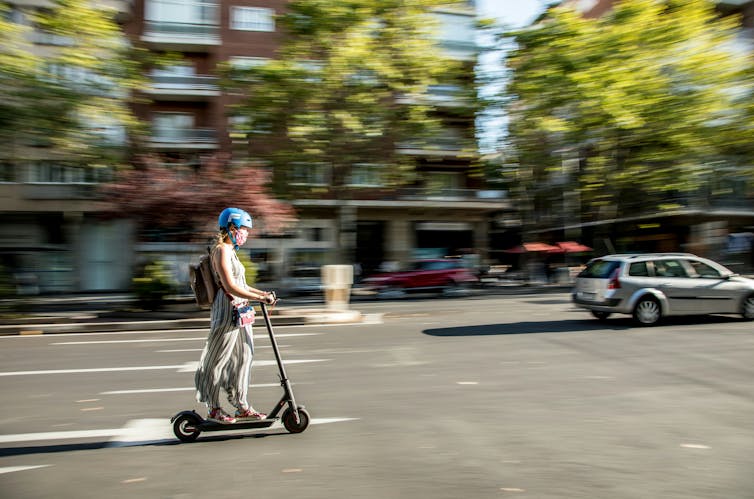
E-scooters are a popular new feature of urban mobility, offering an eco-friendly solution with zero exhaust emissions and agility in city spaces. They make an attractive option for “last-mile” commuting — bridging the gap between public transport and final destinations.
Tourists like them, too, as a convenient way to explore new cities.
Launched in Singapore in 2016, the global electric scooter market is valued at more than US$33.18 billion (A$49 billion) and is growing each year by around 10%.
More than 600 cities globally have embraced e-scooter sharing programs, yet reactions to these micro-mobility vehicles vary, making them a contentious urban planning issue.
Cities such as San Francisco and Madrid initially banned e-scooters, citing safety and public space concerns, but later introduced regulations for their use. Paris conducted a referendum, resulting in an e-scooter ban.
In Australia, the response has been more welcoming, though regulations differ across states and territories. What do we know about how safe e-scooters are? And what can we learn from other cities?
More E-Scooters Means More Injuries
The growing popularity of e-scooters worldwide, including in Australian cities, has been mirrored by a significant rise in related injuries and hospital admissions.
Most of these incidents involve males in their late 20s or early 30s, commonly sustaining head, face and limb injuries. There is consistently low helmet use in those injured. Also, about 30% of people who go to hospital with e-scooter injuries have elevated blood alcohol levels. Crashes involving riders under the influence of alcohol are associated with more severe head and face injuries.
A study examining data from the Royal Melbourne Hospital reported 256 e-scooter-related injuries in the year to January 2023 – including nine pedestrians – with a total hospitalisation cost of A$1.9 million.
In Queensland, e-scooter-related presentations to hospitals rose from 279 in 2019 to 877 in 2022. By September of 2023, this figure had already reached 801 (full-year figures weren’t available yet). Similar trends are seen in almost every city that has introduced e-scooters.
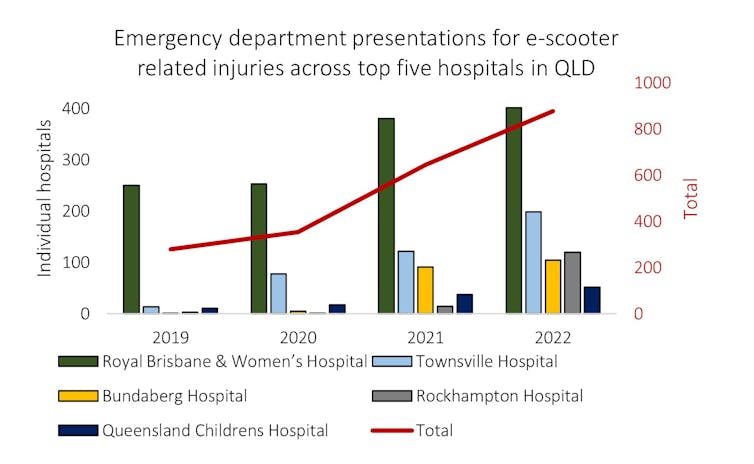
But Are E-Scooters Riskier Than Other Transport?
All modes of transport come with inherent safety risks. While trauma patient records in Western Australia show an almost 200% annual increase between 2017 and 2022 in e-scooter related admissions, these figures still remain well below those for cyclist injuries.
We need to understand the relative risk of e-scooters – a newcomer to the mobility market – and compare it to other established forms of transport. A proper assessment also considers exposure – the total number of trips and the distance covered.
A study in the United Kingdom, incorporating exposure factors using data from an e-scooter rideshare operator and hospital admissions combined, indicates that although hospital presentations increased during the e-scooter trial period, the injury rate was comparable to that of bicycles.
But it might be a different story when it comes to the severity of injuries. Some studies suggest a higher incidence of severe trauma among e-scooter users compared to cyclists. One study of more than 5,000 patients treated at a major trauma centre in Paris found that, while the mortality rate from e-scooter crashes wasn’t higher than that of bicycles or motorbikes, the risk of severe traumatic brain injuries was slightly higher than bicycles (26% compared to 22%).
There is evidence e-scooter riders tend to engage in significantly more risky behaviour than cyclists. Compared to injured bicyclists, those injured while riding e-scooters:
- tend to be younger
- are more frequently found to be intoxicated
- exhibit a lower rate of helmet use
- and are more commonly involved in accidents at night or on weekends.
We Can Make Them Safer
Mitigating safety risks of e-scooters requires consistent regulation, stricter enforcement of rules, and user education about safe scootering. This includes restrictions on usage times, rider age restrictions, mobile phone and headphone use, riding under the influence of drugs or alcohol, speed limits, helmet use and carrying passengers.
The cooperation of e-scooter companies is crucial in enhancing safety. They could curb risky behaviours and enforce the rules. This could be done with simple devices to make scooters automatically stick within speed limits, sobriety tests before operation or detecting and preventing tandem riding. More advanced options could include technology to require helmet use for scooter activation.
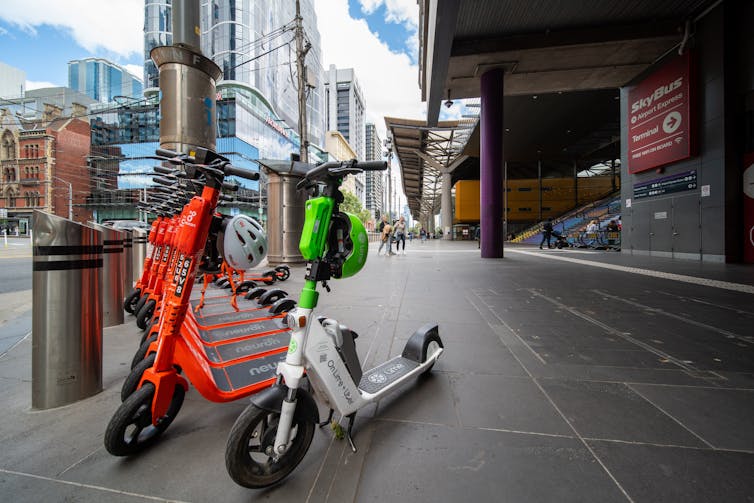
Safety In Numbers
Data on the total number of rides and coverage, as well as recording of accidents, is needed. Access to this detailed information would offer a clearer understanding of the actual accident and injury risks associated with e-scooters than the news headlines.
And let’s not overlook the “safety in numbers” effect. In the world of urban mobility, e-scooters are currently “the small fish in a big pond”. As the demand for e-scooters grows, they may find their place in our city planning and infrastructure design.
Across Europe cities with limited cycling infrastructure have seen the largest increase in e-scooter accidents. Cities with lots of bike lanes showed no significant effect.
The path to safer e-scootering might lie in the development of more friendly infrastructure. As the ridership grows, safety investments should follow, and that can make the future of e-scootering less risky for everyone.![]()
Milad Haghani, Senior Lecturer of Urban Mobility, Public Safety & Disaster Risk, UNSW Sydney and Clara Zwack, Lecturer in Physiotherapy, Swinburne University of Technology
This article is republished from The Conversation under a Creative Commons license. Read the original article.
Measles is on the rise around the world – we can’t let vaccination rates falter

In recent weeks a series of measles alerts have been issued around Australia, including in New South Wales, Victoria and Queensland, after the identification of a small number of cases in travellers returning from overseas.
Meanwhile, places such as the United States and the United Kingdom have been contending with larger measles outbreaks.
In fact, the World Health Organization reported a 45-fold increase in measles cases in Europe last year, with 42,200 cases recorded in 2023 compared to 941 in 2022.
In South Asia, India and Pakistan have also recently reported outbreaks.
So what’s the risk of a larger outbreak in Australia? Fortunately it’s likely to be quite low – but ensuring we continue to have high rates of vaccination coverage is crucial.
Remind Me – What Is Measles?
Measles is a highly infectious viral disease. It spreads through tiny droplets when an infected person coughs or sneezes. Measles is so contagious that if one infected person comes into contact with ten unvaccinated people, they can infect nine of them.
It can take around ten to 12 days for symptoms to appear after a person has been exposed to the virus. Although measles is characterised by a rash, symptoms are generally cold-like to begin with, including a fever, runny nose, fatigue, and sore or red eyes. The rash, which is not itchy, emerges two or three days later and spreads from the face down the body.
Sometimes measles can lead to secondary infections such as an ear infection, diarrhoea or pneumonia. In rare cases measles can cause encephalitis (inflammation of the brain).
In severe cases measles can lead to hospitalisation and death. We saw this in 2019 in the Pacific Island nation of Samoa. Out of 5,667 infections in a four-month period, 81 died, mostly young children.
Vaccination Works
Vaccination is the most effective strategy to protect against measles. Two doses of the MMR vaccine (given to children at 12 months and 18 months in Australia) provide protection against measles, mumps and rubella.
Babies under one year have natural protection from their mums that wears off gradually. Infants six to 11 months can be vaccinated if they will be travelling internationally, but will still need to take a further two doses.
Once vaccinated, the chance of getting measles is very low and you are considered protected for life.
However, about one in 100 people who are vaccinated may still contract measles if they’re exposed to the virus. Although it’s not entirely clear why this happens, the infection in a vaccinated person is generally mild.
Vaccination Rates Are Faltering
Globally, there has been a drop in childhood vaccinations over the course of the COVID pandemic. This is likely due to a range of factors including declining trust in vaccines, misinformation and disruptions to access.
In Europe, the proportion of children who received a first dose of the MMR vaccine dropped from 96% in 2019 to 93% in 2022, and from 93% to 91% for the second dose. This is important because about 95% vaccination coverage is needed to achieve herd immunity against measles. Under this scenario, those who are not vaccinated will be protected because the virus won’t spread.
In the UK, health authorities have expressed alarm at the number of children who have not been vaccinated, with reports up to almost half of children in parts of London have not received both shots.
As of September 2023, the Australian government reported immunisation rates across all childhood vaccinations of 93.26% for one-year-olds, 91.22% for two-year-olds, and 94.04% for five-year-olds. There are slight disparities between different states and territories and among some population groups.
Boosting Vaccination Coverage
While we appear to be quite close to the herd immunity threshold for measles and not in immediate danger of an outbreak, we still need to be vigilant.
Australia has an excellent outbreak surveillance in place in all states for infectious diseases including measles. But outbreaks are occurring globally, and are liable to take hold when people are unvaccinated or under-vaccinated. So we need to be alert in all states, increase surveillance at international transit points, and continue to increase immunisation coverage, especially among young children. Educating parents and the wider community about the importance of MMR vaccines is key.
It’s never too late to be vaccinated against measles if you missed out as a child, or are unsure if you’ve had two doses. As a single infected traveller can cause an outbreak, vaccination is particularly important if you travel frequently. If you’re unsure of your vaccination status, you can ask your GP or check your own or your children’s record through the Australian Immunisation Register.
If you suspect you or someone in your family is infected it’s important to stay isolated and contact your doctor. They will confirm the infection by referring you for a blood test and possibly a RT-PCR test.
The Australian department of health in collaboration with the Australian Academy of Science has developed a set of useful resources on measles which can assist travellers, the general public and health professionals.![]()
Jaya Dantas, Deputy Chair, Academic Board; Dean International, Faculty of Health Sciences and Professor of International Health, Curtin University
This article is republished from The Conversation under a Creative Commons license. Read the original article.
New Highly Infectious E. Coli Strain Resistant To Powerful Antibiotics
First-Ever Sighting Of A Live New-Born Great White: Footage May Help Solve Longstanding Mystery In Shark Science
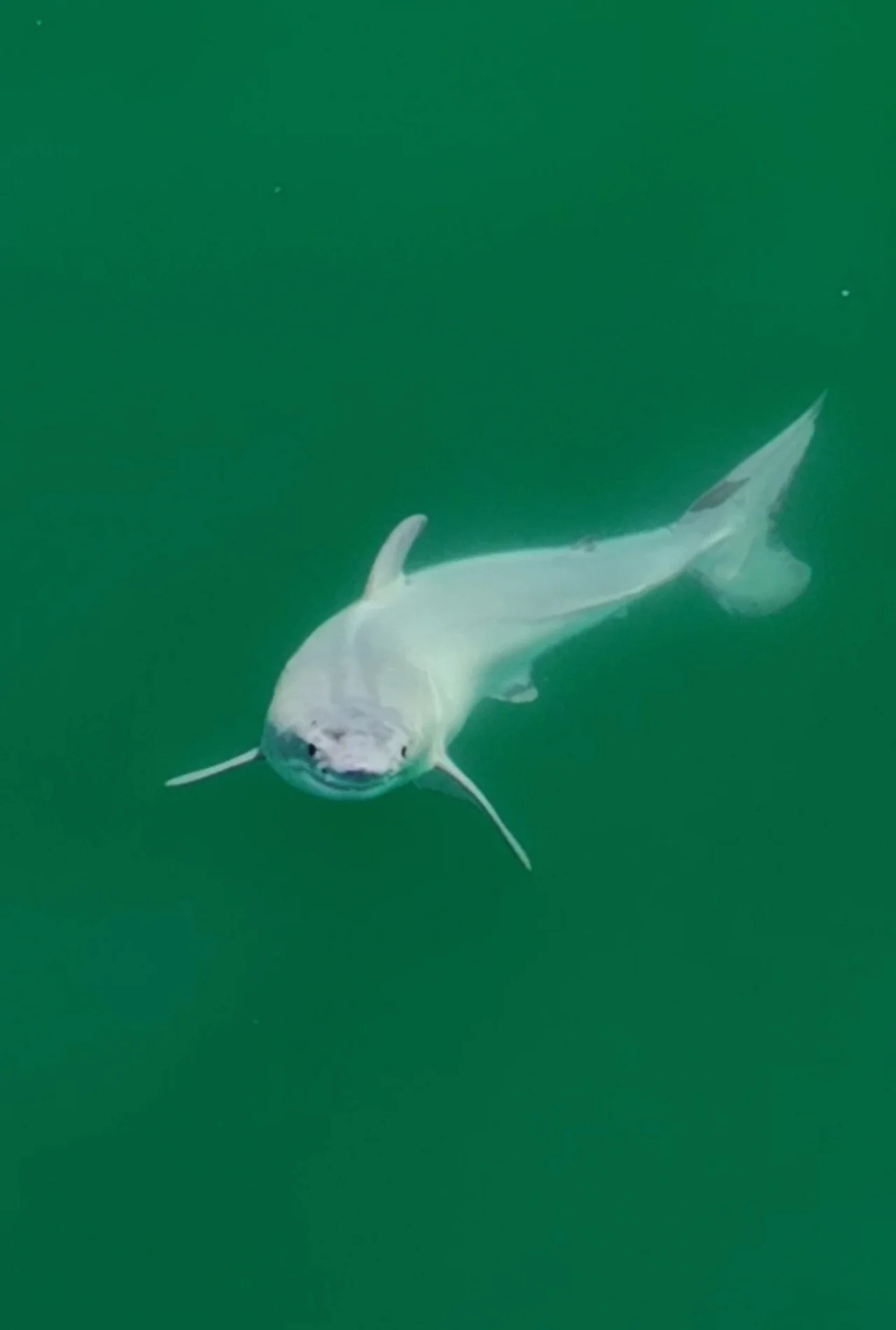
Australia is welcoming more migrants but they lack the skills to build more houses
Brendan Coates, Grattan Institute and Trent Wiltshire, Grattan InstituteAustralia has an acute shortage of housing. Renters across the country face steep rents rises and record-low vacancy rates.
At the same time, net overseas migration has surged to a record high of 518,100 in the past financial year as international students, working holiday-makers, and sponsored workers returned to Australia after our international borders reopened and fewer migrants departed.
The trouble is, very few migrants arriving in Australia come with the skills to build the extra homes we need.
Migrants Are Back But Lack Home Building Expertise
Migrants are less likely to work in construction than in most other industries. About 32% of Australian workers were foreign born, but only about 24% of workers in building and construction were born overseas.
And very few recent migrants work in construction. Migrants who arrived in Australia less than five years ago account for just 2.8% of the construction workforce, but account for 4.4% of all workers in Australia.
Most migrants who work in construction in Australia have been here for a long time. The largest migrant groups in construction are permanent skilled migrants (including their spouses and children), followed by New Zealand citizens (who can remain in Australia indefinitely on a temporary visa) and permanent family visa-holders (many of whom arrived in Australia long ago as the spouses of Australian citizens).
But among those migrant groups where we’re now seeing the biggest rebound in numbers – international students, international graduates and working holiday makers – relatively few work in construction. And just 0.5% of all construction workers are on a temporary skilled visa.
Changing this situation won’t be easy. After all, Australia rightly wants to attract highly skilled migrants who will make the biggest long-term contribution to the country.
That means selecting highly skilled migrants – mostly tertiary-trained professionals. However, the construction workforce is one of Australia’s least educated. Just 22% of Australia’s construction workforce hold a diploma-level qualification or higher – the least of any industry.
What The Government Should Do
But there are steps the federal government can take to make Australia more attractive to skilled trades workers who can help build the homes we desperately need.
First, the government should make it easier for employers to sponsor skilled trades workers to get a visa.
It should abolish labour-market testing and reduce sponsorship fees for the new “Core Skills” temporary sponsored visa stream – for skilled workers earning between A$70,000 and A$135,000 a year – to encourage more skilled trades workers to migrate to Australia.
The introduction of labour-market testing and extra fees like the Skilling Australians Fund Levy are big reasons why the number of visas granted to temporary sponsored workers in construction has fallen from more than 9,000 in 2011-12 to just 4,021 in 2022-23.
The government should also extend its new streamlined, high-wage “Specialist Skills Pathway” sponsored visa stream to skilled trades workers.
That pathway will be offered to workers who earn at least $135,000 a year. Visas will be approved in a median time of just seven days. Yet skilled trades workers earning more than $135,000 won’t qualify for the new streamlined pathway.
Second, the government should streamline the skills and occupational licensing process for skilled trades workers.
Currently, overseas qualified tradespeople must have their skills assessed separately to qualify for a skilled visa and to be granted a licence by a state or territory to practise their trade once in Australia.
The recent Parkinson Migration Review showed how that process can cost more than $9,000 for some skilled trades and take up to 18 months.
The Albanese government should work with states and territories to better align these processes. And it should pursue greater mutual recognition of qualifications and licences with other countries for skilled trades, as recommended recently by the Productivity Commission.
Migration offers big benefits to Australia. But we’d benefit even more if it provided more of the skilled workers we need to help fix the housing shortage.![]()
Brendan Coates, Program Director, Economic Policy, Grattan Institute and Trent Wiltshire, Deputy Program Director, Migration and Labour Markets, Grattan Institute
This article is republished from The Conversation under a Creative Commons license. Read the original article.
This salt alternative could help reduce blood pressure. So why are so few people using it?
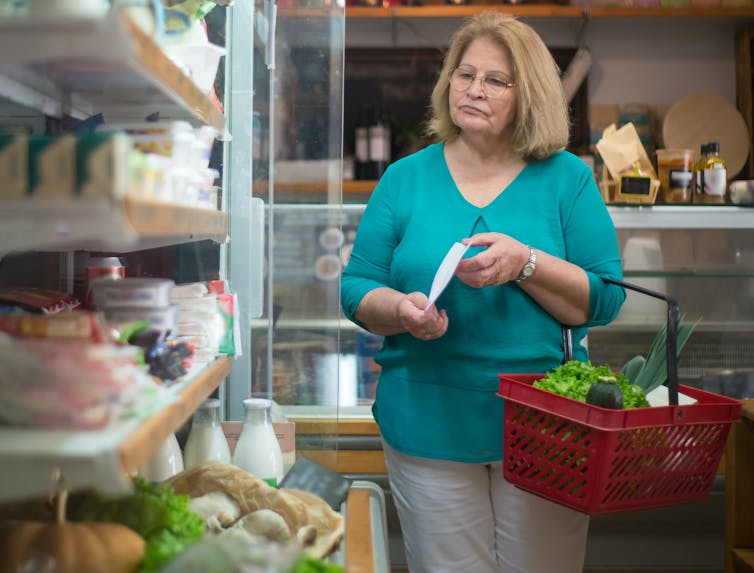
One in three Australian adults has high blood pressure (hypertension). Excess salt (sodium) increases the risk of high blood pressure so everyone with hypertension is advised to reduce salt in their diet.
But despite decades of strong recommendations we have failed to get Australians to cut their intake. It’s hard for people to change the way they cook, season their food differently, pick low-salt foods off the supermarket shelves and accept a less salty taste.
Now there is a simple and effective solution: potassium-enriched salt. It can be used just like regular salt and most people don’t notice any important difference in taste.
Switching to potassium-enriched salt is feasible in a way that cutting salt intake is not. Our new research concludes clinical guidelines for hypertension should give patients clear recommendations to switch.
What Is Potassium-Enriched Salt?
Potassium-enriched salts replace some of the sodium chloride that makes up regular salt with potassium chloride. They’re also called low-sodium salt, potassium salt, heart salt, mineral salt, or sodium-reduced salt.
Potassium chloride looks the same as sodium chloride and tastes very similar.
Potassium-enriched salt works to lower blood pressure not only because it reduces sodium intake but also because it increases potassium intake. Insufficient potassium, which mostly comes from fruit and vegetables, is another big cause of high blood pressure.
What Is The Evidence?
We have strong evidence from a randomised trial of 20,995 people that switching to potassium-enriched salt lowers blood pressure and reduces the risks of stroke, heart attacks and early death. The participants had a history of stroke or were 60 years of age or older and had high blood pressure.

An overview of 21 other studies suggests much of the world’s population could benefit from potassium-enriched salt.
The World Health Organisation’s 2023 global report on hypertension highlighted potassium-enriched salt as an “affordable strategy” to reduce blood pressure and prevent cardiovascular events such as strokes.
What Should Clinical Guidelines Say?
We teamed up with researchers from the United States, Australia, Japan, South Africa and India to review 32 clinical guidelines for managing high blood pressure across the world. Our findings are published today in the American Heart Association’s journal, Hypertension.
We found current guidelines don’t give clear and consistent advice on using potassium-enriched salt.
While many guidelines recommend increasing dietary potassium intake, and all refer to reducing sodium intake, only two guidelines – the Chinese and European – recommend using potassium-enriched salt.
To help guidelines reflect the latest evidence, we suggested specific wording which could be adopted in Australia and around the world:

Why Do So Few People Use It?
Most people are unaware of how much salt they eat or the health issues it can cause. Few people know a simple switch to potassium-enriched salt can help lower blood pressure and reduce the risk of a stroke and heart disease.
Limited availability is another challenge. Several Australian retailers stock potassium-enriched salt but there is usually only one brand available, and it is often on the bottom shelf or in a special food aisle.
Potassium-enriched salts also cost more than regular salt, though it’s still low cost compared to most other foods, and not as expensive as many fancy salts now available.

A 2021 review found potassium-enriched salts were marketed in only 47 countries and those were mostly high-income countries. Prices ranged from the same as regular salt to almost 15 times greater.
Even though generally more expensive, potassium-enriched salt has the potential to be highly cost effective for disease prevention.
Preventing Harm
A frequently raised concern about using potassium-enriched salt is the risk of high blood potassium levels (hyperkalemia) in the approximately 2% of the population with serious kidney disease.
People with serious kidney disease are already advised to avoid regular salt and to avoid foods high in potassium.
No harm from potassium-enriched salt has been recorded in any trial done to date, but all studies were done in a clinical setting with specific guidance for people with kidney disease.
Our current priority is to get people being managed for hypertension to use potassium-enriched salt because health-care providers can advise against its use in people at risk of hyperkalemia.
In some countries, potassium-enriched salt is recommended to the entire community because the potential benefits are so large. A modelling study showed almost half a million strokes and heart attacks would be averted every year in China if the population switched to potassium-enriched salt.
What Will Happen Next?
In 2022, the health minister launched the National Hypertension Taskforce, which aims to improve blood pressure control rates from 32% to 70% by 2030 in Australia.
Potassium-enriched salt can play a key role in achieving this. We are working with the taskforce to update Australian hypertension management guidelines, and to promote the new guidelines to health professionals.
In parallel, we need potassium-enriched salt to be more accessible. We are engaging stakeholders to increase the availability of these products nationwide.
The world has already changed its salt supply once: from regular salt to iodised salt. Iodisation efforts began in the 1920s and took the best part of 100 years to achieve traction. Salt iodisation is a key public health achievement of the last century preventing goitre (a condition where your thyroid gland grows larger) and enhancing educational outcomes for millions of the poorest children in the world, as iodine is essential for normal growth and brain development.
The next switch to iodised and potassium-enriched salt offers at least the same potential for global health gains. But we need to make it happen in a fraction of the time.![]()
Xiaoyue Xu (Luna), Scientia Lecturer, UNSW Sydney; Alta Schutte, SHARP Professor of Cardiovascular Medicine, UNSW Sydney, and Bruce Neal, Executive Director, George Institute Australia, George Institute for Global Health
This article is republished from The Conversation under a Creative Commons license. Read the original article.
A new government inquiry will examine women’s pain and treatment. How and why is it different?
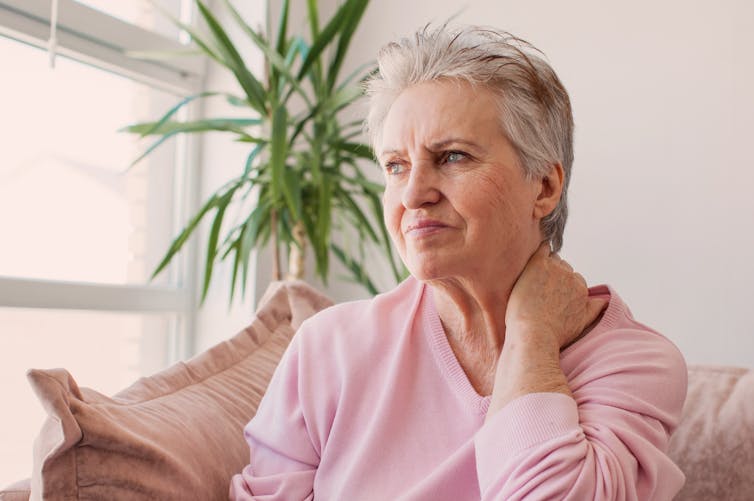
The Victorian government has announced an inquiry into women’s pain. Given women are disproportionately affected by pain, such a thorough investigation is long overdue.
The inquiry, the first of its kind in Australia and the first we’re aware of internationally, is expected to take a year. It aims to improve care and services for Victorian girls and women experiencing pain in the future.
The Gender Pain Gap
Globally, more women report chronic pain than men do. A survey of over 1,750 Victorian women found 40% are living with chronic pain.
Approximately half of chronic pain conditions have a higher prevalence in women compared to men, including low back pain and osteoarthritis. And female-specific pain conditions, such as endometriosis, are much more common than male-specific pain conditions such as chronic prostatitis/chronic pelvic pain syndrome.
These statistics are seen across the lifespan, with higher rates of chronic pain being reported in females as young as two years old. This discrepancy increases with age, with 28% of Australian women aged over 85 experiencing chronic pain compared to 18% of men.
It Feels Worse
Women also experience pain differently to men. There is some evidence to suggest that when diagnosed with the same condition, women are more likely to report higher pain scores than men.
Similarly, there is some evidence to suggest women are also more likely to report higher pain scores during experimental trials where the same painful pressure stimulus is applied to both women and men.
Pain is also more burdensome for women. Depression is twice as prevalent in women with chronic pain than men with chronic pain. Women are also more likely to report more health care use and be hospitalised due to their pain than men.

Medical Misogyny
Women in pain are viewed and treated differently to men. Women are more likely to be told their pain is psychological and dismissed as not being real or “all in their head”.
Hollywood actor Selma Blair recently shared her experience of having her symptoms repeatedly dismissed by doctors and put down to “menstrual issues”, before being diagnosed with multiple sclerosis in 2018.
It’s an experience familiar to many women in Australia, where medical misogyny still runs deep. Our research has repeatedly shown Australian women with pelvic pain are similarly dismissed, leading to lengthy diagnostic delays and serious impacts on their quality of life.
Misogyny Exists In Research Too
Historically, misogyny has also run deep in medical research, including pain research. Women have been viewed as smaller bodied men with different reproductive functions. As a result, most pre-clinical pain research has used male rodents as the default research subject. Some researchers say the menstrual cycle in female rodents adds additional variability and therefore uncertainty to experiments. And while variability due to the menstrual cycle may be true, it may be no greater than male-specific sources of variability (such as within-cage aggression and dominance) that can also influence research findings.
The exclusion of female subjects in pre-clinical studies has hindered our understanding of sex differences in pain and of response to treatment. Only recently have we begun to understand various genetic, neurochemical, and neuroimmune factors contribute to sex differences in pain prevalence and sensitivity. And sex differences exist in pain processing itself. For instance, in the spinal cord, male and female rodents process potentially painful stimuli through entirely different immune cells.
These differences have relevance for how pain should be treated in women, yet many of the existing pharmacological treatments for pain, including opioids, are largely or solely based upon research completed on male rodents.
When women seek care, their pain is also treated differently. Studies show women receive less pain medication after surgery compared to men. In fact, one study found while men were prescribed opioids after joint surgery, women were more likely to be prescribed antidepressants. In another study, women were more likely to receive sedatives for pain relief following surgery, while men were more likely to receive pain medication.
So, women are disproportionately affected by pain in terms of how common it is and sensitivity, but also in how their pain is viewed, treated, and even researched. Women continue to be excluded, dismissed, and receive sub-optimal care, and the recently announced inquiry aims to improve this.
What Will The Inquiry Involve?
Consumers, health-care professionals and health-care organisations will be invited to share their experiences of treatment services for women’s pain in Victoria as part of the year-long inquiry. These experiences will be used to describe the current service delivery system available to Victorian women with pain, and to plan more appropriate services to be delivered in the future.
Inquiry submissions are now open until March 12 2024. If you are a Victorian woman living with pain, or provide care to Victorian women with pain, we encourage you to submit.
The state has an excellent track record of improving women’s health in many areas, including heart, sexual, and reproductive health, but clearly, we have a way to go with women’s pain. We wait with bated breath to see the results of this much-needed investigation, and encourage other states and territories to take note of the findings.![]()
Jane Chalmers, Senior Lecturer in Pain Sciences, University of South Australia and Amelia Mardon, PhD Candidate, University of South Australia
This article is republished from The Conversation under a Creative Commons license. Read the original article.
Former Labor minister Greg Combet to succeed Peter Costello as chair of the Future Fund
Michelle Grattan, University of CanberraFormer Labor minister Greg Combet is to be the new chair of the Future Fund, replacing Peter Costello.
Combet, a member of parliament in 2007-2013, served in the industry and climate change and energy efficiency portfolios and in the Labor cabinet. Before entering parliament he was ACTU secretary.
The Future Fund is the country’s sovereign wealth fund, established by the Coalition government in 2006 to strengthen Australia’s financial position. It is Australia’s largest financial asset. At the end of last year it had $272 billion in assets under management.
It is responsible for a number of other sovereign wealth funds including the Medical Research Future Fund, the Aboriginal and Torres Strait Islander Land and Sea Future Fund, the Future Drought Fund, the Disaster Ready Fund, the DisabilityCare Australia Fund and the Housing Australia Future Fund.
Costello, who as treasurer set up the fund, served two terms as chair, and was on its board before that.
Last year Albanese government appointed Combet as chair of a Net Zero Economy Agency, a position he will soon quit before taking the fund chairmanship mid-year. His term is for five years.
Since leaving parliament Combet has been prominent in the superannuation industry. In 2018 he became chair of Industry Super Australia.
Announcing the appointment, Treasurer Jim Chalmers said Combet had “a distinguished career and extensive experience in investment and superannuation, government and the climate and energy transformation”.
He said Combet had served as Chair of IFM Investors, a Trustee of AustralianSuper and Superannuation Trust of Australia. He had broad experience as a non-executive director in the financial sector.
“He is the perfect appointment to take the Future Fund into the future,” Chalmers said
Mary Reemst becomes acting chair of the Future Fund until Combet takes over.
Chalmers also announced Nicola Wakefield Evans and Rosemary Vilgan as part-time members of the Fund’s board for five-year terms.
He said Wakefield Evans had extensive experience in capital markets, corporate finance, the energy sector and corporate law. She was a partner for more than 20 years at King & Wood Mallesons and served with the Clean Energy Finance Corporation.
Vilgan had a background in investment and a range of board experience; she is currently the Chair of Commonwealth Bank Officers Superannuation Corporation .
“These two new member appointments will increase the representation of women on the Future Fund and continue the government’s strong track record of appointing women to senior roles in Australia’s most important economic and financial institutions,” Chalmers said.
“The appointments will help refresh and renew the Fund and help maintain the high level of skills and experience on the Board.”![]()
Michelle Grattan, Professorial Fellow, University of Canberra
This article is republished from The Conversation under a Creative Commons license. Read the original article.
Disclaimer: These articles are not intended to provide medical advice, diagnosis or treatment. Views expressed here do not necessarily reflect those of Pittwater Online News or its staff.